Multiple terms: term1 term2
red apples
returns results with all terms like:
Fructose levels in red and green apples
Precise match in quotes: "term1 term2"
"red apples"
returns results matching exactly like:
Anthocyanin biosynthesis in red apples
Exclude a term with -: term1 -term2
apples -red
returns results containing apples but not red:
Malic acid in green apples
hits for "" in
Network problems
Server timeout
Invalid search term
Too many requests
MITM6
Natural and synthetic analogues of planets and small bodies materials can be produced and/or processed to simulate how their compositions and structures may evolve, and their chemical/physical properties can be measured. The results of these laboratory experiments are essential for the interpretations of measurements obtained by ground-based observations and space missions. They are also necessary for planning and preparing future in situ and sample-return space missions, ensuring their success in collecting valuable samples and data.
In this session, we invite submissions related to the analysis of cosmo-materials and to the production, evolution and analysis of planetary and small bodies analogues (interpretation of chemical/physical properties, predictions, preparation of analytical tools or space instruments, preparation of analytical chain for sample return analyses, etc.). Laboratory experiments necessary to interpret data of any past, present and future space missions will be particularly encouraged.
Session assets
Introduction: Dark surfaces, such as those found on planets asteroids and other primitive bodies, are the focus of past, present, and future space missions within the Solar System. Understanding the spectroscopic characteristics of these low albedo surfaces remains a significant challenge, with our current knowledge being incomplete. The presence of opaque materials [1] or surface processes like space weathering [2] or thermal alteration [3] often is linked with these dark surfaces. Interpreting remote sensing data necessitates intensive laboratory work, which serves as a pivotal tool in revealing the physical state and composition of these surfaces.
Analyzing complex mixtures of analogous materials remains one of the pivotal laboratory investigations to support remote sensing interpretation, but it also represents one of the most challenging experiments, in particular when multiple components are used in the mixtures. We present in this contribution several results from different works that share the common goal of studying how the mixing of different grain size and dark materials can affect the behavior of infrared spectra in the near- to mid-infrared range (1.25-25 μm).
Methods: In this presentation, two primary studies will be outlined: the initial investigation delves into the combination of hydrated and anhydrous mineral components with varying grain sizes [4], while the subsequent study examines the blending of basalts with dark components at different grain sizes [5]. Samples prepared for both studies utilize an innovative protocol for mixing two components with distinct grain sizes. This method involves a sequence of steps, including sieving and mineral washing to isolate each grain size, followed by the mixing of the selected components. This procedure allows us to produce unique samples with a bigger grain size covered by a selected amount of small grains (Figure 1).
In the first work, we prepared several mixtures using 1 wt% and 5 wt% of hyperfine grain size (< 10 μm) of hydrated minerals and 95 wt% and 99 wt% of larger grain size (200–500 μm) of anhydrous minerals. We measured the IR reflectance spectrum of these mixtures in the range 8000–400 cm−1 (1.25–25 μm). Analysis of the spectroscopic features was carried out independently in two separated ranges covered by our measurements, in the NIR range we focused on the presence of the hydrated band at 2.7 μm while in the MIR range we carried out an analysis of the most important spectroscopic features present. The second sample set includes four series of basaltic mix (feldspar and pyroxene), at different grain sizes from < 50 μm to 500-1000 μm, mixed with amorphous carbon at increasing weight percentages from 1% to 50%. We analyzed several features on the spectrum of each mineral mixture: (i) near infrared slope; (ii) 2.7 μm OH-stretching band; (iii) Christiansen features; (iv) Reststrahlen band and Transparency feature.
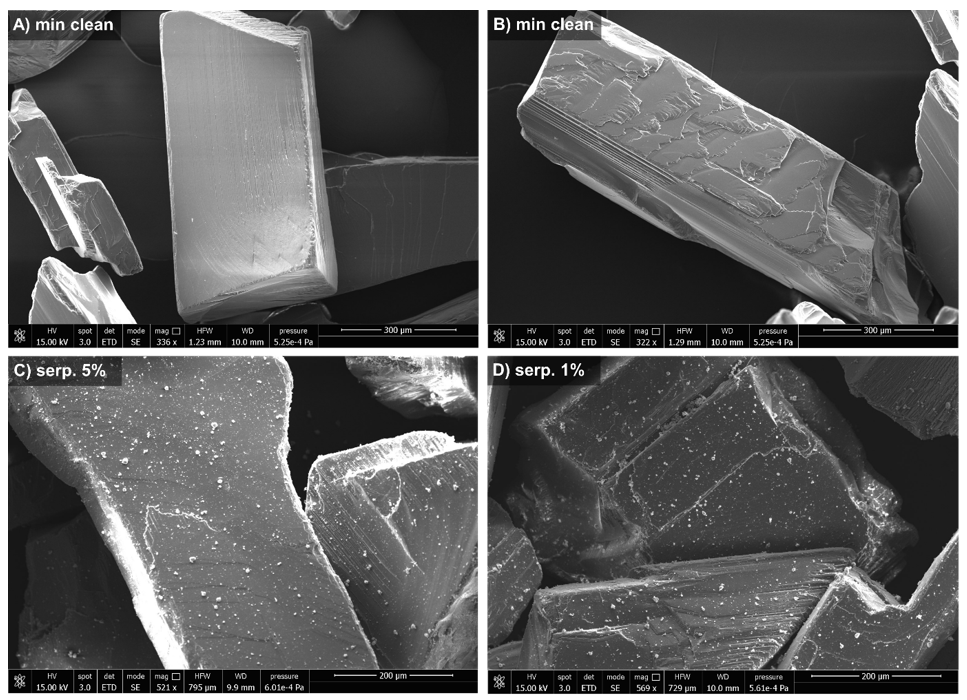
Figure 1. Secondary electrons SEM image of enstatite sample before (panel A and B) and after mixing with 5% and 1% of serpentine (panel C and D).
Results: The results of the first work [4] show how the addition of a hydrated component, which is minor in percentage and has a much smaller grain size, can lead to very remarkable changes in the NIR region especially in increasing the hydrated band depth at 2.7 μm (Figure 2), while slightly affecting the MIR region. The surface of many rocky bodies is covered with regolith, and these new laboratory data show how even a small amount of hydrated mineral in the composition can influence the final spectrum. Measurements presented in the second work [5] point towards a critical effect of dark material but with a different outcome for each grain size of the brighter component of the mixture (Figure 3). For the first time we investigate the spectral range from NIR to MIR. Some of the most interesting results involved the slope trend of modification with dark material, in particular we observed an inversion between reddening and bluing depending on the percentage of the mixture and the grain size. Moreover, we investigated also the different behavior of several features such as: hydrated band at 2.7 μm, the Reststrahlen band and Transparency feature.
Conclusion: Enhancing our comprehension of spectroscopic alterations resulting from minor fluctuations in mineral phases is crucial for accurately interpreting remote sensing data gathered from planetary surfaces by space missions. The dataset compiled from our experiments will serve as vital groundwork for interpreting forthcoming data from the JAXA Martian Moon eXploration mission. Additionally, it will aid in comprehending past data from dark surfaces within the Solar System, such as asteroids (162173) Ryugu and (101955) Bennu. Significant laboratory efforts are still required to effectively complement the analysis of remote sensing data, with numerous additional mixtures and combinations slated for investigation as a follow-up to this research. Further laboratory measurements will serve a dual purpose: expanding the database for interpreting planetary surfaces and furnishing reference spectra to enhance and validate current and future models.
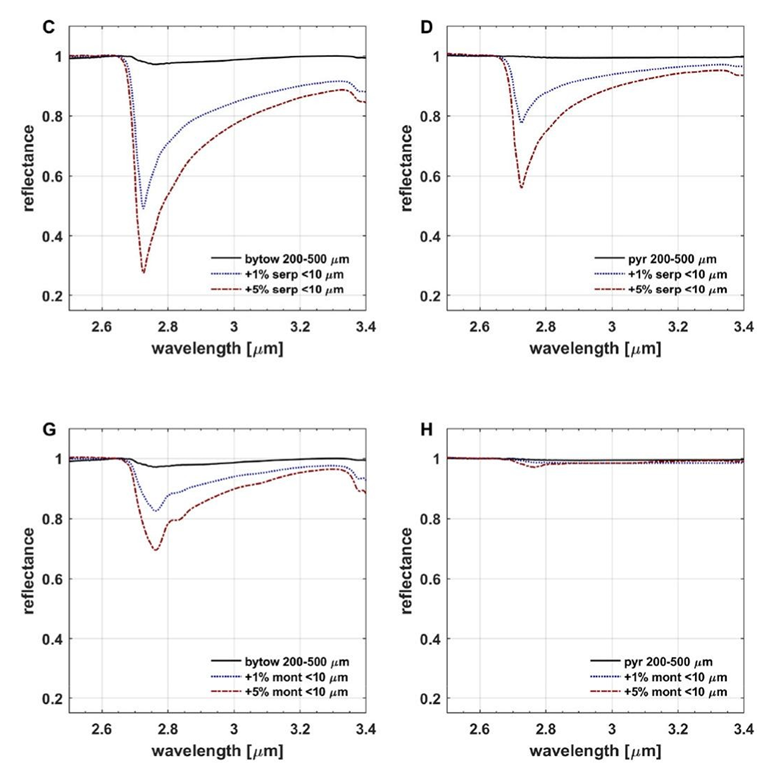
Figure 2. Detail of hydrated band around 2.7 μm for hydrated minerals serpentine (top panels) and montmorillonite (bottom panels) with grain size <10 μm mixed at 1 wt% (dotted blue line) and 5 wt% concentration (dash-dot red line) with: plagioclase bytownite (panels C, G) and iron sulfide pyrite (panels D, H). (Figure adapted from [4])
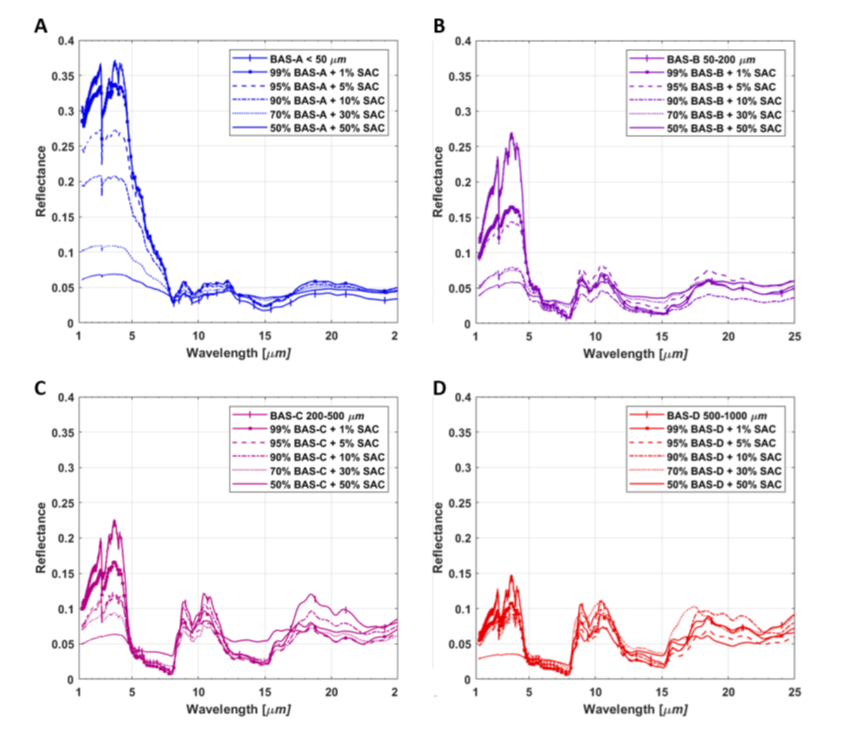
Figure 3. Infrared spectra of basaltic mixtures [BAS] at different grain sizes, <50, 50-200, 200-500 and 500-1000 μm, with addition in different proportions, from 1 to 50%, with synthetic amorphous carbon [SAC] (Figure from [5]).
Acknowledgments: Authors thank Nathalie Ruscassier for the help with the SEM images acquisition and analysis. G.P., M.A.B., A.D. and A.W. acknowledge support by Centre National d’Etudes Spatiales (CNES). L.F. and J.R.B. acknowledge support from Italian Space Agency ASI-INAF agreement 2022-1-HH.0.
References: [1] Cloutis E. et al. (1990) Icarus, 84 (2), 315-333 [2] Hasegawa et al. (2022), ApJ. Let-ters, 939, L9 [3] Lugassi, R, et al. (2015), Geoder-ma, 213, 268-279 [4] Poggiali G. et al. 2023a, Icarus, 394, 115449 [5] Poggiali G. et al. 2024, A&A 685, A14
How to cite: Poggiali, G., Wargnier, A., Fossi, L., Iannini Lelarge, S., Beccarelli, J., Brucato, J. R., Barucci, M. A., Pajola, M., Masotta, M., Matsuoka, M., Beck, P., Nakamura, T., Merlin, F., Fornasier, S., Gautier, T., and David, G.: Linking laboratory and remote sensing investigations: grain size and mineral mixing studies as pivotal tools to interpret solar system exploration., Europlanet Science Congress 2024, Berlin, Germany, 8–13 Sep 2024, EPSC2024-913, https://doi.org/10.5194/epsc2024-913, 2024.
Introduction:
The JAXA Martian Moon eXploration mission will be launched in 2026 toward the Martian moon Phobos. The MMX infrared spectrometer (MIRS, [1]) will observe Phobos within the 0.9 to 3.6 µm range to detect potential signatures of organics and hydrated minerals. The existence of such signatures may shed light on the unknown origin of Phobos. In close collaboration with CNES and other French and Japanese laboratories, the LESIA – Paris Observatory is responsible for the development of the MIRS instrument. Along with the instrument development, in support of future MIRS observations, we already performed laboratory experiments to search for a Phobos spectroscopic simulant [2,3,4] and study the effects of observation geometry [3,4,5]. It is well known that surface porosity is an extremely important parameter of small bodies' surfaces, influencing their physical, spectroscopic, and photometric properties. However, the effects of porosity remain ambiguously understood with studies giving conflicting results (e.g., [6,7,8]). A high porosity is suggested for Phobos, in particular, because of the very low thermal inertia associated with the presence of a possible 10 µm plateau in the MIR spectra of Phobos [9,10]. Moreover, as an airless body, Phobos also undergoes significant space weathering from solar wind, galactic cosmic rays, micrometeorites, and sputtering of heavy ions from the Martian atmosphere [11,12] due to its proximity to Mars, with the solar wind being likely the most influential process for Phobos surface (Fig. 1).
In this work, we investigate the spectroscopic and photometric modification of Phobos regolith simulants induced by these two parameters: (1) porosity and (2) solar wind space-weathering.
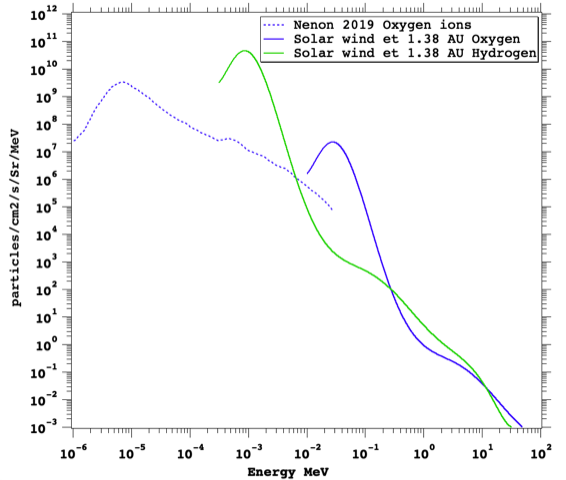
Figure 1: Flux density at Phobos' surface of oxygen ions produced in the upper layer of the Martian atmosphere, and of hydrogen and oxygen ions from the solar wind.
Method:
To accurately represent the surface of Phobos, several samples were selected, including two Phobos simulants [4,5], olivine, phyllosilicate (saponite), coals (anthracite, DECS-19 from the Penn State Coal Bank), and iron sulfide (troilite). In particular, hydrated minerals and organics are important for Phobos, as the detection of these components could provide pivotal clues to decipher the origins of Phobos.
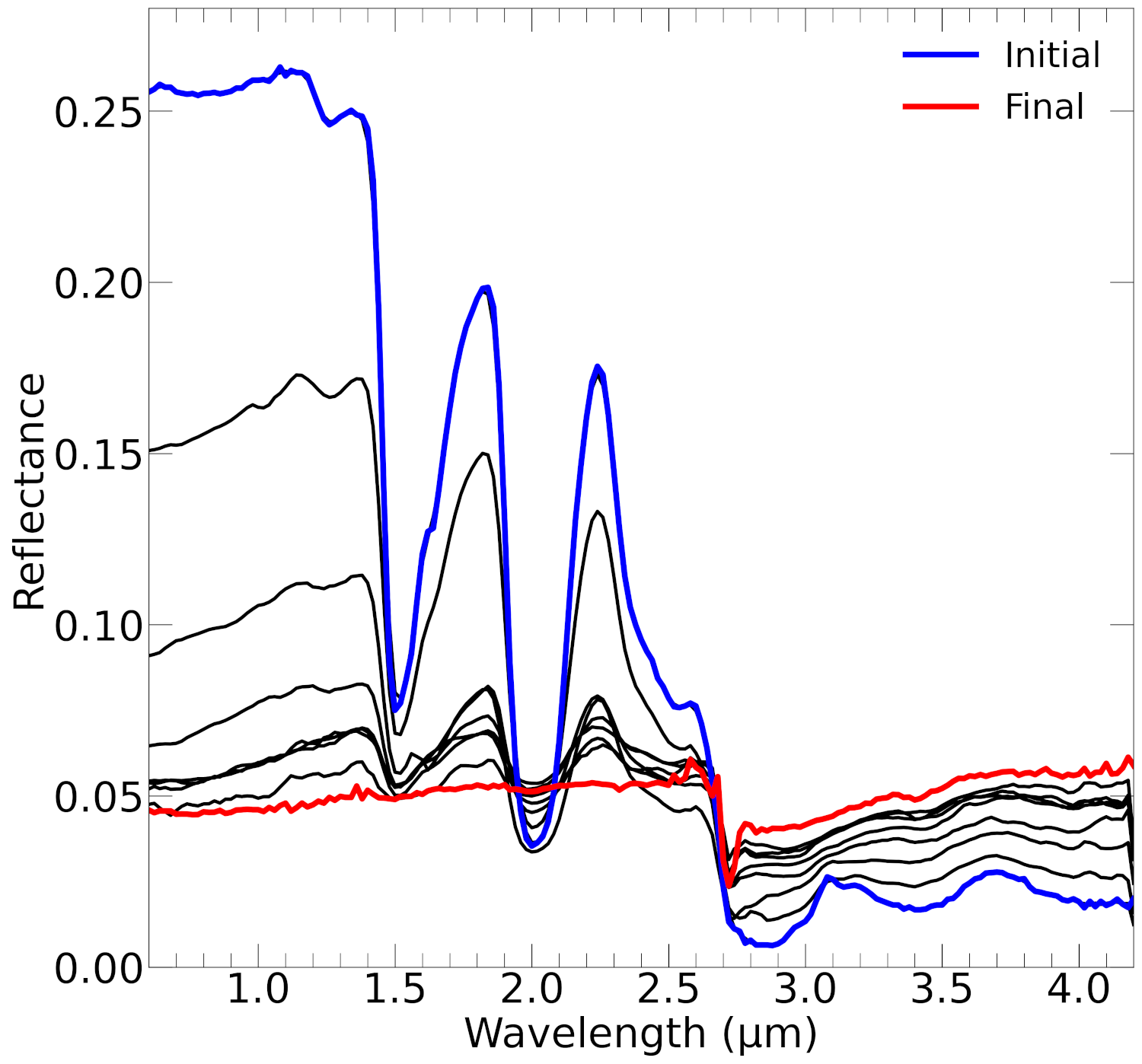
Figure 2: Evolution of a Phobos simulant during the sublimation experiment. The blue spectrum represents the initial spectrum and the red spectrum shows the final spectrum when the water ice is fully sublimated. One spectrum is taken every hour.
For the porosity effect study, porous Phobos simulants were created by sublimation of water ice mixed with grains (Fig. 2) of the Phobos simulants [14], resulting in a highly porous sublimation residue, as visible in Fig. 3. This study investigated the spectro-photometric variations induced by porosity using the SHADOWS spectro-goniometer [15] at IPAG (France) with spectroscopic measurements ranging from 0.4 to 3.6 µm. Additionally, mid-infrared (MIR) reflectance spectra (1.25 – 18 µm) were also obtained using the FTIR Bruker Vertex70v spectrometer. Our analysis in the MIR focuses on the modifications in shape and positional shifts of three key features for mineralogical interpretation: the Christiansen feature, the Restrahlen band, and the transparency feature.
For the space-weathering effect, we will present preliminary results on the irradiation of samples with 140 keV He and Ar ions with the ARIBE beamline at GANIL (France) to reproduce the effects of solar wind that reach and alter the Phobos’ surface. The use of two ions allows to explore different regimes of deposited dose.
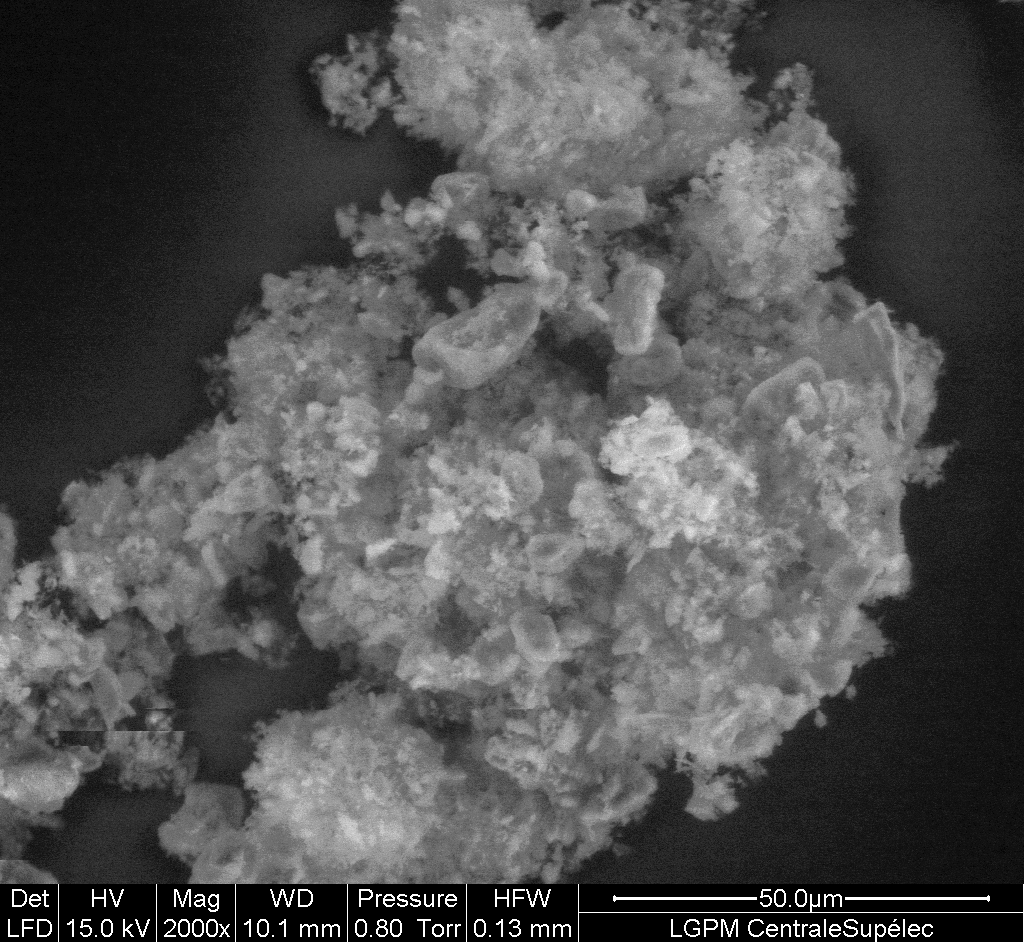
Figure 3: SEM image of a porous sublimation residue of the UTPS-TB Phobos simulant.
Results:
Our results on porosity indicate that the spectrum samples tend to exhibit a bluing of its spectral slope in the visible and near-infrared after increasing porosity (Fig. 4). This spectral slope difference between a compact and porous sample may explain the difference between the blue and red unit on Phobos. In the mid-infrared range, the Christiansen feature is modified and the emissivity peak is larger for porous samples, leading to the formation of a 10 µm-plateau in the spectra of porous samples (Fig. 4). The study of the photometric properties reveals that porous samples exhibit a reduced single-scattering albedo and a slightly broader lobe that predominantly back-scattered, as for the compact samples, but with a higher contribution of forward scattering. The derivation of the Hapke parameters shows an increase in roughness for the porous sample, as expected by the macro-roughness visible on optical microscope images; but no modification of the opposition effect in contrast to what might have been expected with the modification of the surface texture. Additionally, phase reddening varies between compact and porous samples, suggesting it as an additional valuable observable for MIRS.
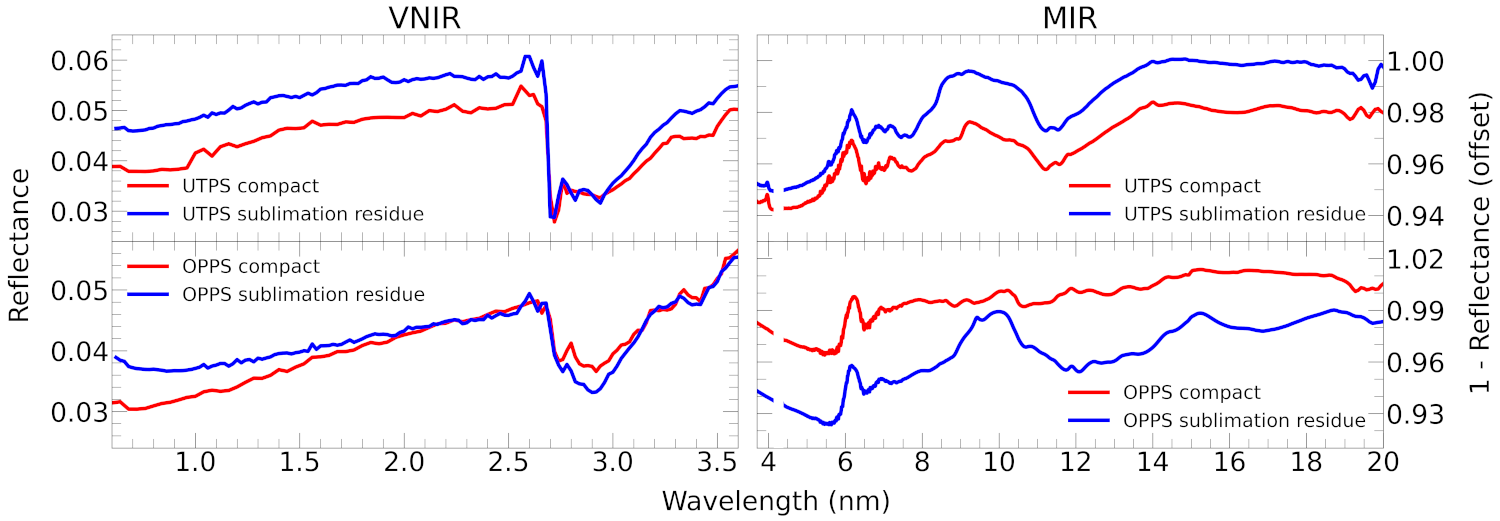
Figure 4: VNIR and MIR spectra of UTPS and OPPS before and after the sublimation experiment.
Conclusion:
This study gives novel and unique insights into the spectroscopic effects of porosity and solar wind on the regolith layer of Phobos, in the context of the upcoming JAXA/MMX mission, with interesting applications to the surfaces of other airless bodies. We will present, for the first time, the impacts of ion irradiation on the photometric properties of Phobos’ regolith, improving our understanding of space weathering processes.
Acknowledgments: The authors acknowledge the Centre National d’Etudes Spatiales (CNES) for the continuous support.
References: [1] Barucci et al. (2021), EPS, 73, 211 [2] Wargnier et al (2023a), A&A, 669 [3] Wargnier et al. (2023b), MNRAS, 524, 3 [4] Wargnier et al., submitted to Icarus (10.48550/arXiv.2405.02999) [5] Miyamoto et al. (2021), EPS, 73, 214 [6] Näränen et al. (2004), A&A, 426 [7] Hapke (2021), Icarus, 354 [8] Shepard and Helfenstein (2007), JGR, 112 [9] Giuranna et al. (2011), PSS, 59, 13 [10] Glotch et al. (2018), JGR, 123, 10 [11] Nénon et al. (2019), JGR, 124, 12 [12] Nénon et al. (2021), Nature Geoscience, 14, 2 [13] Quirico et al. (2023), Icarus, 394 [14] Poch et al. (2016), Icarus, 267 [15] Potin et al. (2018), AO, 57, 28
How to cite: Wargnier, A., Gautier, T., Poggiali, G., Poch, O., Moingeon, A., Quirico, E., Beck, P., Caminiti, E., and Doressoundiram, A.: Effects of porosity and space-weathering on the spectroscopic and photometric properties of Phobos simulants, Europlanet Science Congress 2024, Berlin, Germany, 8–13 Sep 2024, EPSC2024-917, https://doi.org/10.5194/epsc2024-917, 2024.
Introduction
Carbonate minerals are ubiquitous on Earth, on all terrestrial planets and on many satellites and small bodies, in particular asteroids. These minerals are identified through remote sensing using either visible and near infrared reflectance spectroscopy but also since recently Raman spectroscopy. These techniques, as well as mid-infrared spectroscopy, are also very frequently used in the laboratory to identify the various anhydrous, hydroxylated and hydrated carbonates phases.
In this talk we first report on an extensive ongoing experimental study of all types of carbonates by Visible, near and mir infrared and Raman spectroscopy of series of natural and synthetic samples, coupled with DRX and EPMA analysis to determine their mineralogical purity and their effective composition. We will focus here on the anhydrous calcite and dolomite groups including most of the rhombohedral carbonates.
In the second part we report on the detailed analysis of their spectra in order to finely determine the band positions, width and intensity of the bands as a function of composition (Ca, Mg. Fe, …). We also provide a vibration mode attribution to all the bands. Coupled with an exhaustive compilation and a critical review of the literature on the spectroscopic properties of these carbonates, this allows us to build accurate band list data to be ingested in the new band list database of the SSHADE database infrastructure (www.sshade.eu). These absorption and Raman spectral information for individual minerals as well as for solid solutions (e.g. the magnesite-siderite solid solution) are invaluable for the community, and are a type of information still critically missing to easily interpret laboratory, field or astronomical spectra.
Carbonate samples
A large set of samples (over 100) covering the anhydrous calcite and dolomite groups and including most of the rhombohedral carbonates (calcite, dolomite, ankerite, magnesite, siderite, rhodochrosite, smithsonite, sphaerocobaltite, kutnohorite, otavite and gaspeite) has been collected for this study. Most of the samples are of natural origin with a variety of composition, but a few pure minerals have been synthesized at ISTerre laboratory to complete the set, especially some hard-to-find natural end-members. They come from various sources, from the OSUG collection, from dealers and local collectors as well as from personal field collection in the mountain ranges around Grenoble. For the reflectance spectra part of the mineral have been grinded and sieved to either <25 µm, <50 µm or 50-100 µm size fractions. Selected grains (~1 mm) of each minerals have been also embedded in *** pellets and polished for EPMA and Raman measurements.
Spectroscopic experiments
Four series of spectroscopic experiments have been performed on various spectrometers.
- Raman emission microspectroscopy at a spatial scale of 1 micron were recorded on raw minerals, but also on selected grains embedded in pellets. We used 2 different instruments located at ENS-Lyon or ISTerre-Grenoble laboratories. Most spectra have been recorded with 1 cm-1 resolution over the 50-1800 cm-1
- Visible and near-infrared reflectance spectroscopy of raw mineral surfaces and mineral powders (mostly <25 µm and 25-100 µm fractions) in the range 400-4650 using our SHINE spectro-gonio radiometer. Measurements have been performed in standard geometry (nadir incidence, 30° observation) with a spectral sampling of 4 to 8 nm above.
- Mid-infrared reflectance spectroscopy of mineral powders (mostly the <25 µm fraction) in the range 500-7000 cm-1 using our FTIR Brucker 70 spectrometer equipped with a bidirectional attachment. Measurements have been performed in standard geometry at 1 cm-1 spectral resolution. The spot size is about 4 mm.
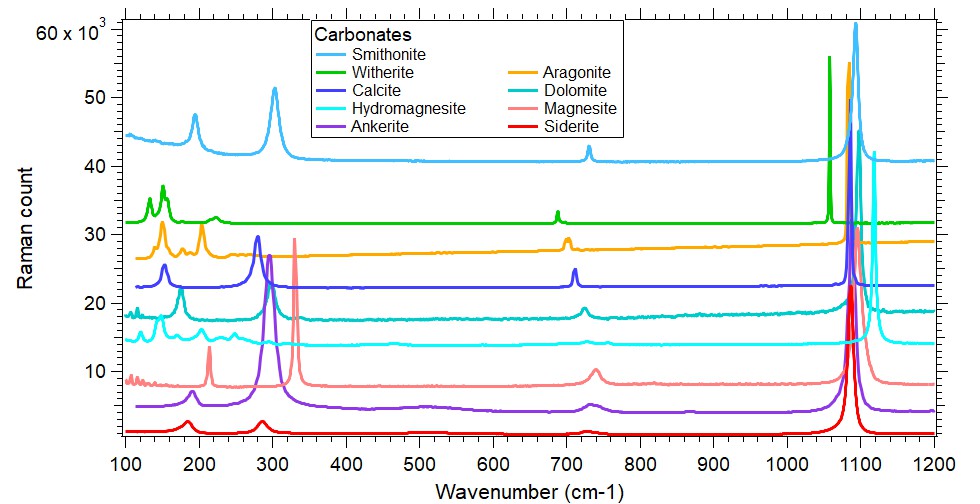
Figure 1: Raman spectra of a selection of anhydrous carbonates
Spectroscopic analysis
The analysis of the data mostly consisted in the measurement of the position (using peak fitting), width and intensity of all the observed emission or absorption bands. These parameters are then plotted one again each other to find the pairs which discriminate most efficiently between the different minerals. These band parameters are also plotted with the concentration of the different elements (Mg, Fe, Ca…) in order to determine which one may be a good proxy to determine accurately the composition of intermediate constituents in solid solutions.
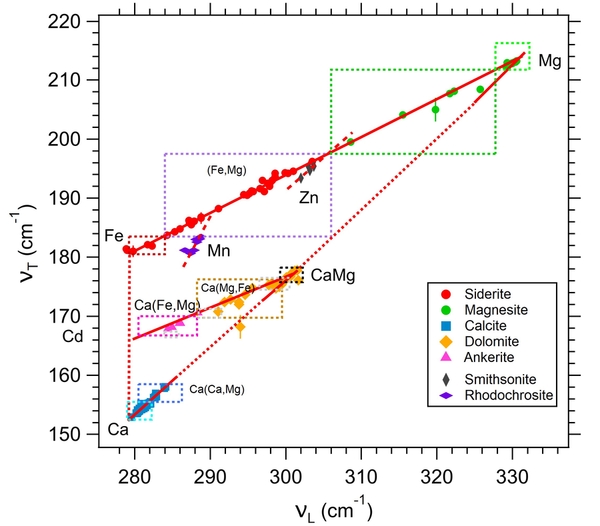
Figure 2: Example of correlation between the positions of two Raman bands (υTand υL) of different Ca-Mg-Fe-Mn-Zn carbonates.
Bandlist
An exhaustive compilation and a critical review of all the literature describing the infrared absorption and Raman emission spectroscopic properties of these carbonates has been performed. It has been complemented by our measurements to determine the range of values spanned by the position, width and intensity of all bands of all these carbonates. These IR absorption and Raman emission datasets have then been complemented with metadata on the mineral composition and are now partly ingested in the band list database of the SSHADE infrastructure. The corresponding spectra are also available in the spectral databases of SSHADE. A carbonate band list or one of its IR or Raman band can be searched using the tools and the various filters provided by the SSHADE search interface.
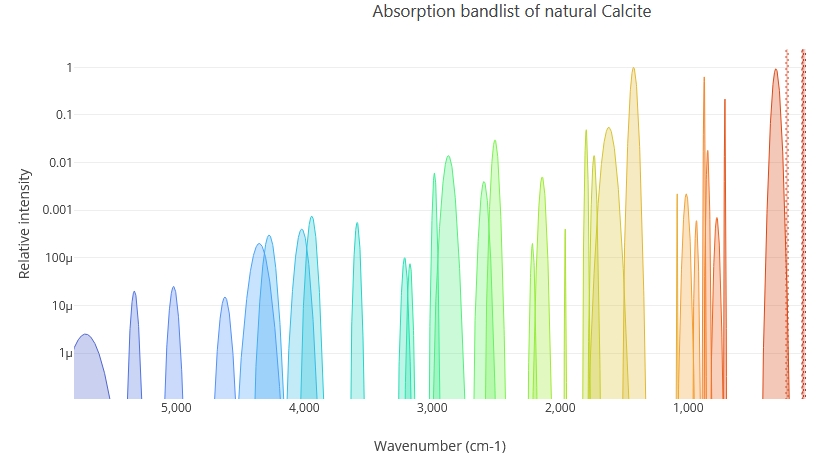
Figure 3: The absorption band list of Calcite
Conclusion
This band list database fed with critical literature review complemented by laboratory measurements should become a key tool for astronomers and planetary scientists to identify unknown absorption bands observed in the spectra of the surface or atmosphere of many astrophysical and solar system objects. Once the best candidate solid found by the user, the tool will link to the most relevant spectral datasets present in the SSHADE databases. These data can then be used for direct comparison with observations, or to model them through radiative transfer codes.
Acknowledgements
We would like to thanks several local collectors who donated samples for this study, and the curator of the OSUG collection. The Europlanet 2024 Research Infrastructure project received funding from the European Union's Horizon 2020 research and innovation programme under grant agreement No 871149. We also acknowledge OSUG, and INSU for additional financial supports.
How to cite: Schmitt, B., Beck, P., Mandon, L., Leclef, A., Teixeira, F., Lanson, M., and Montes-Hernandez, G.: Reflectance and Raman spectroscopy of anhydrous carbonates for their identification at the surface of planetary bodies., Europlanet Science Congress 2024, Berlin, Germany, 8–13 Sep 2024, EPSC2024-1124, https://doi.org/10.5194/epsc2024-1124, 2024.
Here we present a summary and outlook of studies looking into and trying to understand the geomorphology and spectral appearance of devolatilization morphologies on the asteroid Vesta. These studies include remote observations and analysis of multispectral reflectance data obtained by NASA’s Dawn mission [1,2], heating experiments and reflectance measurements [3] executed at the Planetary Spectroscopy Laboratory [4] as well as observations and measurements via Electron Probe Micro Analysis [3].
The abovementioned devolatilization morphologies are the so-called pitted impact deposits (PIDs), which present themselves as densely clustered, polygonally-shaped pits [5] (Fig. 1a) within ejecta deposits. These PIDs show distinct spectral properties, whereas the exact cause(s) are still uncertain. The pyroxene-dominated reflectance spectra of the surfaces of these PIDs are characterized by higher overall reflectances in the visible and near-infrared light, more pronounced mafic absorption bands (Fig. 1b & 2a) and lower OH abundances (Fig. 1c) with respect to the adjacent material of the same ejecta deposit. PIDs mostly occur widely around one large, relatively young crater on Vesta [5, 1]. Some exhibit very large spectral differences with respect to their surroundings, and some do not. Those that exhibit the most distinct spectral characteristics and large differences with respect to their surroundings tend to occur in topographic traps like pre-existing impact craters [1]. During the abovementioned studies, several possible causes for these spectral differences could be excluded, like for example differences in grain size or differences in age/exposure to space weathering [1].

Fig. 1: a) Dawn FC clear filter image of a PID southwest of the parent crater Marcia. Resolution is around 20 m/px. b) RGB color composite highlighting the distinct spectral properties (higher reflectance and pyroxene absorption band depth). Resolution is around 60 m/px. R = 0.965/0.917 [µm], G = 0.750 µm and B = 0.750/0.917 [µm]. c) Dawn VIR 2.8 µm band depth data from [11], with greenish colors indicating less OH. Images taken from [1].
During our experiments [3], we heated Vestan analog materials and found that their spectral properties also changed upon heating (in vacuum), yet only beneath the surface. The sample surface itself turned darker than before heating, while the subsurface turned reddish to the naked eye. Reflectance measurements showed that the visible slope increased, as well as overall reflectance and even the pyroxene absorption band depth (with respect to the heated surface, Fig. 2b). EPMA furthermore revealed that hematite was formed within our sample, which indicates that an oxidation process occurred. Hematite formed as thin, amorphous-looking rims around diverse grains like FeS, pyroxenes or pure Fe metal (Fig. 3). The formation of hematite could explain the formation of higher reflectances and visible slopes, yet not the formation of the stronger pyroxene band depth.
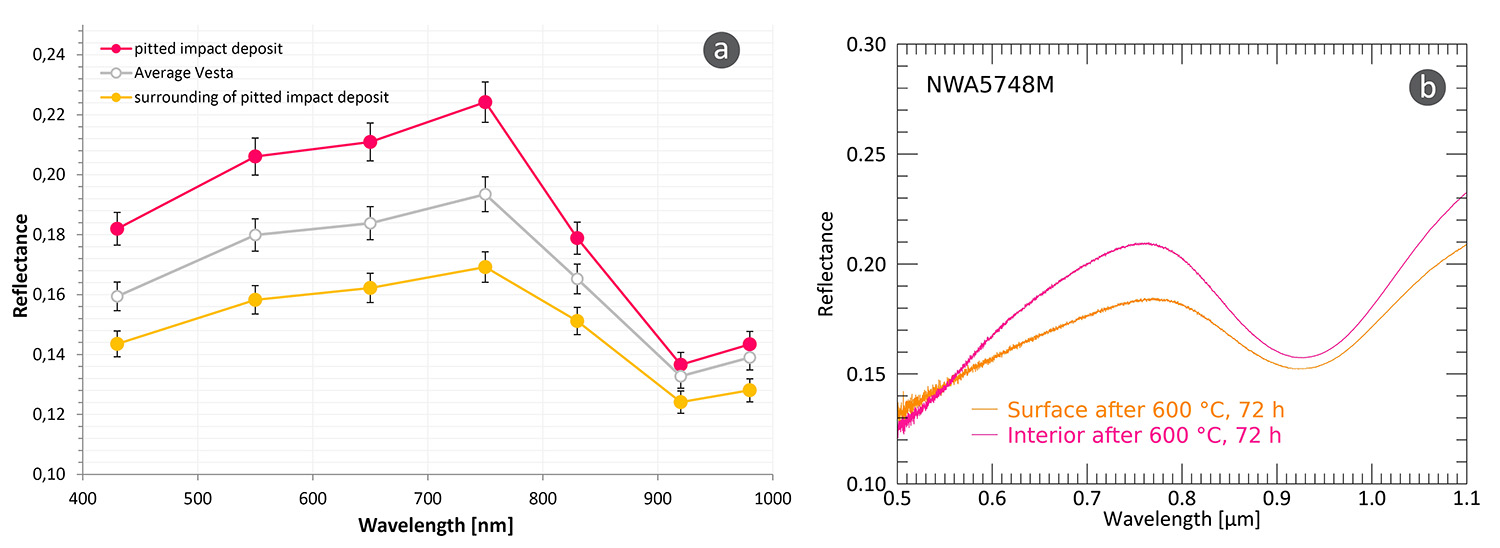
Fig. 2: a) Dawn FC reflectance spectra of the pitted terrain (red) and its surrounding (yellow) shown in Figure 1 as indicated by the crosses. In addition, the reflectance spectrum of the average Vesta is shown. b) Laboratory-obtained reflectance spectra of the surface and interior of heated sample (Howardite NWA 5748 mixed with carbonaceous chondrite Murchison) to 600 °C for 72 h, showing the higher reflectance, visible slope and stronger mafic absorption of the interior. Figures taken from [3].
A current hypothesis suggests changes in the occupation of the M1 and M2 sites within the pyroxene crystals or the migration of iron cations within the crystal as the cause of the stronger mafic absorptions. This process might be triggered by the presence of volatiles. These volatiles may be prevented from quickly escaping into space when trapped deep enough in the deposit, gaining time to interact somehow with the surrounding material.
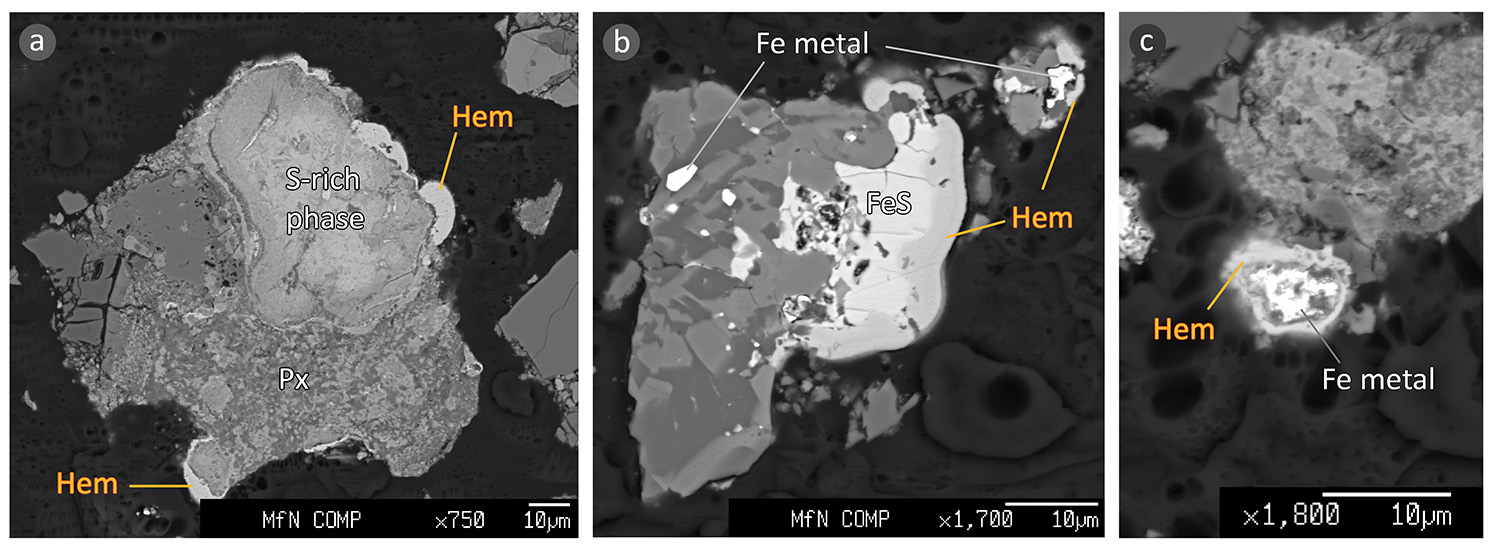
Fig. 3: Backscatter images of sample NWA5748M (Howardite NWA 5748 mixed with carbonaceous chondrite Murchison) heated to 600 °C for 72 h, obtained at the Museum für Naturkunde Berlin. A) Hematite rims around a composite grain of pyroxene and a sulfur-rich phase (that could not be identified). B) Hematite rims around FeS and Fe metal. Fe metal within the larger grain did not develop a hematite rim. C) Hematite rim around a Fe metal grain.
This was similarly hypothesized for oxidation experiments in air of terrestrial pyroxenes [6], which showed a similar behavior. In the case of Vesta and our experiments, the volatile species is most likely free OH released from phyllosilicates during the devolatilization of ejecta after deposition or of our analog material during heating, respectively. It is also plausible that the impactor that formed the large crater added volatiles into the ejecta, facilitating the prominent pit-forming devolatilization of ejecta. There is definite proof of the existence of relatively large abundances of OH on Vesta’s surface [e.g., 7], likely incorporated due to influx of carbonaceous chondrite material throughout geological time [e.g., 8,9].
TM has received federal funding (DFG project 528399203) to explore the causes that could influence the pyroxene’s reflectance spectrum during a devolatilization event. We will use Mössbauer spectroscopy in order to resolve the oxidation states of Fe in our heated and unheated analog samples. Moreover, we aim to use a specific EPMA method (flank method) developed by Dr. H. Höfer [10] in order to resolve the distribution of Fe cations within single pyroxene grains.
All this may lead to a better understanding of the interactions between volatiles (from exogenic input) and mafic material from differentiated planetary surfaces.
References
[1] Michalik et al. (2021) Icarus 369, Article 114633, doi: 10.1016/j.icarus.2021.114633
[2] Michalik et al. (2022) The Planetary Science Journal, 3:182 (15pp), doi: 10.3847/PSJ/ac7be0
[3] Michalik et al. (2024) Meteoritics & Planetary Science 1-34, doi: 10.1111/maps.14156
[4] Maturilli et al. (2019) SPIE Proceedings Vol. 11128, Infrared Remote Sensing and Instrumentation XXVII, 111280T, doi: 10.1117/12.2529266
[5] Denevi et al. (2012) Science 338, 246-249, doi: 10.1126/science.1225374
[6] Cutler et al. (2020) The Planetary Science Journal, Vol. 1, 1:21, doi: doi.org/10.3847/PSJ/ab8faf
[7] De Sanctis et al. (2012) The Astrophysical Journal Letters, 758:L36, doi: 10.1088/2041-8205/758/2/L36
[8] McCord et al. (2012) Nature Letter 491, 83-86, doi: 10.1038/nature11561
[9] Reddy et al. (2012) Icarus 221, 544-559, doi: 10.1016/j.icarus.2012.08.011
[10] Höfer & Brey (2007) American Mineralogist, Vol. 92, 873-885, doi: 10.2138/am.2007.2390
[11] Combe et al. (2015) Icarus 259, 21-38, doi: 10.1016/j.icarus.2015.07.034
How to cite: Michalik, T., Otto, K. A., Maturilli, A., Cloutis, E. A., and Hecht, L.: How and why can oxidation influence the reflectance spectrum of pyroxenes on planetary bodies?, Europlanet Science Congress 2024, Berlin, Germany, 8–13 Sep 2024, EPSC2024-1069, https://doi.org/10.5194/epsc2024-1069, 2024.
L-type asteroids are rare asteroids located throughout the Main Belt. They are unique among the minor bodies as their spectral appearance in the visible-near-infrared (VisNIR) is thought to be dominated by calcium–aluminium-rich inclusions (CAIs): agglomerates of minerals found in chondritic meteorites that contain the first solids that condensed in the solar nebula [1, 2]. A primary mineral phase in CAI is the aluminium oxide spinel (MgAl2O4), which presents an absorption feature at 2μm when enriched in iron due to thermal metamorphism. This absorption feature is observed in L-types, suggesting an enrichment of refractory inclusions in these bodies [3]. Therefore, the parent bodies of L-types might have formed at an early time and within a region of the protoplanetary nebula with a high concentration of CAI. If this is the case, the significance of L-type asteroids as tracers of planetary compositional and dynamical evolution cannot be overstated. The key question is: How rich in refractory inclusions are L-type asteroids?
Sunshine et al. (2008) concluded that some L-types contain between 22%-39% of FeO-rich CAI [4], an order of magnitude larger than what has been observed in the meteorite collection (<3vol%, [5]). Devogèle et al. (2018) confirmed the enrichment of most (but not all) L-types using the same methodology on a larger sample of L-type asteroids [6]. On the other hand, Mahlke et al. (2023) identified potential meteoritic analogues for several L-type asteroids among CO and CV chondrites [7], the meteorites with the highest CAI abundances, suggesting that L-types are at least partially sampled in the meteorite collection.
The discrepancy between the abundance models of asteroid spectra and direct comparisons with meteorite analogues may be in part due to the unknown spectral response of L-type material to secondary factors such as space weathering and phase-angle variations. While Lantz et al. (2017) have shown that CV and CO chondrites redden with increasing surface age [8], the response of the crucial 2μm band is unknown, though this information is paramount for deriving the CAI abundance in asteroids.
To quantify the effects of space weathering and phase-angle variations on spectra of L-type material, we collected nine samples of possible meteoritic analogues: 6 CV (2 of each subtype: reduced, oxidized-Allende-like, oxidized-Bali-like), 1 CO, 1 CK, and 1 CL chondrite.1 Using the SHADOWS spectro-goniometer at IPAG, Grenoble [10], we acquired VisNIR spectra of the samples under multiple observation geometries to simulate the phase-angle variations of asteroidal targets as function of surface composition. For all samples, spectra are available from freshly-ground powders (in part newly acquired, in part from [11]) and from pressed pellets, further describing spectral changes due to surface texture and packing.
A particular focus of our experiment lies on the weathering-response of CAIs. To this end, we identified a large (>1mm in diameter) CAI rich in iron-bearing spinel in a section of CV Allende via scanning-electron microscopy, analogous to the inclusion expected on the asteroidal surfaces. For all samples (chondrites and CAI), we have concluded a dense spectral characterisation over a large wavelength range (VisNIR as described above and mid-infrared spectra at Synchrotron SOLEIL, Saint-Aubin), which is to be followed-up by ion irradiation using the INGMAR experiment (IAS & ICJLab, Orsay) to simulate space weathering by the solar wind [12]. We aim to acquire VisNIR spectra during the irradiation process at different dosages of ion implementation, capturing different degrees of space weathering. After irradiation, we aim to repeat the spectral characterisation executed before to capture and quantify spectral changes relevant for the interpretation of asteroidal spectral, including the common VisNIR range but also the mid-infrared range, now more accessible to remote-sensing observations than previously thanks to NASA JWST (e.g. [13]).
The irradiation and post-irradiation characterisation are scheduled to be concluded by July 2024. We will present first results of the irradiation experiments and further on-going efforts to describe the response of the samples to irradiation and phase-angle variations, crucial for the interpretation of remote-sensing observations of asteroids. Ultimately, the results obtained in this study will guide us in further constraining the nature of L-type asteroids by determining the closest analogue material within the meteorite collection and by aiding the interpretation of new spectra of L-type asteroids acquired in an on-going observational campaign with ESO's VLT/X-SHOOTER as part of this project.
1 The Loongana (CL) group is a recent addition to the taxonomy of chondrites [9].
References:
[1] Amelin, Y., et al. (2002), Science, 297, 1678
[2] Piralla, M., et al. (2023), Icarus, 394, 115427
[3] Burbine, T. H., et al. (1991), BAAS, 23, 1142
[4] Sunshine, J. M., et al. (2008), Science, 320, 514
[5] Scott, E. R. D. & A. N. Krot (2014), In Meteor. and Cosmoch. Proc., 1, 65
[6] Devogèle, M., et al. (2018), Icarus, 304, 31
[7] Mahlke, M., et al. (2023), A&A, 676, A94
[8] Lantz, C., et al. (2017), Icarus, 285, 43-57
[9] Metzler, K., et al. (2021), GCA, 304, 1-31
[10] Potin, S., et al. (2018), Applied Optics, 57:8279, 2018
[11] Beck, P., et al. (2021), Icarus, 354, 114066
[12] Brunetto, R., et al., (2014), Icarus, 237:278-292, 7 2014
[13] De Kleer, K., et al. (2024), LPSC Abstract, 3040
Acknowledgements: This work was supported by the Programme National dePlanétologie (PNP) of CNRS-INSU co-funded by CNES.
How to cite: Mahlke, M., Aléon-Toppani, A., Lantz, C., Beck, P., Bonal, L., Brunetto, R., Tanga, P., and Aléon, J.: Analogues of enigmatic L-types: The effect of space weathering on CV, CO, CK, and CL chondrites, Europlanet Science Congress 2024, Berlin, Germany, 8–13 Sep 2024, EPSC2024-173, https://doi.org/10.5194/epsc2024-173, 2024.
Introduction
The study on the composition of meteorites, asteroids, comets, and trans-neptunian objects suggest that they contain materials originated during the early stages of the solar system formation. A relevant fraction of organic materials trapped in small bodies are thought to form from chemical reactions that involve carbon-bearing frozen volatiles species that are revealed in various star-forming regions and protoplanetary disks [1, 2]. Complex reactions are triggered by the interaction of solid-phase materials with energetic charged particles, such as galactic cosmic-rays (GCR), and energetic photons (x-rays, UV) that induce both the destruction of the pristine species and the formation of new compounds [3]. In addition, solar wind (SW) and solar energetic particles (SEP) also induce chemical reactions at the surface of outer icy small bodies [4]. As a result, pristine volatile species are destroyed and more complex molecules can form. The chemical complexity is further increased by the thermal processing that matter can suffer both during the star-formation process and in the event of migrations in the inner solar system. Processing at high temperature also affects the properties of meteorites during their entry into the atmosphere. Understanding how this event affects the physical, chemical, and spectral properties of meteorites is of particular relevance because these samples are often used to interpret the spectra of asteroids and other small bodies.
Information on the chemistry triggered by energetic charged particles and heating in the formation of organic matter comes from laboratory experiments where simple carbon-bearing molecules are deposited at very low temperature (≤ 20 K), exposed to ion beams (keV-MeV), and further heated to room temperature (~ 300 K). These experiments lead to the formation of the so-called organic refractory residues, samples whose characterization revealed the presence of thousands of organic species, including compounds of astrobiological relevance, providing insights into the composition of extraterrestrial organics [5, 6, 7]. However, no information is available on the heating of organic refractory residues at temperatures higher than 300 K.
Methods
We present new experiments of ion bombardment and further thermal heating of simple frozen volatile compounds representative of the pristine composition of icy materials in the presolar cloud. Ion bombardment experiments were performed with the facilities available at the Laboratory for Experimental Astrophysics (LASp) at INAF-Osservatorio Astrofisico di Catania (Italy). Ice mixtures containing H2O, CH3OH, NH3 and CO, CH4, and N2 were deposited in a ultra-high vacuum chamber (P ≤10-8 mbar) at low temperature (18 K) and exposed to 200 keV H+ and He+, respectively. After the bombardment, processed ices were warmed-up to 300 K with a constant heating rate in order to produce organic refractory residues. These samples were then extracted from the UHV chamber, stored in vacuum sample holders and transferred to the Planetary Spectroscopy Laboratory (PSL) at the DLR Berlin. At the PSL, organic refractory residues were placed in a oven and heated in vacuum (P≤10-2 mbar) up to 970 K. The heating was performed in various step and with a constant heating rate.
During the ion bombardment, samples were analysed by means of Fourier-transform infrared (FT-IR) spectroscopy in the near- and mid-IR (1.25-10.5 µm, 8000-950 cm-1) in transmittance mode. Several spectra were acquired in-situ during the processing, allowing us to follow the changes induced by energetic charged particles in the composition of ices. Spectra were also acquired during the warm-up to 300 K to follow the formation of organic refractory residues. At the PSL, FT-IR spectroscopy was also used to characterize samples after each step of warm-up.
Results
The spectra collected during ion bombardment at 18 K show the destruction of the pristine frozen compounds and the formation of new species, including the precursors of complex organic species, such as aldehydes (5.81 µm, 1720 cm-1) and CN-bearing compounds (4.42 µm, 2260 cm-1). The characterization performed after ion bombardment and during warm-up to 300 K show the sublimation of the most volatile species and spectral changes that point to the formation of organic refractory materials, as reported in previous similar experiments [8].
The further heating performed at the DLR shows relevant changes in the spectral properties of samples. In all cases, we observed a decrease in the intensity of the signal that is associated to a loss of material during warm-up. Shifts in the band position and changes in the relative intensity of absorption features also testify the alteration of the chemical properties of samples. In particular, we reveal strong changes in the 5.8-6.8 µm (1720-1470 cm-1) region that includes the absorption features of C=C, C=O, and C=N bearing compounds as well as in the region around 4.5 µm (2200 cm-1) that contains the absorption features of nitriles.
The data obtained are used to interpret the IR spectra of organic-rich meteorites and will support the understanding of the alteration induced by thermal processing of organic-rich surfaces in the inner solar system.
Acknowledgements
This work is supported by the Istituto Nazionale di Astrofisica (INAF) through the grant Organic Refractories Sustaining microOrganisms - ORSO, CUP C63C23001250005. RGU acknowledges the support from the Società Italiana di Scienze Planetarie - Angioletta Coradini (SISP-AC).
References
[1] McClure, M. K., Rocha, W. R. M., Pontoppidan, K. M. et al. 2023, Nat. Astronomy, 7, 431
[2] Sturm, A. J., McClure, M. K., Beck, T. L. et al. 2023, A&A, 679, A138
[3] Rothard, H., Domaracka, A., Boduch, P., et al. 2017, J. Phys. B, 50, 062011
[4] Urso, R. G., Vuitton, V., Danger, G. et al. 2020, A&A, 644, A115
[5] Nuevo, M., Auger, G., Blanot, D., & D’Hendecourt, L. 2008, Orig. Life Evol. Biosph., 38, 37
[6] Meinert, C., Myrgorodska, I., de Marcellus, P., et al. 2016, Science, 352, 208
[7] Danger, G., Orthous-Daunay, F. R., de Marcellus, P., et al. 2013, Geochim. Cosmochim. Acta, 118, 184
[8] Baratta, G. A., Chaput, D., Cottin, H., et al. 2015, Planet. Space Sci., 118, 211
How to cite: Urso, R. G., Alemanno, G., Baratta, G. A., Burr, D., Cadelli, E., Elsaesser, A., Helbert, J., Maturilli, A., Occhipinti, G., Palumbo, M. E., and Scirè, C.: Spectral changes induced by thermal processing of organic refractory materials, Europlanet Science Congress 2024, Berlin, Germany, 8–13 Sep 2024, EPSC2024-800, https://doi.org/10.5194/epsc2024-800, 2024.
Introduction:
The main-belt comets (MBCs) are objects that exhibit cometary activity but occupy stable orbits in the main asteroid belt. MBCs are considered as a hidden reservoir of water ice in the Solar System, and have the potential in terms of scientific research and space resource utilization in the future (Hsieh, 2020). The main-belt comet 133P/Elst-Pizarro (133P) is the first discovered and best characterized member of the MBCs. Dynamically, 133P fits well in Themis asteroid family (Hsieh et al., 2004). The spectra of 133P resembles best of B-type asteroid and is very similar to those of Themis family members (Hsieh et al., 2008; Licandro et al., 2011). Meteorites that can be compared to the Themis family are CI, CM, CR, CI-unusual, and CM-unusual (Clark et al., 2010).
This abstract described a series of methods to manufacture ice-bearing regolith simulant samples for 133P in the laboratory. The characteristics of the analogue are also obtained. The methods in this work can also be applied to the preparation and application of surface regolith simulants of other icy celestial bodies in the Solar System, which can provide scientific basis and ground truth for remote sensing detection, landing sampling and in-situ resource utilization in future probes.
Method:
The study involved creating a surface material analogue based on the observed and modeled composition of 133P. The surface regolith of the cometary is mainly composed of water ice, refractory organic matter, and minerals. A basic recipe for the prototype analogue is based on the observation and compositional modeling spectrum of 133P (Rousselot et al., 2011) and the modal mineralogy of the related meteorites. The analogue was developed using a mix of water ice, silicates (serpentine, olivine, pyroxene), amorphous carbon, and organics. Two methods were employed for preparing the ice-dust mixtures:
Mixing pre-prepared micron-sized ice particles with comet surface soil mimic powder in a cryogenic freezer.
Adding the cometary dust simulant to a dewar with generated ice particles, then separating the mixture after liquid nitrogen volatilization.
Fig. 1 Cometary surface regolith ice-dust analogue according to method 1
Fig. 2 Cometary surface regolith ice-dust analogue according to method 2
Characterization of the analogue included optical microscopy for morphology and particle size, laser diffraction for particle size distribution, X-ray fluorescence (XRF) spectrometry for bulk chemistry, and spectrophotometric analysis for optical properties.
Results:
The developed analogue successfully mimics the surface regolith of 133P. Optical microscopy revealed that the water ice particles were spherical, ranging from 2-12 μm. Laser diffraction indicated a broad particle size distribution, with the majority of particles falling within the expected size range for cometary dust. XRF spectrometry confirmed that the major elemental composition of the analogue closely matches that of carbonaceous chondrites, specifically CO3 chondrites, which are considered analogues for cometary material. Spectrophotometric analysis showed that the analogue's spectrum aligned well with observed data for 133P, validating the compositional accuracy of the analogue.
Fig.3 Spectrum of the cometary material analogue (red line); visible spectrum of 133P reported by Licandro et al. (2011, yellow spots); near-infrared spectrum of 133P reported by Rousselot et al. (2011, blue spots).
Conclusion:
Our cometary analogue provides a robust foundation for simulating cometary processes such as sublimation, deposition, and irradiation, crucial for understanding the early Solar System. Additionally, it supports the development of technologies for future space missions, including sample return missions and in-situ resource utilization.
References:
Hsieh, Henry. "Active Asteroids: Recent Results and Future Prospects." 44th COSPAR Scientific Assembly. Held 16-24 July 44 (2022): 200.
Licandro, J., et al. "Testing the comet nature of main belt comets. The spectra of 133P/Elst-Pizarro and 176P/LINEAR." Astronomy & Astrophysics 532 (2011): A65.
Clark, Beth Ellen, et al. "Spectroscopy of B‐type asteroids: Subgroups and meteorite analogs." Journal of Geophysical Research: Planets 115.E6 (2010).
Rousselot, Philippe, Christophe Dumas, and Frédéric Merlin. "Near-infrared spectroscopy of 133P/Elst-Pizarro." Icarus 211.1 (2011): 553-558.
How to cite: Zhang, X. and Xiao, Y.: Development of surface materials analogues of the main-belt comet 133P/Elst-Pizarro, Europlanet Science Congress 2024, Berlin, Germany, 8–13 Sep 2024, EPSC2024-1214, https://doi.org/10.5194/epsc2024-1214, 2024.
Introduction.
Comparing ultraviolet (UV) -visible (Vis) -infrared (IR) spectra of terrestrial/extraterrestrial materials with asteroids and moons is important to estimate surface mineralogical and physicochemial properties, which can provide clues to reveal the formation and evolution processes of the Solar System. This presentation reviews two topics of our current findings related to spectral comparison between remote-sensing and laboratory measurements for the asteroid Ryugu and the Moon, that will be useful for future in-space small body observations and sample return missions including MMX.
Comparison between lab-measured and remote-sensed spectra of Ryugu.
C-class asteroids are thought to be primitive bodies recording the solar system formation process. Captured samples have been delivered from the near-Earth asteroid (162173) Ryugu by the JAXA's Hayabusa2 spacecraft in 2020. Based on the results obtained by initial sample analyses, captured Ryugu materials are representative of Ryugu body surface, which has been aqueously altered strongly, and most similar to CI (Ivuna-type) chondrites spectroscopically and chemically [1-5]. In a spectroscopic view, however, there is a gap between remote-sensed data and lab-measured data. Lab-measured reflectance spectra of Ryugu samples in multiple grain and powder forms show a weaker OH absorption band at 2.7 μm due to hydrous silicates. Comparison among lab Ryugu spectra and carbonaceous chondrite spectra with different grain size, porosity, and space-weathering degree reproduced by ion/laser-irradiation experiments was performed, indicating that space weathering due to micrometeoroid bombardments mainly promotes spectral change at the Ryugu's surface [6].
Lab-measured spectra of ilmenite implication for the Moon.
Clarifying the distribution and abundance of ilmenite (FeTiO3) on the Moon is important for elucidating the formation and evolution process of the Moon and the property of the magma ocean. Ilmenite is abundant in the lunar mare basalts, and thus spectral properties of ilmenite in the UV-Vis-IR range have been investigated and known to show a positive peak at around 1 μm as a remnant of two neighbor absorption bands centered at around 630 nm and around 1300 nm due to Ti3+-Ti4+ charge transfer and Fe2+ crystal field transitions, respectively (e.g., [7] and referenses therein). Lunar spectra observed by the Spectral Profiler on board Kaguya/SELENE show a slight rise was found near the peak of 1 μm band absorption on the surface of the moon, and it was coincidently detected by the Multiband Imager [8]. Previous ground-based telescope obsevations also showed a weak rise inside 1 μm absorption band in the areas called Taurus-Littrow and Rima Bode on the lunar surface [9]. Ilmenite is thought to coexist with other minerals, therefore, Matsuoka and Yamamoto (2024) [10] performed lab spectral measurements using powdered ilmenite samples and other possible components of lunar basalts, e.g., augite and glass, with various mixing ratio. They reported that a little amount of ilmenite powder may produce absorption bands causing the 1-μm peak, and strong darkening, In contrast, significant blue slope (decreasing toward longer wavelength) in the UV range of ilmenite rapidly masked by a small amount of glass component, making the UV slope redder. It is suggested that to investigate ilmenite, using the UV feature gives very limited information on the lunar surface as considered by Sato et al. (2017) [11]. Those complex UV-Vis-IR spectral characteristics are necessary to be considered to interpret remote-sensed data based on quantitative data obtained by lab measurements.
Considering each of the component minerals has a different effect on reflectance spectra, while also unique alteration process and characteristics in space environments such as space weathering, suggests that sample return and close observations of Phobos, similar to D-type asteroids but whose surface properties are still unvailed, will provide a new property of the in-space surface characteristics of small bodies by MMX mission [12].
References:
[1] Tachibana et al. (2022) Science 375, 1011–1016.
[2] Pilorget, C. et al. (2022) Nat. Astron. 6, 221–225.
[3] Yada et al. (2022) Nat. Astron. 6, 214–220.
[4] Yokoyama et al. (2022) Science 379, eabn7850
[5] Nakamura et al. (2022) Science 379, eabn8671.
[6] Matsuoka et al. (2023) Commun Earth Environ 4, 335.
[7] Iwaza et al. (2021) Icarus, 362, 114423.
[8] Yamamoto et al. (2023) Fall Lecture of the Society of Planetary Sciences.
[9] Gaddis et al. (1985) Icarus, 61, 3, 461-489.
[10] Matsuoka and Yamamoto.(2024) Japan Geoscience Union Meeting 2024, PPS09-P01
[11] Sato et al. (2017) Icarus, 296, 216–238.
[12] Kuramoto et al. (2021) Earth, Planets and Space, 74:12.
How to cite: Matsuoka, M.: Investigating reflectance spectra to link remote-sensed data with lab-measured data: cases of asteroid (162173) Ryugu and the Moon, Europlanet Science Congress 2024, Berlin, Germany, 8–13 Sep 2024, EPSC2024-1290, https://doi.org/10.5194/epsc2024-1290, 2024.
Comets and asteroids are among the most pristine objects in the Solar System, being formed out of the materials available in the proto-Solar Nebula [1]. Especially interesting are the complex organic molecules in these bodies, as they likely contribute towards the elemental composition of forming planets, as well as potentially being delivered after accretion of planetary bodies via impacts and thus contribute to their molecular inventory [2, 3].
Many primitive solar system objects, such as carbonaceous chondrites or interplanetary dust particles (IDPs), contain organic matter, which itself can be divided into a solvent-soluble (soluble organic matter, SOM) and insoluble fraction (Insoluble Organic Matter, IOM) [4, 5]. The soluble fraction can contain PAHs, sugars, nucleobases, and amino acids [6, 7, 8, 9]. The insoluble fraction is a mix of large macromolecules with numerous molecular links and functional groups [3, 14]. The formation environment of the IOM is an area of ongoing research and IOM could have formed either in the interstellar medium or in the proto-Solar Nebula [3].
In the proto-Solar Nebula, interstellar space, and protoplanetary disks, microscopic ice-coated dust grains are readily available. Laboratory experiments on the energetic processing of extraterrestrial and interstellar ice analogues show that a number of complex molecules form, including prebiotic molecules [e.g., 10, 11, 12, 13, 14], therefore focussing on recreating the chemical inventory observed in SOM. Even though it makes up the majority of the organic carbon in solar system objects, IOM has not been extensively studied in the laboratory. However, the formation pathways of IOM are crucial to understand the complex – insoluble – organic molecules available for the formation of planetary bodies.
Methods
In this study, irradiation experiments on ice are performed with the ICEBEAR setup [15]. The setup consists of a stainless-steel vacuum chamber with base pressures of <2∗10-8 mbar. Vacuum-grade aluminium foil is fixed onto a copper sample holder (Fig. 1), which is mounted on the cold head of a closed cycle helium cryostat, allowing for cooling of the sample holder to < 5 K. The temperature of the sample holder is monitored using a diode and two heating elements are mounted into the sample holder to allow for resistive heating. In a separate gas mixing system, gases are mixed and enter the chamber via a manually operated leak valve. This results in the formation of a simulated extraterrestrial ice film on the aluminium foil.
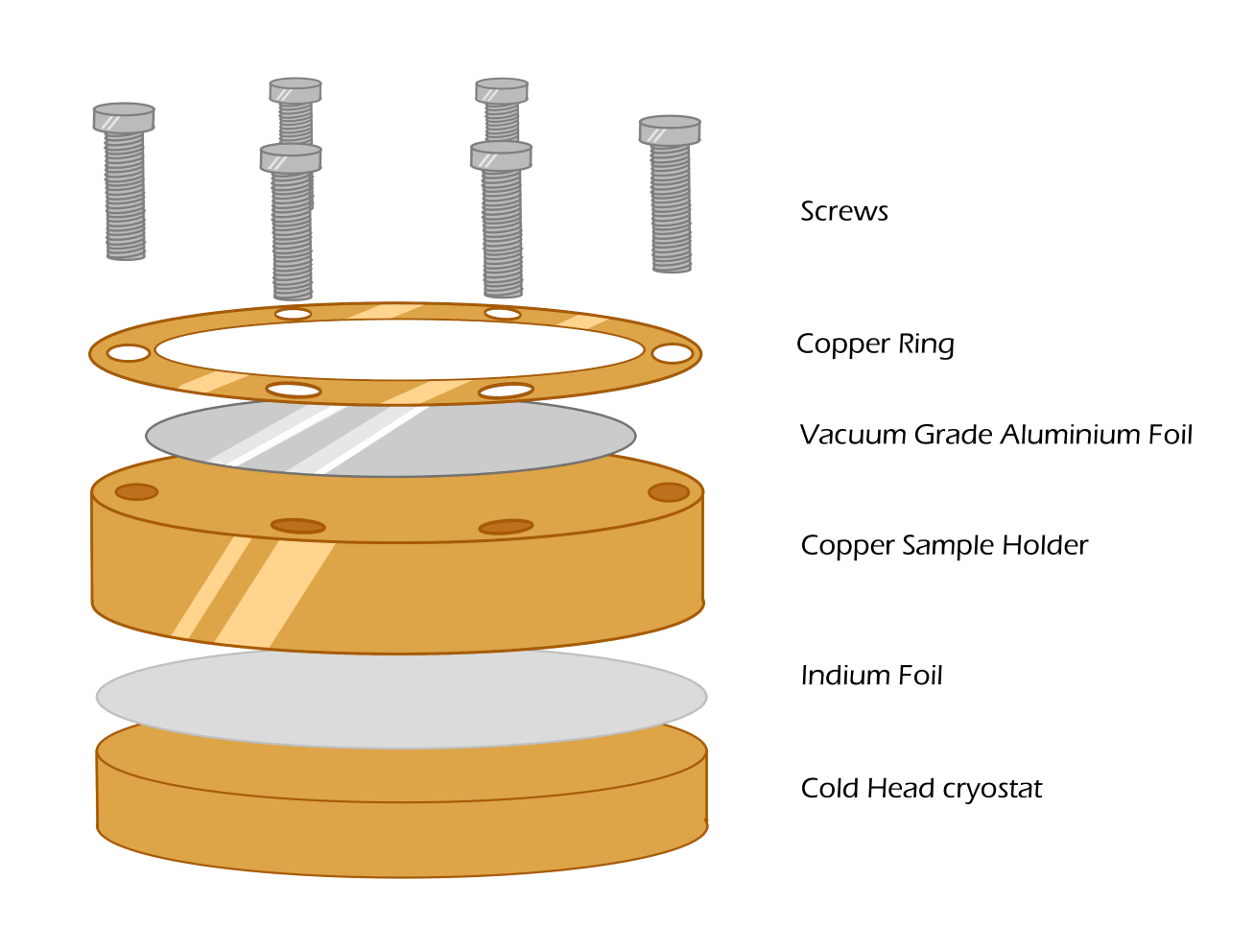
For the ices investigated in this study, H2O, CH3OH and N2 are used. H2O is the main constituent of interstellar ices, with CH3OH being a major ice component in various astrophysically relevant objects and acting as a carbon donor. N2 is used as a proxy for abundant nitrogen donors, such as ammonia.
The gas mixture is leaked into the chamber, where it adsorbs onto the cold (~10 K) aluminium foil. Next, the ice is irradiated with 5 keV electrons, resulting in the formation of soluble organic matter. For several samples, a second irradiation is performed, which has been observed to lead to the formation of a darker residue, presumed to be insoluble organic matter. Different experimental procedures, including the parameter space of temperatures and irradiation durations and their influence on the resulting residues are investigated.
The produced residues are analysed using micro-Raman spectroscopy at ETH Zürich with a laser operating at 532 nm. Raman spectroscopy is a powerful tool to investigate the structure of carbonaceous material. Especially interesting are the D (disordered) and G (graphite) bands of carbon. The peak widths and positions of the two bands, as well as their ratio, give valuable information about the structural order of the material. The results are compared to IDPs, which are thought to contain some of the most primitive organic matter in the solar system [5].
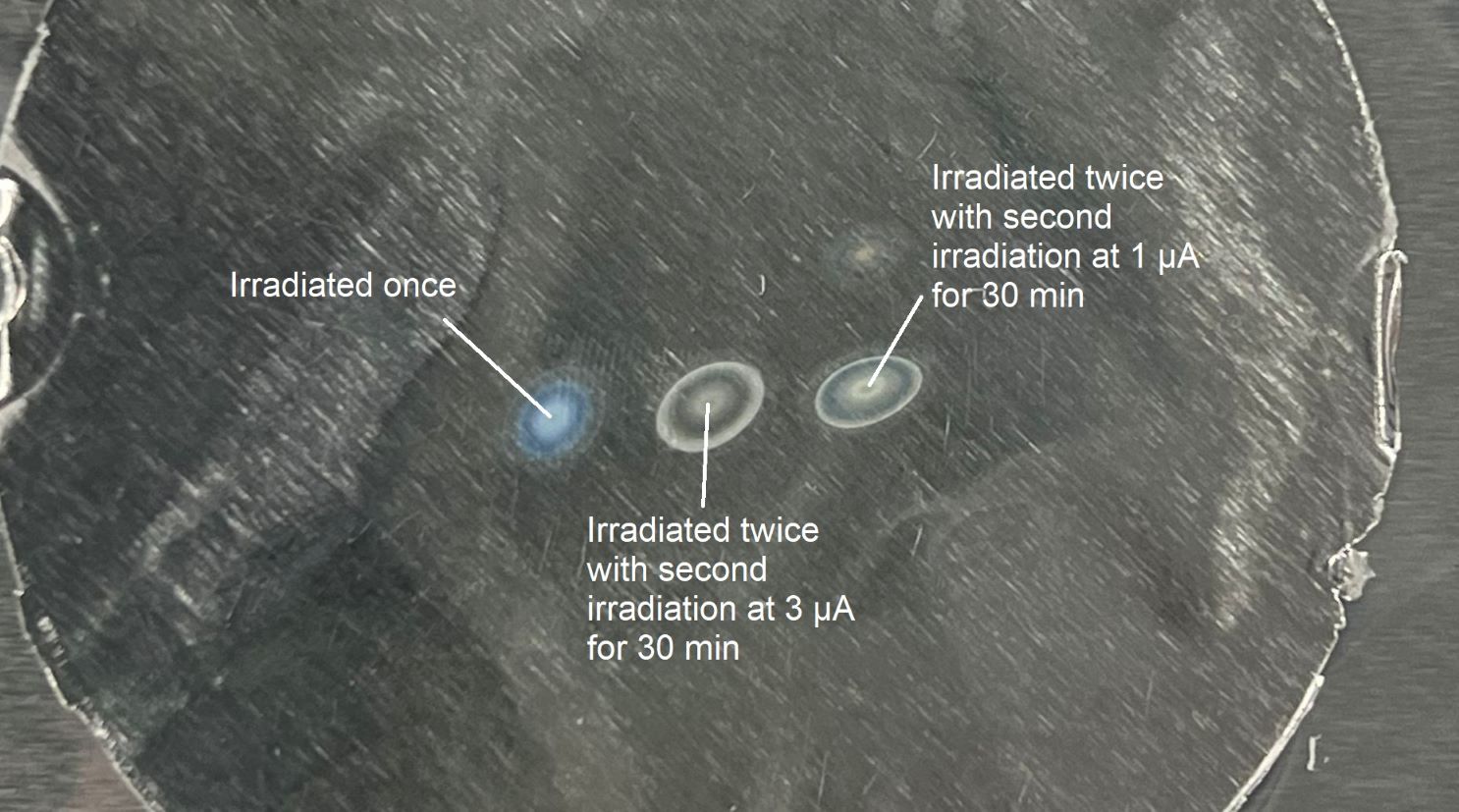
Results:
The initial analysis of the residue of a double irradiated ice sample with micro-Raman spectroscopy hints towards the formation of amorphous carbon that is even more primitive than the IOM observed in meteorites and rather resembles the IOM extracted from IDPs.
Further analysis is needed to show the evolution of the Raman spectra as a function of the investigated parameters. The ongoing work will be presented and the influence of different laboratory conditions on the resulting residue investigated. This investigation helps bridge the gap between the parent ices as building blocks of organic material in meteorites and comets and the observed structure of primitive meteorites.
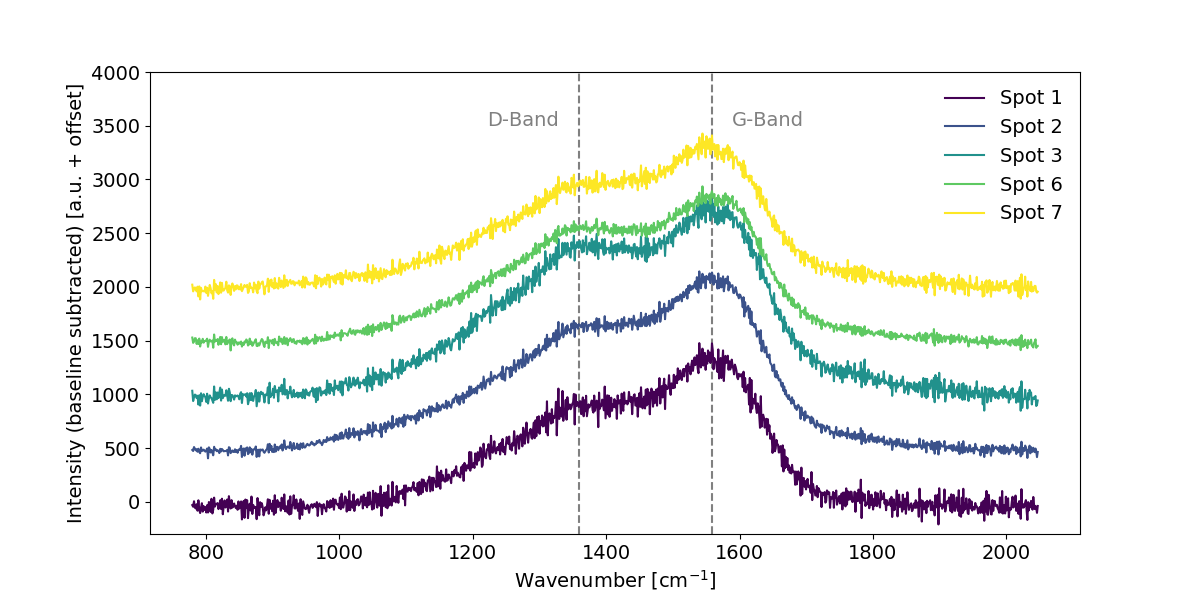
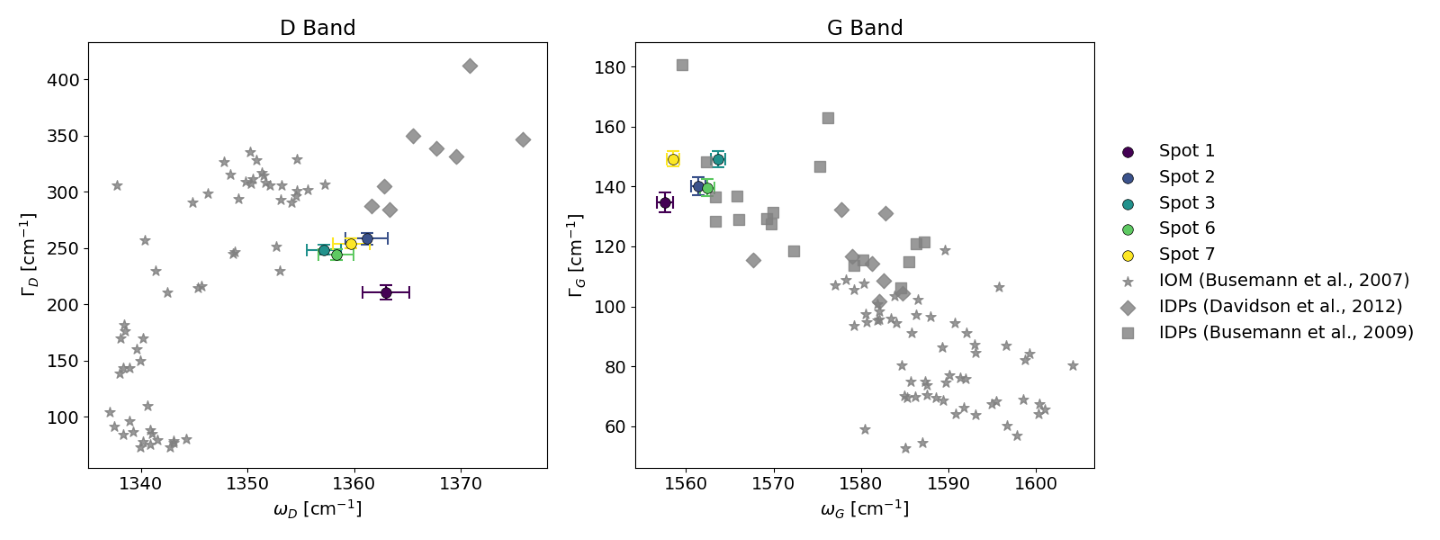
References:
[1] Caselli & Ceccarelli, Astron Astrophys Rev 20, 2012, doi : 10.1007/s00159-012-0056-x
[2] Chyba & Sagan , Nature, 1992, doi: 10.1038/355125a0
[3] Alexander et al. Geochemistry, 2017, doi: 10.1016/j.chemer.2017.01.007
[4] Garcia et al., ACS Earth and Space Chemistry, 2024. doi: 10.1021/acsearthspacechem.3c00366
[5] Riebe et al., Earth and Planetary Science Letters, 2020, doi: 10.1016/j.epsl.2020.11626
[6] Pizzarello et al., Meteorites and the Early Solar System II, 2006
[7] Callahan et al., Proceedings of the National Academy of Sciences, 2011, doi: 10.1073/pnas.1106493108
[8] Furukawa et al., Proceedings of the National Academy of Sciences, 2019, doi: 10.1073/pnas.1907169116
[9] Lecasble et al., Geochim. Cosmochim. Acta 2022, doi: 10.1016/j.gca.2022.08.039
[10] Allamandola et al. Space science reviews, 1999, doi: 10.1023/A:1005210417396
[11] Herbst & van Dishoeck, Annual Review of Astronomy and Astrophysics, 2009, doi:10.1146/annurev-astro-082708-101654
[12] Öberg, Chemical Reviews, 2016, doi: 10.1021/acs.chemrev.5b00694
[13] Muñoz Caro et al., ACS Earth and Space Chemistry, 2019, doi: 10.1021/acsearthspacechem.9b00086
[14] Danger et al., A&A, 2022, doi : 10.1051/0004-6361/202244191
[15] Kipfer et al., Icarus, 2024, doi: 10.1016/j.icarus.2023.115742
How to cite: Kipfer, K., Ligterink, N. F. W., Riebe, M., and Allen, N. M.: The origin of Insoluble Organic Matter: Formation of macromolecules from heavily irradiated simple ices, Europlanet Science Congress 2024, Berlin, Germany, 8–13 Sep 2024, EPSC2024-176, https://doi.org/10.5194/epsc2024-176, 2024.
Introduction
The pathways from simple organic molecules to prebiotics and complex life on Earth remain poorly understood. Adenine and other organic compounds involved in biochemistry have been detected in carbonaceous chondrites and laboratory analogs of Titan aerosols (Hayatsu et al., 1964; Martins et al., 2008; Pilling et al., 2009). Laboratory experiments propose abiotic nucleic base formation in various space environments (Sebree et al., 2018; Kimura and Kitadai, 2015; Gupta et al., 2011). Radiation exposure in space raises questions about adenine's stability under ionizing radiation, as it is an essential component of DNA. Previous studies investigated solid adenine's survivability under different radiation sources such as high energy representatives of galactic cosmic rays (Huang et al., 2014; Peeters et al., 2003; Poch et al., 2014; Evans et al., 2011). Here, ions are more representative of the solar wind. Higher energy radiation leads to adenine destruction and formation of smaller molecules or ions (Peeters et al., 2003). However, adenine exhibits higher photostability compared to other compounds under low-energy UV-radiation, indicating the formation of more complex molecules protecting it from further destruction (Poch et al., 2014). This study explores the effects of irradiating solid adenine thin films with 30 to 70 keV 18O+- and 20Ne+-ions, an energy range not thoroughly investigated previously (Huang et al., 2014). In-situ IR-spectroscopy and ex-situ ultra-high-resolution mass spectrometry (HRMS) provide insight into spectral and chemical properties, focusing on the chemical analysis of the higher mass ranges.
Experimental Methodology
Two methods were used for the sample synthesis. Firstly, at Institut de Planétologie et d'Astrophysique de Grenoble (IPAG), adenine powder was dissolved in an ethanol-water solution and deposited onto MgF2 windows, resulting in "grainy" films. Secondly, at Laboratoire Interuniversitaire des Systèmes Atmospheriques (LISA), sublimation/ recondensation reactor produced homogeneous "thin-films" on MgF2 windows at 130 °C under 2.0x10-3 mbar pressure. The irradiation experiments were conducted at GANIL (Caen) and IJCLab (Orsay) using 18O+ and 20Ne+-ion beams. In total, 17 adenine samples underwent irradiation with energies ranging from 30 to 70 keV. Ion flux and total fluence varied, with some samples cooled to 150 K for comparison purposes. IR spectra were recorded during irradiation. Finally, in the ex-situ analysis phase, the chemical composition was determined using the ultra-high-resolution mass spectrometer Orbitrap. The soluble parts of samples were analyzed via Electrospray Ionization (ESI) in negative mode. The mass spectra were interpreted using an in-house program (ATTRIBUTOR). There, molecular ions are attributed to each individual mass peak.
Results and Conclusions
The results show that low energy ion irradiation of adenine leads not only to its destruction but also to the formation of larger molecules following (HCN)𝑥R, where x ≤ 14. These HCN-molecules show a great chemical diversity and complexity with R being C𝑥, H𝑥, N𝑥, N𝑥H𝑦, C𝑥H𝑦 or C𝑥N𝑦, with the latter being the most versatile. New appearing bands in the IR-spectra indicate the formation of nitriles, primary amines and CN ring bonds. The aromaticity equivalent (Xc) of the HCN-molecules reveals their structure:
Xc = ((C#-((H#-N#)-C#))/DBE)+1 (1)
where C#, H# and N# is the number of carbon, hydrogen and nitrogen atoms in the molecule and DBE is the double bond equivalent. Yassine et al. (2014) propose a threshold value of Xc ≥ 2.5 for the presence of aromatic structures and Xc ≥ 2.7143 for condensed aromatic structures or polycyclic aromatic nitrogen bearing hydrocarbons (PANH) (s. Figure 1). Due to the degree of aromatization, a repeating ring structure as shown in Figure 1 is likely.
The free parameters (ion, energy, temperature) of the irradiation experiment do not have a noticeable influence on the chemical complexity of the samples. Furthermore, nitrogen is very efficiently incorporated into the new forming molecules of the irradiated adenine samples.
Figure 1: The aromaticity equivalent (Xc) as a function of number of carbon atoms (C#) for the molecules in the irradiated adenine samples. The size of the circles corresponds to the normalized intensity of the molecule in the mass spectrum (left). Schematic chemical structure versions of HCN-polymer from Völker (1960) (right).
Acknowledgements
We thank the Programme National de Planétologie (PNP) for supporting this work. This work is supported by the French National Research Agency in the framework of the "Investissements d’avenir” program (ANR-15-IDEX-02) and the generic call for proposals (ANR-22-CE49- 0017). The experiments were performed at the Grand Accélérateur National d’Ions Lourds (GANIL) by means of the CIRIL Interdisciplinary Platform, part of CIMAP laboratory, Caen, France. We thank the staff of CIMAP-CIRIL and GANIL for their invaluable support. We acknowledge the fundings from ANR IGLIAS grant ANR-13-BS05-0004 of the French Agence Nationale de la Recherche.
References
- Evans, Nicholas L., et al. "On the interaction of adenine with ionizing radiation: Mechanistical studies and astrobiological implications." The Astrophysical Journal 730.2 (2011): 69.
- Gupta, V. P., et al. "Quantum chemical study of a new reaction pathway for the adenine formation in the interstellar space." Astronomy & Astrophysics 528 (2011): A129.
- Hayatsu, Ryoichi. "Orgueil meteorite: organic nitrogen contents." Science 146.3649 (1964): 1291-1293.
- Huang, Qing, et al. "Quantitative assessment of the ion-beam irradiation induced direct damage of nucleic acid bases through FTIR spectroscopy." Nuclear Instruments and Methods in Physics Research Section B: Beam Interactions with Materials and Atoms 330 (2014): 47-54.
- Kimura, Jun, and Norio Kitadai. "Polymerization of building blocks of life on Europa and other icy moons." Astrobiology 15.6 (2015): 430-441.
- Martins, Zita, et al. "Extraterrestrial nucleobases in the Murchison meteorite." Earth and planetary science Letters 270.1-2 (2008): 130-136.
- Peeters, Z., et al. "The astrobiology of nucleobases." The Astrophysical Journal 593.2 (2003): L129.
- Pilling, Sergio, et al. "DNA nucleobase synthesis at Titan atmosphere analog by soft X-rays." The Journal of Physical Chemistry A 113.42 (2009): 11161-11166.
- Poch, O., et al. "Laboratory insights into the chemical and kinetic evolution of several organic molecules under simulated Mars surface UV radiation conditions." Icarus 242 (2014): 50-63.
- Sebree, Joshua A., et al. "Detection of prebiotic molecules in plasma and photochemical aerosol analogs using GC/MS/MS techniques." The Astrophysical Journal 865.2 (2018): 133.
- Völker, Th. "Polymere blausäure." Angewandte Chemie 72.11 (1960): 379-384.
- Yassine, Mahmoud M., et al. "Structural characterization of organic aerosol using Fourier transform ion cyclotron resonance mass spectrometry: aromaticity equivalent approach." Rapid Communications in Mass Spectrometry 28.22 (2014): 2445-2454.
How to cite: Matuszewski, F., Vuitton, V., Shouse, J., Launois, T., Chaouche, N., Flandinet, L., Quirico, E., Brunetto, R., Boduch, P., Domaracka, A., Rothard, H., Stalport, F., Orthous-Daunay, F.-R., and Cottin, H.: Ion induced formation of complex HCN-species in solid-phase adenine, Europlanet Science Congress 2024, Berlin, Germany, 8–13 Sep 2024, EPSC2024-341, https://doi.org/10.5194/epsc2024-341, 2024.
Because life evolved as an asymmetric phenomenon, any comprehensive theory of its emergence on Earth must explain the origin of biological homochirality—the predominant presence of specific chiral configurations in biopolymers, such as d-sugars in nucleic acids (DNA and RNA) and l-amino acids in proteins. The systematic reports of an excess of l-amino acids in several carbonaceous meteorites prompted the hypothesis that interstellar chemistry may have played a role in the origin of homochiral biomolecules by biasing the presumably racemic abiotic pool on early Earth through the delivery of extraterrestrial debris containing enantioenriched molecules [1]. Asymmetric photochemistry by circularly polarized light (CPL) constitutes the leading explanation for the observed l-excesses of amino acids in meteorites due to its proved capability of inducing enantiomeric excesses (ee) in amino acids via asymmetric photolysis [2] and the discovery of CP radiation in infrared star-forming regions [3].
However, recent findings concerning the enantioselective analyses of amino acids from asteroid Ryugu [4], and more recently, from asteroid Bennu [5], seem to contradict the CPL scenario. All amino acids found in these pristine samples, which theoretically should be free from terrestrial contamination, have been reported as racemic. We aim to challenge these findings by comparing them with the results of our comprehensive methodology for the reliable enantioselective analyses of extra-terrestrial chiral amino acids. Our study focuses on the Orgueil meteorite, a CI chondrite known to resemble the mineralogy and amino acid composition of the asteroid Ryugu [6]. We propose that the observed racemic contents in Ryugu, and possibly Bennu, could potentially stem from the limited quantity of samples analysed and the resulting constraints in the reliability of the available analytical methodologies. This limitation, especially in accurately quantifying small ees (<5%) [7], as those expected to be produced by CPL asymmetric photolysis [2], could contribute to the reported results.
Robust enantioselective methodologies combining high sensitivity, resolution, and reliable determination of small ees are decisive to understand the distribution and characteristics of chiral compounds in astro-physical samples, as well as comprehending the potential role of symmetry-breaking interstellar processes. In our investigation, we focussed on minimizing degradation and racemization processes throughout all stages of the extraction-chromatographic protocol. Particular attention was devoted towards assessing and reducing the impact of the mineral matrix, as well as minimizing potential contamination sources. Through analysing several fragments of the Orgueil meteorite, we will highlight the critical impact of analyte concentration, enantiomeric resolution, and a rigorous statistical treatment of the chromatographic data to reduce quantification uncertainties when measuring and reporting ees.
References
- [1] Glavin D. P., et al. Rev. 120, 4660–4689 (2020)
- [2] a) Meinert, C., et al. Chem. Int. Ed. 53, 210 (2014); b) Bocková, J., et al. Nat. Commun. 14, 3381 (2023)
- [3] a) Bailey J., et al. Science 281, 672–674 (1998); b) Chrysostomou A., et al. Nature 450, 71–73 (2000), c) Kwon J., et al. J. Lett. 765, L6 (2013).
- [4] a) Naraoka H. et al., Science 379, eabn9033 (2023). b) Parker E.T. et al. Cosmochim. Acta, 347, 42–57 (2023)
- [5] Glavin D. P., et al. 55th Lunar and Planetary Science Conference (LPSC), 1640 (2024)
- [6] Yokoyama T., et al., Science 379, eabn7850 (2023).
- [7] Pepino R., Sep. Sci. 45, 4416–4426 (2022).
Acknowledgement: Supported by the European Research Council under the European Union’s Horizon 2020 research and innovation programme [grant agreement 804144].
How to cite: Leyva, V., Robert, M., Bocková, J., and Meinert, C.: Challenging the racemic amino acid content of asteroid Ryugu through the reliable enantioselective analysis of the Orgueil meteorite, Europlanet Science Congress 2024, Berlin, Germany, 8–13 Sep 2024, EPSC2024-773, https://doi.org/10.5194/epsc2024-773, 2024.
Introduction
Mass wasting is one of the most prevalent geomorphological processes contributing to surface evolution
across the Solar system [Moore et al. (1999); Roelofs et al. (2024)]. It is the downslope movement of
fine material (e.g., regolith) and granular material (e.g., rock debris) under the influence of gravity
seen in e.g., falls, slides, avalanches or flows. Identifying the
formative processes of mass-wasting can give us insights into the distribution of volatiles across the
Solar System which is important for future space missions [Parekh et al. (2021)]. Using terrestrial mass-wasting deposits as
analogues is useful with limitations [Scully et al. (2015)]. In contrast to Earth, on other planetary surfaces, water is at best metastable (i.e., boiling, sublimating and/or freezing).
While sublimation is a plausible surface process on some planetary bodies [Mangold (2011); Roelofs
et al. (2024)], it cannot be studied on Earth. Here we address this critical gap in our knowledge
of the mobility, morphology and evolution of sublimation-driven mass flows through laboratory-scale
experiments.
Sublimating ice causes gas to flow through granular material, reducing internal friction and enhancing the flow’s mobility. The velocity of the gas expansion depends on gas density and the material's permeability, regardless of gravity. However,
the force needed to lift the sediment particles with a given density is proportional to the gravitational
acceleration. Aspects of the effects of gravity on the morphology, mobility and dynamics of dry and
liquid-based mass-wasting have been studied (Kleinhans et al. (2011); Kokelaar et al. (2017)) but
remain poorly understood in sublimation-driven mass-wasting.
Here we study the role of gravity in sublimation-driven mass-wasting with
a set of experimental debris flows in a low-pressure chamber. We analyse the dynamics, morphology,
mobility, and fluidization of CO2-sublimation-driven mass granular flows under various atmospheric
pressures and sediments with varying densities.
Methods
The laboratory simulations were performed in a debris flow flume in a
cylindrical low-pressure Mars chamber of the Space and Planetary Environments Laboratory at the
Open University (Milton Keynes, UK). The debris flow is initiated from a sediment-ice reservoir atop a chute and runs out on an outflow plain (Figure 1). The downstream part of the chute is instrumented with two relative gas pressure
sensors to measure the overpressure (differential gas pressure,
i.e. gas flow pressure relative to the ambient pressure), a geophone to record seismic vibrations, a load cell to record the weight of the granular flow and three laser range sensors to capture the flow depth. Moreover, we used
a Phantom Miro C110 high-speed camera to capture the movement of the flow and the individual
particles.
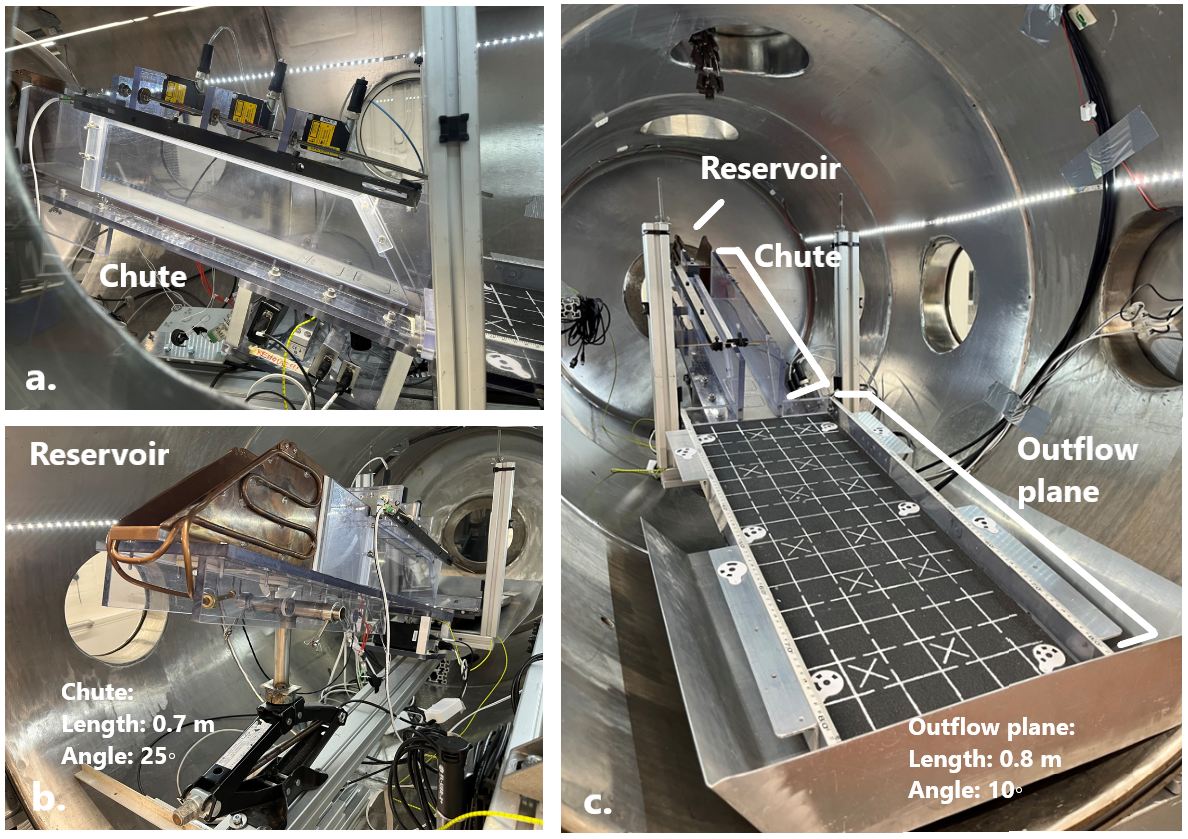
Figure 1: The laboratory debris flow flume in the Mars chamber at the Space and Planetary Environments Laboratory at the Open University (UK). (a-b) display the chute including the instruments and the sediment-ice reservoir. (c) shows the entire flume looking upslope.
To represent atmospheric pressures on different planetary bodies, we applied a range of pressures
between 3 to 1000 mbar. The granular flows were simulated by mixing dry CO2 ice with granular materials to create sediment mixtures with different permeabilities and densities.
Two groups with angular sediments (quarry sand and walnut shells) and rounded sediments (solid and
hollow glass beads) were chosen so that we could also determine the effects of the sediments’ shape
on the granular flows. To assess the effect of lower gravity, each group has a higher-density sediment
used as reference (quarry sand of 2600 kg/m3 and solid glass beads of 2500 kg/m3
), and a lower-density sediment (crushed nutshell of 1300 kg/m3 and hollow glass beads of 410 kg/m3
). The particle distribution for the angular sediment was similar for all sediment mixtures and fixed to 25% fine (200 -
450 µm), 50% medium (450 - 800 µm) and 25% coarse (800 - 1300 µm). The rounded sediment had a
particle size range between 500 - 850 µm. Gravitational acceleration and density have the same effect
on the force needed to levitate the flowing sediment. Thus, to simulate low-gravity bodies, we utilize
low-density sediments.
Results and discussion
Our preliminary results reveal an overall increase in fluidization of the granular flows for decreasing
pressures. This is more prominent in the low-density sediments. At 3-10 mbar, we notice a
fluidization regime similar to bubbling, where the CO2 gas builds up in the flow and escapes following
a small outburst [Van Ommen et al. (2010)].
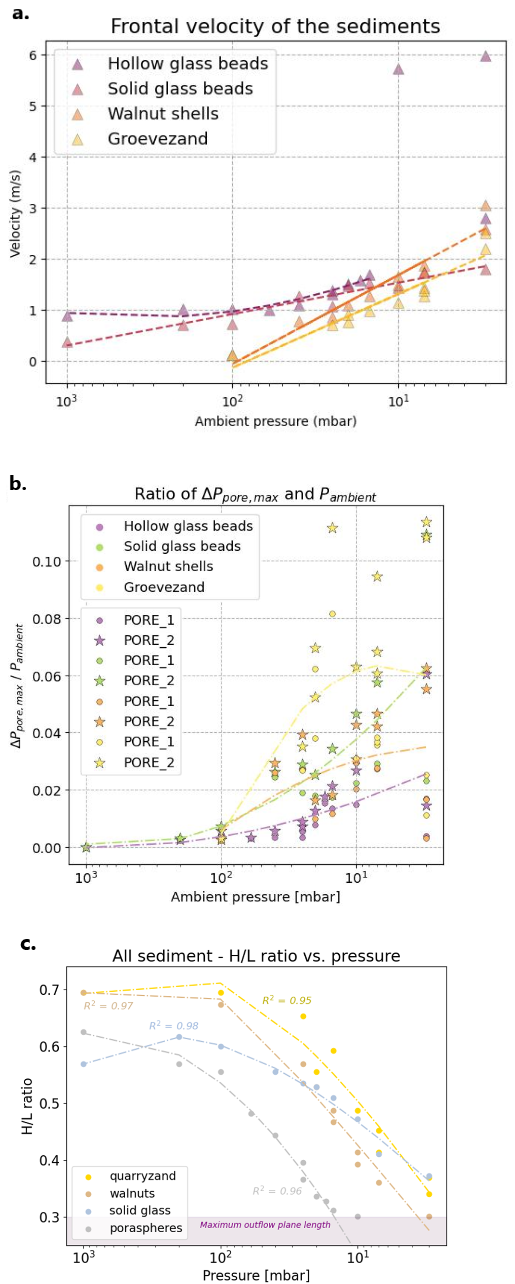
Figure 2: (a) frontal flow velocities, (b) overpressure: the ratio of the maximum
differential pore pressure (difference between basal and ambient pressure) vs. ambient pressure and
(c) runout: the H/L ratio of all the sediments.
The enhanced fluidization at low pressures is also apparent in the increased frontal flow velocities,
increased overpressure and increased runout length (H/L ratio, where H is 0.43 m and L is runout
length) (Figure 2). The internal pore pressure increases relative to ambient pressure (Figure 2b) which
decreases the internal particle friction and enhances the flow’s velocity (Figure 2c).
The levitation effect is observed here as increasing flow depth for decreasing pressures. This confirms the prior hypothesis that, at low ambient pressures, the gas outflux from sublimating CO2 ices increases, which levitates the sediment particles and reduces intergranular friction and particle
collisions [de Haas et al. (2019); Roelofs et al. (2024)].
Conclusion
Experiments have been performed to study the effects of gravity by mixing CO2 ice and granular
material with different permeabilities and densities. Low-density sediments, representing lower gravity,
display a longer deposit runout and higher frontal flow velocities and flow depths compared to high-density sediments. At low atmospheric pressures (3-10 mbar), we observe a transition in the
flow behaviour known as turbulent bubbling in the low-density sediments. These findings show that
atmospheric conditions and gravity on different planetary bodies lead to changes in the mobility and
flow behaviour of granular flows, which may be observable in the deposit dimensions. Further analyses
will focus on PIV data to study the appearance of bubbling at low pressures in more detail and elevation
models of the deposits from imagery to study their morphology.
How to cite: Diamant, S., Sylvest, M., Conway, S., Roelofs, L., Emerland, Z., Patel, M., Kleinhans, M., and de Haas, T.: Effects of gravity in CO2-sublimation driven granular flows in a simulated experimental environment, Europlanet Science Congress 2024, Berlin, Germany, 8–13 Sep 2024, EPSC2024-399, https://doi.org/10.5194/epsc2024-399, 2024.
Introduction
Silicates are the main constituent of volcanic terrains on terrestrial planets in the Solar system. On Earth, we know that volcanic terrains are constituted by lava flows and fragmented pyroclasts whose texture presents both glassy and crystalline phases. Understanding the influence of glass/crystal ratio on the spectral response of volcanic rocks is therefore focal to interpret remotely sensed spectra that are commonly used to interpret the geology of terrestrial planets. Thus, we performed spectral characterization of lab-made mafic volcanic products which were synthesized in the petro-vulcanology research group (PVRG) labs to present different degrees of crystallinity.
Samples preparation and characterization
Samples were created by mixing powdered oxides to mimic the composition of a Nakhlite meteorite. The powder was melted at 1450°C to form a silicate melt, which was then quickly cooled to produce a glass and divided into four sub-samples. As observable in Fig. 1, one sub-sample was rapidly cooled in air to form Nglass, while the other three were slowly cooled (52-60°C per hour) to target temperatures of approximately 1200°C (N12), 1100°C (N11), and 1000°C (N10).
Figure 1: Cooling ramps for the syntheses of products with different crystallization degree
The synthesized samples were analyzed using X-ray powder diffraction (XRPD), and quantitative phase analysis (QPA) was performed using the Rietveld profile fitting method with internal standards to determine amorphous content. Crystallized samples (N10, N11, and N12) showed peaks corresponding to various crystalline phases including Augite, Cristobalite, Magnetite, and Hematite. Quantitative analyses are reported in as reported in Figure 2.
Figure 2: Mineralogical assemblage of the produced samples
Reflectance analysis
Spectroscopic characterization was performed with SHINE (SpectropHotometer with variable INcidence and Emergence) at the Cold Surface Spectroscopy facility (CSS) of IPAG laboratory. This setup allows the collection of spectra in the visible (VIS) and near-infrared (NIR) ranges (0.35–4.5 µm) across a broad range of illumination (0–30°) and emergence angles (e=0-70°) at room temperature. Both illumination and emergence angles are zenithal angles, measured from the normal direction to the surface. Approximately 2 g of powdered samples (grain size < 80 µm). All acquired spectra are shown in Figure 3 where they are divided in four subgraphs representing the four samples N10, N11, N12 and Nglass.
Figure 3: VNIR spectra of four samples at different acquisition geometries.
Principal component analyses (PCA)
Our set of spectra was analyzed using PCA and K-Means clustering to visualize differences and similarities between the spectra from an unsupervised machine learning perspective. Principal component analysis was then performed without normalization, retaining the first two PCs, which encompass ~99.82% of the total variance (Figure 3a). The elbow method was used to determine the optimal number of clusters, resulting in 3 clusters (Figure 4). This led to a well-defined classification with only 3 misclassified samples. The mean spectra from each cluster were visibly similar to the spectra of each class, with low standard deviation for Nglass and N12, and higher for the cluster comprising N10 and N11. The resulting PCs are explainable from the loadings, showing that the first PC mainly represents the shape of a Nglass spectrum, while the second PC considers the height of the shoulder before ~800 nm and the dip after that point.
.
Figure 4: Clustering of spectra after PCA analyses
Future perspectives
We have observed how, for samples with identical chemical composition and different mineralogical assemblage, the spectral response within Visible and Near InfraRed (VNIR) can be substantially different. The mechanism influencing the shape of spectra results in fact from a complex interaction of the spectral response of different mineral/amorphous phases. In this way, the shape is easily misinterpreted as the features of the different phases which are often no longer recognizable. A PCA analyses helped us to understand which are the features that can be accounted for the interpretation of this kind of igneous materials, but a more comprehensive study on different compositions is needed for a complete assessment of this approach.
Acknowledgements
This work was carried on thanks to ASI-UniPG agreement 2019-2-HH.0 and in the framework of Trans-National Access research project selected and funded by Europlanet-2024 RI (European Union’s Horizon 2020 RI under grant agreement No. 871149)
How to cite: Pisello, A., Fastelli, M., Baroni, M., Schmitt, B., Beck, P., Zucchini, A., Petrelli, M., Comodi, P., and Perugini, D.: Building analogs in the lab: spectral characterization of a synthetic Nakhlite., Europlanet Science Congress 2024, Berlin, Germany, 8–13 Sep 2024, EPSC2024-1194, https://doi.org/10.5194/epsc2024-1194, 2024.
Abstract
A new set-up of open-ended coaxial line based on the capacitive-load model is developed to measure dielectric properties of materials at elevated temperatures up to 500 oC over the frequency range of 1 - 100 MHz. The complex reflection coefficients are measured by a Vector Network Analyzer and are translated to the complex permittivity of the material under test using transmission line theory. Measurements are conducted on a basaltic rock sample that can be considered a Venusian analog.
INTRODUCTION
Analysis of dielectric behavior of planetary crusts-rock analogs at planetary ambient conditions is critical to determine their impact on the propagating electromagnetic waves. A variety of measurements have been made on planetary analogs and samples at low temperatures like temperatures at Mars, Moon. However, very little is known about the dielectric properties of rocks and minerals for planetary analog materials at radar frequencies and elevated temperatures. While, for example, Envision the upcoming ESA mission (Thakur et al., 2023), aiming to study the Venus subsurface, needs measurements on some analogs at 9 MHz operating frequency and at Venusian rocks temperature that reaches to ∼500 oC.
The reflection type of the transmission line method is based on the reflection of incident electromagnetic waves from the media interface that is caused by impedance discontinuity at two sides of the interface (e.g., Von Hippel, 1954; Orfanidis, 2002).
In this study, a new set-up is developed based on (Gershon et al., 1999) open-ended coaxial probe (a truncated transmission line) to measure the complex relative dielectric permittivity materials using the capacitive model.
THEORY
In a coaxial line electric fields are in the radial direction between the inner and outer conductor, and magnetic fields form circles around the inner conductor. The 1-port network analyzer measures the reflection coefficient, S11, that is related to the input impedance at the probe. For a coaxial line of length d that ends with a load impedance ZL, the probe input impedance seen looking toward the load is expressed as (Orfanidis, 2002):
where Zc is the characteristic impedance of the transmission line, and k is the complex propagation constant of the electromagnetic wave. For a short-circuited transmission line ZL =∞, hence the load admittance can be obtained by:
where Zin and Zsh are the input impedance of the probe and short-circuited line. For differing impedances at two sides of the interface, there will be a reflection when an electromagnetic wave propagates through the interface. A commonly used technique to compute the complex permittivity of a medium is based on measuring the reflection coefficient using a network analyzer. When the open end of the coaxial line probe is connected to a sample, the capacitive model configuration of open-ended coaxial line in the reflection method can be used to characterize the dielectric properties of the material. In terms of a capacitive model, the complex relative permittivity of the sample will be
where ω is angular frequency, and C0 is the probe capacitance. Using a reference material with the known permittivity (e.g., air with εrref = 1) the reference admittance of YrefL is computed from the corresponding measured reflection coefficients.
Experimental Procedure
Figure 1 displays a schematic diagram of the probe and the probe that has been made. The reflection coefficients are measured using an Agilent E5071C Programmable Vector Network Analyzer (VNA) over the frequency range of 1-100 MHz with log frequency sweep and 1601 frequency points. Before the measurement, a preliminary calibration is performed to correct the effects of coaxial cable, connectors, adaptor, and VNA systematic errors. A sample (a basaltic rock sample collected from Mount Etna volcano on the east coast of Sicily, Italy) is placed in an insulated Nabertherm furnace, and measurements are acquired at temperatures in the range of 100-500 oC with an interval of 50 oC. This sample can be considered as a dry Venusian analog mineral in the Venusian environment.
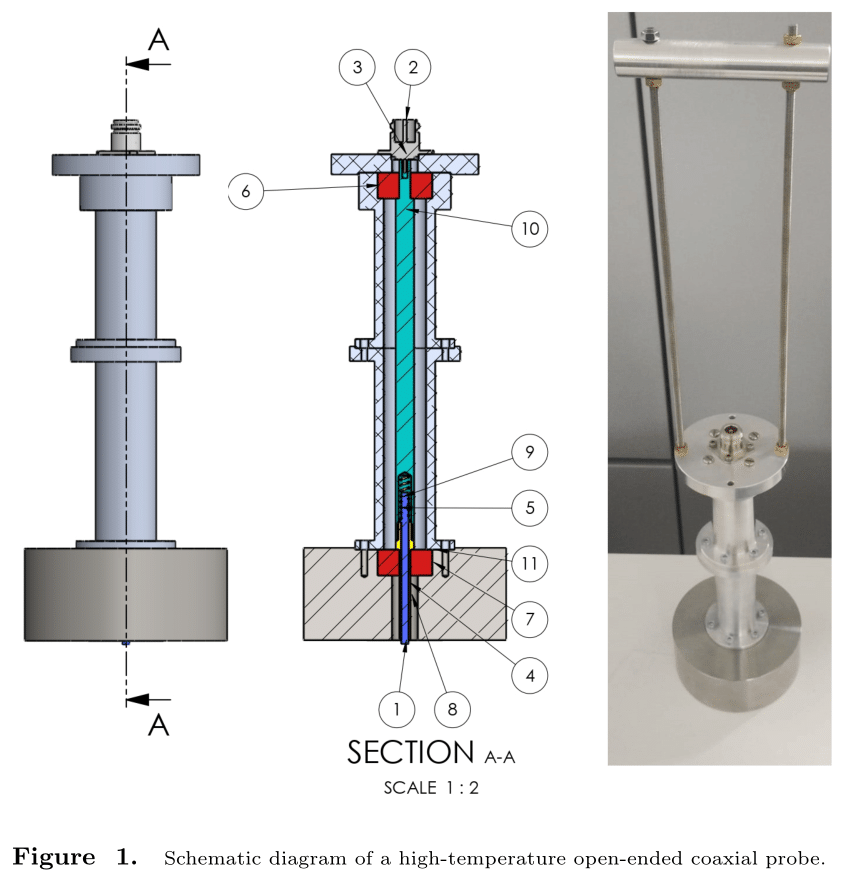
Figure 2 presents the spectrum of the real part of permittivity and loss tangent computed from the measured reflection coefficient at different temperatures. At room temperature, the ε′r is almost constant, however, by increasing temperature the dispersion effects become significant. In addition, the calculated tanδ at T = 27 oC presents a constant value of ∼0.02 at frequencies above 15 MHz. At lower frequencies, some instabilities appear that are related to the instrument’s limitations.
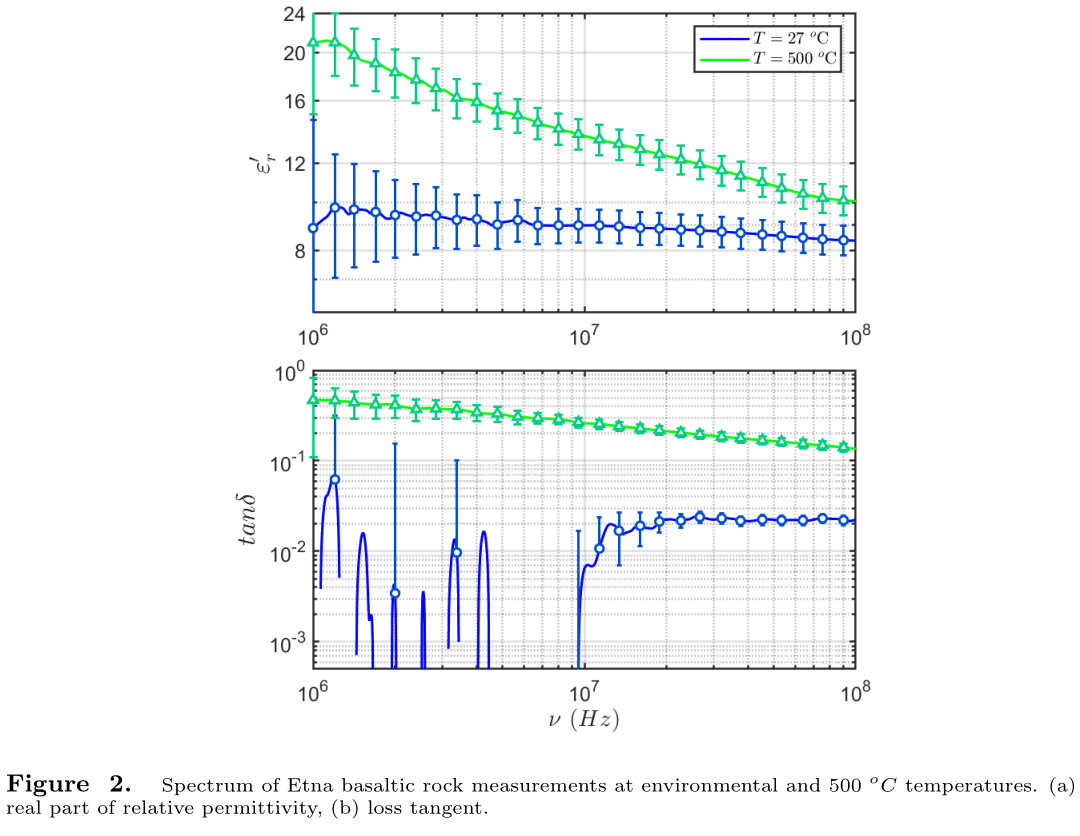
Dielectric properties of Etna basaltic rock at temperatures from 27 oC to 500 oC and for nominal operating frequencies of ν= 9, 20, and 60 MHz with a 5 MHz bandwidth, are shown in Figure 3. The results show an increase in relative permittivity and loss tangent as frequency decreases and temperature increases. The loss tangent values are strongly influenced by temperature and are almost one order of magnitude larger at 500 oC than those at 27 oC.
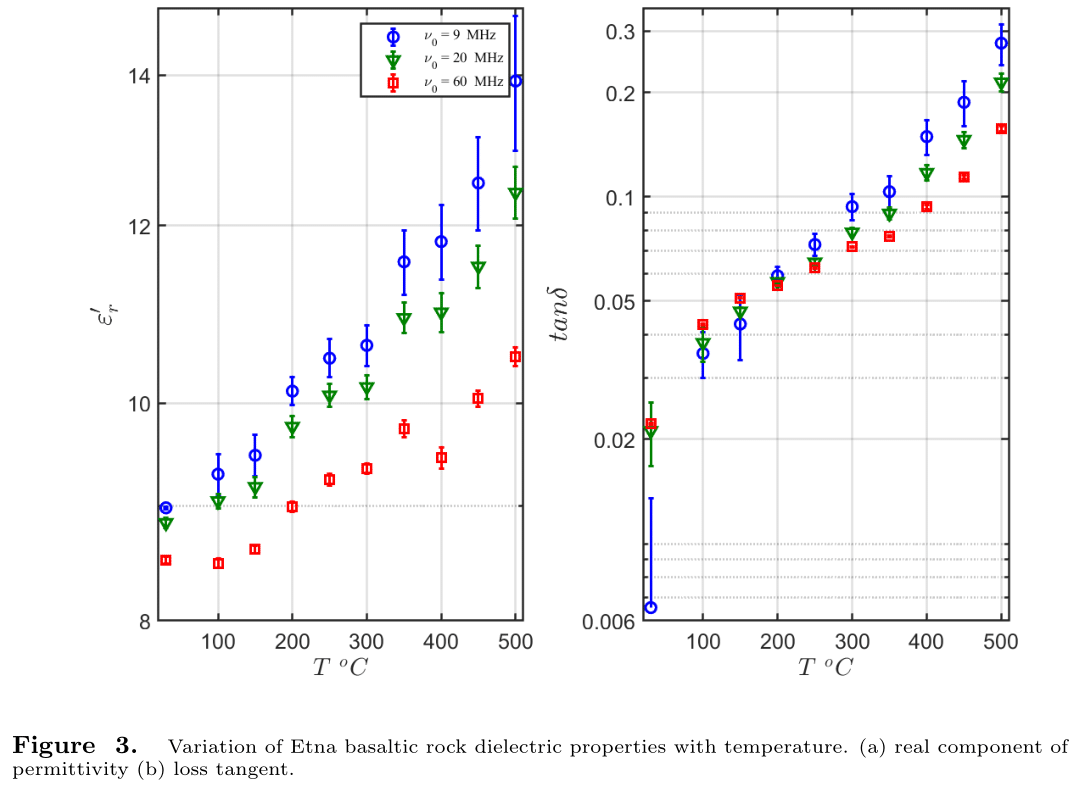
Conclusion
Dielectric properties of a basaltic rock sample were determined by measuring the reflection coefficients over the temperature range 27 oC to 500 oC. An increase in the real component of relative permittivity and loss tangent was observed with temperature, which is higher at low frequencies. In addition, sample complex permittivity shows a temperature-dependent dispersion. This method can be used particularly for Venusian crust analogs. The results are critical to configuring the radar system.
References
Gershon, D. L., Calame, J., Carmel, Y., Antonsen, T., & Hutcheon, R. M. (1999). Open-ended coaxial probe for high-temperature and broad-band dielectric measurements. IEEE transactions on microwave theory and techniques, 47 (9), 1640–1648.
Orfanidis, S. J. (2002). Electromagnetic waves and antennas.
Thakur, S., Sbalchiero, E., & Bruzzone, L. (2023). Exploring Venus subsurface: Analysis of geological targets and their properties. Planetary and Space Science, 225 , 105620.
Von Hippel, A. R. (1954). Dialectics and waves. John Wiley and Sons.
How to cite: Baniamerian, J., Emanuel Lauro, S., Cosciotti, B., Brin, A., Lefevre, C., Pettinelli, E., and Mattei, E.: An experimental set-up for dielectric characterization of Venusian crust analogs at high temperatures, Europlanet Science Congress 2024, Berlin, Germany, 8–13 Sep 2024, EPSC2024-4, https://doi.org/10.5194/epsc2024-4, 2024.
The predecessor of Laplace, ICAPS, was flown in 2019 and 2023 on the Texus-56 and Texus-58 sounding rockets. The Laplace facility is planned for a usage on the ISS with a launch in 2025. Both experiments allow to investigate the very first stages of planet formation. The relevant growth processes require observation of many-particle processes consisting of millions of µm-sized particles in a low-density gas environment (typically a few 10s of Pa, such that Knudsen numbers of >>1 are achieved) for prolonged time. The latter requirement makes it necessary to perform these investigations in a microgravity environment. The ICAPS and Laplace setups allow to actively protect the dust cloud against diffusion and other external residual forces and also allow concentration of the dust cloud by means of an actively-controlled thermophoretic trap acting on all three axes.
Simultaneously, the dust cloud is made available to a number of observational instruments. As a whole, the cloud is observed in 3D from two perpendicular overview cameras while also making a small central volume of 1 mm² cross-section accessible to a dedicated long-distance microscope with high-speed imaging to facilitate non-destructive in-situ analysis of the growing dust aggregates. An extinction sensor allows to measure the light extinction throughout the cloud as a whole. Measurements of the electric charges of the individual particles can be conducted repeatedly by means of a controlled DC or AC field in order to determine charge and charge evolution.
We will present the design and techniques of the Laplace setup, the current status of the Laplace facility and demonstrate its capabilities on a few select data from the flights of ICAPS.
How to cite: von Borstel, I., Blum, J., Schräpler, R., Aktas, C., Balapanov, D., Vedernikov, A., Brisset, J., Molinski, N., and Schubert, B.: Update on the Laplace experiment as a facility to investigate the initial stage of planet formation, Europlanet Science Congress 2024, Berlin, Germany, 8–13 Sep 2024, EPSC2024-864, https://doi.org/10.5194/epsc2024-864, 2024.
Please decide on your access
Please use the buttons below to download the supplementary material or to visit the external website where the presentation is linked. Regarding the external link, please note that Copernicus Meetings cannot accept any liability for the content and the website you will visit.
Forward to presentation link
You are going to open an external link to the presentation as indicated by the authors. Copernicus Meetings cannot accept any liability for the content and the website you will visit.
We are sorry, but presentations are only available for users who registered for the conference. Thank you.
The exploration of the outer solar system will be a strong focus of planetary exploration in the coming decades. NASA New Horizon has revolutionized our understanding of the Pluto-Charon system and has obtained the first resolved images of a Kuiper Belt Object. The ESA JUICE mission was successfully launched in 2022 to explore the Jovian system. The NASA Lucy mission is on its way to explore a number of Trojan asteroids. JAXA is currently studying a mission to Trojan with the option of sample return. NASA will soon launch the Europa Clipper mission. NASA and ESA are in discussion for a mission to study Uranus and Neptune.
All these missions create a strong demand for laboratory spectra of analog materials obtained at low pressure or in vacuum at cryogenic temperatures. As a response to this demand by the planetary science community, the Planetary Spectroscopy Laboratory (PSL) of DLR is currently adding a new chamber with spectral capabilities towards low-T reflectance measurements under vacuum conditions.
This new compact low-temperature vacuum chamber allows bi-directional reflectance measurements. This chamber is attached to a Bruker VERTEX 80V Fourier spectrometer allowing measurements from UV to far infrared. A two-stage turbo vacuum pump allows high vacuum to be obtained in the system. In a future extension backfilling with gas mixtures would allow simulating the extreme low-pressure atmospheres of the outer solar system bodies.
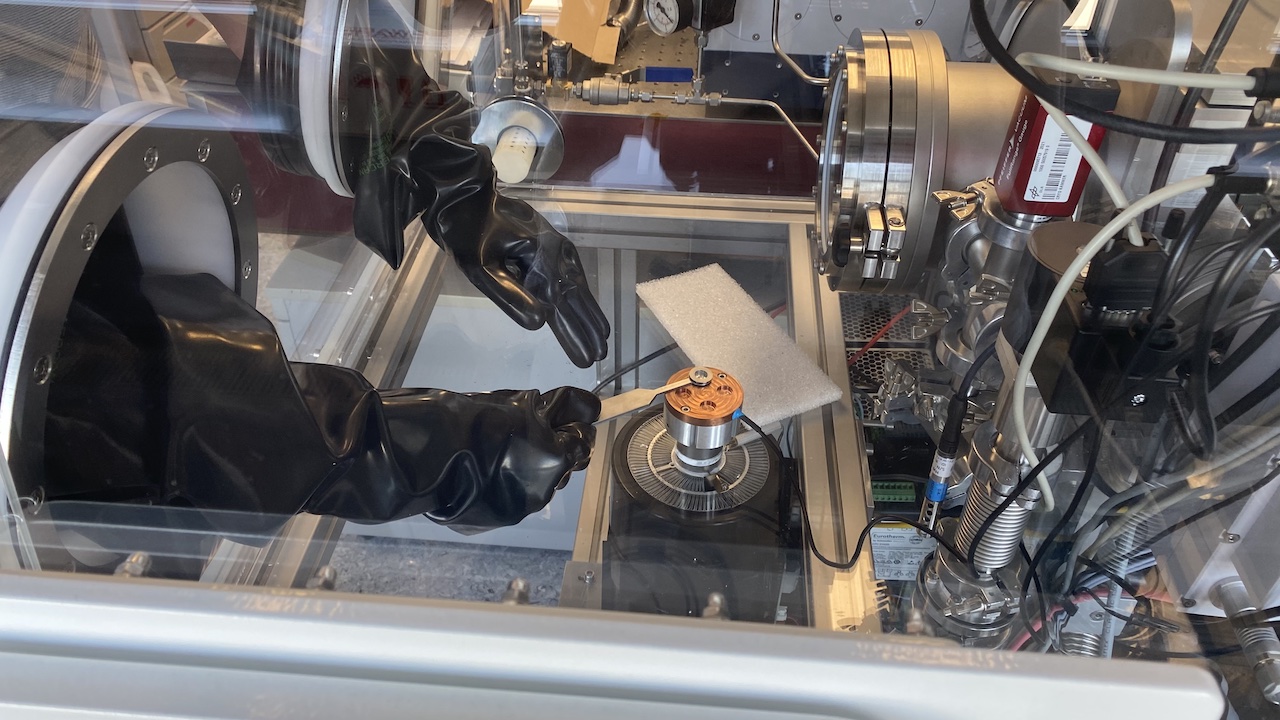
The picture shows a view of the glove box for sample preparation that was added to the system based on the lessons learned during early tests for cryogenic measurements at PSL. Key is a cold finger with a cryocooler which allows preparation of icy samples as well as ice-dust mixtures under a dry air atmosphere. The prepared samples are fed into the vacuum chamber via the air lock at the back of the glove box. This provides maximumflexibility in preparing cryogenic samples while minimizing the risk of contamination and frost forming on the samples.
How to cite: Helbert, J., Lorek, A., Maturilli, A., Garland, S., and Alemanno, G.: Cryogenic reflectance spectroscopy under high vacuum conditions for outer planets exploration, Europlanet Science Congress 2024, Berlin, Germany, 8–13 Sep 2024, EPSC2024-1146, https://doi.org/10.5194/epsc2024-1146, 2024.
Since the Hayabusa2 mission was sent, the understanding of Ryugu nature, i.e., size, shape, mass (Watanabe et al. 2019), grain morphology (Nakato et al. 2023), composition (Noguchi et al. 2023; Potiszil et al. 2023), parent-body origin (de León et al. 2018; Tatsumi et al. 2021) and evolution (Morota et al. 2020; Nakamura et al. 2023), have been enlarged thanks to onboard measurements, as well as laboratory measurements on returned samples. Herein, we are interested in the mineral and the organic composition of Ryugu. For this interest, laboratory spectral measurements are of great use.
In this study, we are focused on which functional groups are present in Ryugu returned samples, therefore in the infrared wavelength range. For this, transmission IR measurements can be performed with conventional Fourier transform infrared spectrometers, FTIR, which can be coupled with IR microscopes, micro-FTIR. Both IR techniques have been largely used for compositional studies on extraterrestrial matter, as chondrites and IOM of chondrites (e.g., Beck et al., 2010, 2014; Kebukawa et al., 2011; Orthous-Daunay et al., 2013; Quirico et al., 2014, 2018). However, these techniques are constrained by their diffraction limit affecting the spatial resolution and leading to a diffraction-limited spatial resolution of 0.61l/NA, being l the wavelength and NA the numerical aperture (Centrone 2015). In the case of a source of wavelength between 2.5 to 16.7 mm, this resolution is in the first tens of micrometers.
In the search for overcoming the diffraction limit, other techniques have been developed as is the case of the infrared atomic force microscope AFM-IR (A. Dazzi et al. 2005). The AFM-IR instead of measuring the absorbed light with optical detectors, it measures the mechanical expansion of the sample caused by an IR source that is directly proportional to the absorbance. The expansion is then detected by the AFM cantilever tip and the mechanical motion (deflection) of the whole cantilever (which carries the sample photothermal expansion information) is detected. Then the deflection amplitude is transformed (by Fourier transform) at each wavenumber giving the infrared spectrum (Mathurin et al. 2022). Since the AFM tip is the direct detector of the sample expansion, the resolution is limited by the tip radius of curvature (smaller or equal to 20 nm) as well as the sample thermo-mechanical properties and thickness, rather than the wavelength (A. Dazzi et al. 2010). This indicates that AFM-IR has a lateral resolution at the nanometer scale, being able to analyze from micro- to nanoscale heterogeneities on a sample (A. Dazzi et al. 2017).
AFM-IR measurements have been performed on extraterrestrial matter as is the case for chondrites, for example on Orgueil and EET 92042 (Phan et al. 2022), on ultra-carbonaceous Antarctic micrometeorites (Mathurin et al. 2019), on Murchison and Bell (Kebukawa et al. 2019); and on one asteroid, the one of our interest, Ryugu (Dartois et al. 2023; Kebukawa et al. 2023; Phan et al. 2024). Based on the different IR spectral measurements that have been done on Ryugu returned samples (Dartois et al. 2023; Kebukawa et al. 2023; Phan et al. 2024; Quirico et al. 2023; Yabuta et al. 2023), three main functional groups on organic matter have been identified (carbonyl, aromatic and aliphatic groups) and three others on the mineral composition (carbonate, silicate and sulfate groups, the last one being possibly due to terrestrial oxidation).
Herein, we present an AFM-IR and micro-FTIR studies on one Ryugu returned sample prepared as FIB sections and a grain of the same sample prepared in two different ways; first, one portion of the grain is pressed between two diamond windows, and second, another part is used for HF/HCL extractions to analyze its insoluble organic matter (IOM). Another part of our work consists in investigating AFM-IR measurements issues. Indeed, infrared spectra collected by AFM-IR may present substantial differences compared to spectra collected with conventional micro-FTIR. To date, these differences are not fully elucidated, but they clearly depend on morphological parameters and on sample heterogeneity, and they are a particular issue in the case of complex natural samples. We will report on recent results, obtained from measurements on cosmo-materials and terrestrial natural and synthetic carbonaceous materials like polymers.
Beck, P. et al. 2010. Geochim. Cosmochim. Acta. 74(16): 4881–92.
Beck, P. et al. 2014. Icarus 229: 263–77.
Centrone, Andrea. 2015. Annu. Rev. of Anal. Chem. 8: 101–26.
Dartois, Emmanuel et al. 2023. Astron. Astrophys. 671(2): 1–30.
Dazzi, A. et al. 2010. J. Appl. Phys. 107(12).
Dazzi, A. et al. 2005. Opt. Lett. 30(18): 2388–90.
Dazzi, A. et al. 2017. Chem. Rev. 117(7): 5146–73.
Kebukawa, Y. et al. 2019. Proc. Natl Acad. Sci. USA. 116(3): 753–58.
Kebukawa, Y. et al. 2023. Meteorit. Planet. Sci. 14: 1–14.
Kebukawa, Y. et al. 2011. Geochim. Cosmochim. Acta. 75(12): 3530–41.
de León, J. et al. 2018. Icarus 313: 25–37.
Mathurin, J. et al. 2019. Astron. Astrophys. 622(A160): 1–9.
Mathurin, J. et al. 2022. J. Appl. Phys. 131: 1–24.
Morota, T. et al. 2020. Science 368(6491): 654–59.
Nakamura, T. et al. 2023. Science 379(6634): 1–14.
Nakato, A. et al. 2023. Earth, Planets and Space 75(45).
Noguchi, T. et al. 2023. Meteorit. Planet.
Orthous-Daunay, F. R. et al. 2013. Icarus 223(1): 534–43.
Phan, V.T.H. et al. 2022. Meteorit. Planet. 57(1): 3–21.
Phan, V.T.H. et al. 2024. Meteorit. Planet. 19.
Potiszil, C. et al. 2023. Life 13(7): 1–31.
Quirico, E. et al. 2018. Geochim. Cosmochim. Acta. 241: 17–37.
Quirico, E. et al. 2014. Geochim. Cosmochim. Acta. 136: 80–99.
Quirico, E. et al. 2023. Meteorit. Planet. 18: 1–18.
Tatsumi, E. et al. 2021. Nat. Commun. 12(1).
Watanabe, S. et al. 2019. Science 364(6437): 268–72.
Yabuta, H. et al. 2023. Science 379(6634).
How to cite: Tobon Valencia, V., Quirico, E., Beck, P., Phan, V. T. H., Le Guillou, C., and Troadec, D.: AFM-IR measurements on Ryugu grains and other natural and synthetic samples, Europlanet Science Congress 2024, Berlin, Germany, 8–13 Sep 2024, EPSC2024-20, https://doi.org/10.5194/epsc2024-20, 2024.
The complexity and origin of organic matter in carbonaceous chondrites has been a topic of interest for over 60 years1. This organic matter has been studied through the bulk, the Insoluble Organic Matter (IOM) and the Soluble Organic Matter (SOM) using different analytical techniques.
The procedures for extracting the soluble fraction significantly influence the quantity and diversity of extracted organic matter, thereby impacting the interpretation of the data in terms of origin and evolution. They vary depending on the analytical approach (targeted or untargeted) and the analytical instruments used for the characterization2–4.
So far, most of the work done on the analysis of organic matter from carbonaceous chondrites has focused on targeted approaches. For example, numerous studies have worked on the optimization of the extraction of water-soluble organic matter (such as amino acids, sugars, nucleobases…) usually extracted with boiling water and acid hydrolysis and then analysed by gas chromatography coupled to mass spectrometry (GC-MS)5–7. Other studies have worked on the solvent-soluble organic matter for the characterization of specific hydrocarbons and aromatics, also using GC-MS8,9. In 2010, Schmitt Kopplin et al. studied the influence of the extracting solvent on the resulting molecular diversity of the SOM using Ultra-High Resolution Mass Spectrometry, and were able to conclude that methanol was the most efficient extracting solvent10. No other untargeted study has focused on the impact of the extracting protocol since then. Similar conclusions can be drawn regarding the elemental and isotopic analysis of the SOM, that have mostly been studied using targeted approaches6,11,12. Untargeted elemental and isotopic analysis applied to SOM was used by Becker & Epstein in 198113, and was never systematically applied to other SOM extracts since then.
In the present work, our objective is to implement an untargeted workflow to carry out comprehensive analyses of the soluble organic matter using mass spectrometry techniques.
Firstly, to better understand the influence of chemical extraction on the resulting SOM, we are optimizing different parameters of the extraction procedure (pH, grain size, extraction time, solvent, etc.) and characterizing the resulting soluble organic fractions using a sample of Murchison (ME 2644 #23.13) allocated by the Field Museum. With Orbitrap Ultra-High Resolution Mass Spectrometry, we can assess qualitative information on the molecular diversity and mass distribution of the sample. Thus, the high mass resolution of this instrument (100 000 at m/z = 400) enables to conduct family analysis and to look for polymerization patterns14. We also aim to develop a new method to characterize the SOM with an Elemental Analyzer – Isotope Ratio Mass Spectrometry (EA-irMS). This technique will provide quantitative information on the elemental (%C, %N…) and isotopic (13C/12C, 15N/14N…) compositions of the sample, enabling comparisons with previous data on IOM and bulk compositions.
With this untargeted workflow of combined analyses, we will provide new insights into the molecular diversity, mass distribution, and elemental composition of the SOM of carbonaceous chondrites. Later on, we will apply these procedures on CM chondrites having experienced various degrees of alteration. This will enable systematic comparison of the effect of post-accretion processes (aqueous alteration and thermal process) on the organic complexity. Moreover, having an optimized and standardized extraction procedure to characterize the SOM as a whole is important for working on pristine samples such as those from Bennu and Ryugu.
[1] H. Studier, M., Hayatsu, R. & Anders, E. Origin of organic matter in early solar system—V. Further studies of meteoritic hydrocarbons and a discussion of their origin. Geochim. Cosmochim. Acta 36, 189–215 (1972).
[2] Naraoka, H. et al. Soluble organic molecules in samples of the carbonaceous asteroid (162173) Ryugu. Science 379, eabn9033 (2023).
[3] Gardinier, A. et al. Solid state CP/MAS 13C NMR of the insoluble organic matter of the Orgueil and Murchison meteorites: quantitative study. Earth Planet. Sci. Lett. 184, 9–21 (2000).
[4] Cody, G. D., Alexander, C. M. O. & Tera, F. Solid-state (1H and 13C) nuclear magnetic resonance spectroscopy of insoluble organic residue in the Murchison meteorite: a self-consistent quantitative analysis. Geochim. Cosmochim. Acta 66, 1851–1865 (2002).
[5] Martins, Z., Modica, P., Zanda, B. & d’Hendecourt, L. L. S. The amino acid and hydrocarbon contents of the Paris meteorite: Insights into the most primitive CM chondrite. Meteorit. Planet. Sci. 50, 926–943 (2015).
[6] Hilts, R. W., Herd, C. D. K., Simkus, D. N. & Slater, G. F. Soluble organic compounds in the Tagish Lake meteorite. Meteorit. Planet. Sci. 49, 526–549 (2014).
[7] Simkus, D. N. et al. New insights into the heterogeneity of the Tagish Lake meteorite: Soluble organic compositions of variously altered specimens. Meteorit. Planet. Sci. 54, 1283–1302 (2019).
[8] Kalpana, M. S., Babu, E. V. S. S. K., Mani, D., Tripathi, R. P. & Bhandari, N. Polycyclic aromatic hydrocarbons in the Mukundpura (CM2) Chondrite. Planet. Space Sci. 198, 105177 (2021).
[9] Cronin, J. R. & Pizzarello, S. Aliphatic hydrocarbons of the Murchison meteorite. Geochim. Cosmochim. Acta 54, 2859–2868 (1990).
[10] Schmitt-Kopplin, P. et al. High molecular diversity of extraterrestrial organic matter in Murchison meteorite revealed 40 years after its fall. Proc. Natl. Acad. Sci. 107, 2763–2768 (2010).
[11] Krishnamurthy, R. V., Epstein, S., Cronin, J. R., Pizzarello, S. & Yuen, G. U. Isotopic and molecular analyses of hydrocarbons and monocarboxylic acids of the Murchison meteorite. Geochim. Cosmochim. Acta 56, 4045–4058 (1992).
[12] Huang, Y., Aponte, J. C., Zhao, J., Tarozo, R. & Hallmann, C. Hydrogen and carbon isotopic ratios of polycyclic aromatic compounds in two CM2 carbonaceous chondrites and implications for prebiotic organic synthesis. Earth Planet. Sci. Lett. 426, 101–108 (2015).
[13] Becker, R. H. & Epstein, S. Carbon, hydrogen and nitrogen isotopes in solvent-extractable organic matter from carbonaceous chondrites. Geochim. Cosmochim. Acta 46, 97–103 (1982).
[14] Isa, J. et al. Aqueous Alteration on Asteroids Simplifies Soluble Organic Matter Mixtures. Astrophys. J. Lett. 920, L39 (2021).
How to cite: Arthozoul, C., Vuitton, V., Bonal, L., Orthous-Daunay, F.-R., and Flandinet, L.: Exploring the influence of chemical extraction on the complexity of the Soluble Organic Matter (SOM) in carbonaceous chondrites, Europlanet Science Congress 2024, Berlin, Germany, 8–13 Sep 2024, EPSC2024-29, https://doi.org/10.5194/epsc2024-29, 2024.
Introduction:
The layers of the Martian North Polar Layered Deposits (NPLD) are composed mainly of water ice and variable content of lithic inclusions probably because of astronomical parameters and thus climate variations. These variations are the causes of compositional and physical differences among polar layers [1], that could be detected by instruments onboard spacecraft. An example could be the Compact Reconnaissance Imaging Spectrometer for Mars (CRISM) onboard the NASA Mars Reconnaissance Orbiter (MRO). CRISM instrument is a spectrometer to study the composition of the whole Mars surface [2]. It works in a spectral range from 400 to 4000 nm, with a spectral sampling of 6.55 nm/channel and a spatial resolution of 18.4 m/px. Spectra acquired on the polar deposits can be compared with laboratory icy analogs. Therefore, in this work, we tried to retrieve the composition and the amount of dust included in the layers of the upper part of the North Polar Layered Deposits (NPLD).
Martian Simulants:
We analyzed Martian simulants that were commercially available in order to characterize deeply their compositions before any analysis:
- Mars Global High-Fidelity Martian Dirt Simulant (MGS-1): average composition of Mars [3];
- Mojave Mars Simulant (MMS-1): composition regolith of Phoenix landing site [4];
- Enhanced Mars Simulant (MMS-2): evolution of MMS-1 [4].
The chemical characterization was done using the Inductively Coupled Plasma Mass Spectroscopy, the mineralogical analysis was performed by X-ray diffraction (and SEM-EBS only for MGS-1 coarse grains) and the grainsize was studied through the Laser Diffraction Particle Size Analyzer. We used the finest grains (0-32 µm) of the simulant MGS-1 because it has spectral behavior similar to the atmospheric dust that could be entrapped in the polar layers [5].
Icy slabs:
We mixed a specific quantity of MGS-1 with deionized water to recreate the composition of the polar layers (e.g., see [6]). We froze the mixture at -80°C like the summer temperature at the Martian North Pole [7] or instantaneously in liquid nitrogen. The resulting icy slab was extremely narrow to avoid the precipitation and thus the separation between simulant and water ice. They have been acquired in the VNIR-SWIR range by hyperspectral imaging cameras. We tested the spectral variation with:
- variation in dust/ice ratio;
- increase of temperature;
- different freezing times and methods.
Laboratory set-up:
The accommodation stage of the Headwall Photonics Nano Hyperspec VNIR camera and the Micro Hyperspec SWIR camera was adapted to allow the hyperspectral acquisition of icy mixtures (Figure 1). The icy samples were placed over a cold holder, whose temperature was controlled by a thermocouple. We worked in nitrogen atmosphere to avoid the formation of condensation over the sample.
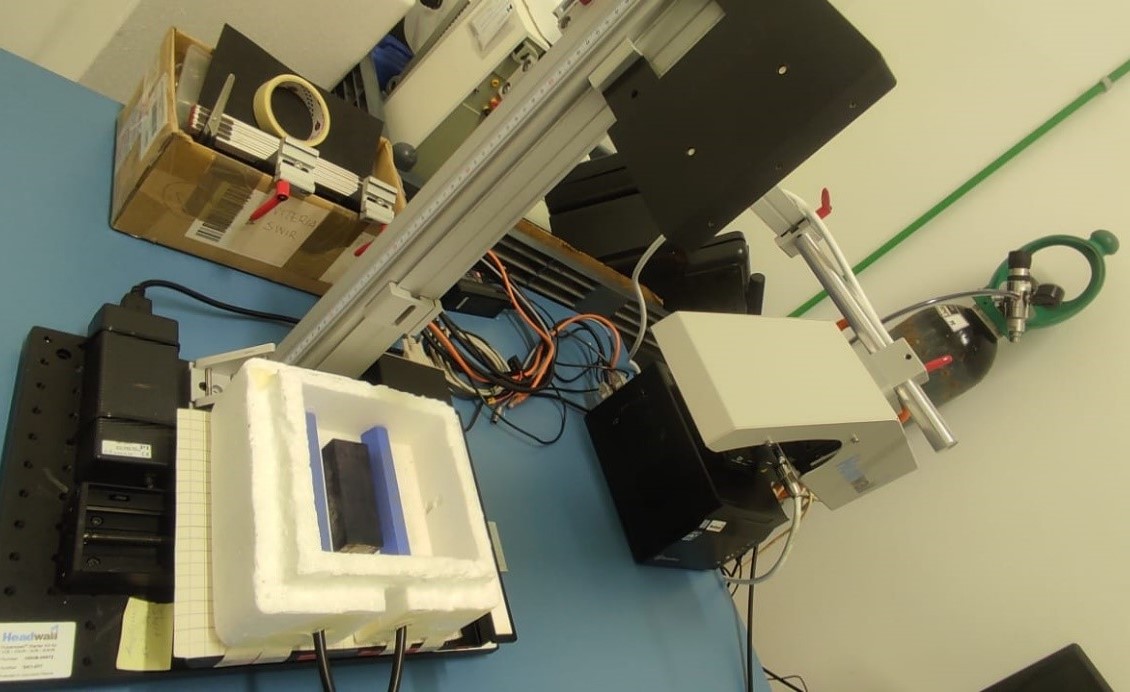
Figure 1. Hyperspectral camera and its modified stage to acquire spectra of icy slabs.
Preliminary results:
The 400-1000 nm spectra of the icy slabs are characterized by absorption bands of the iron contained in the simulant. These absorption bands increase their depth increasing the amount of dust in the mixture. The 1000-2500 nm spectra are characterized by absorption bands of the water ice, that become deeper with the decrease of dust content [7] (Figure 2). The temperature causes a general shift of the spectrum upwards [8].
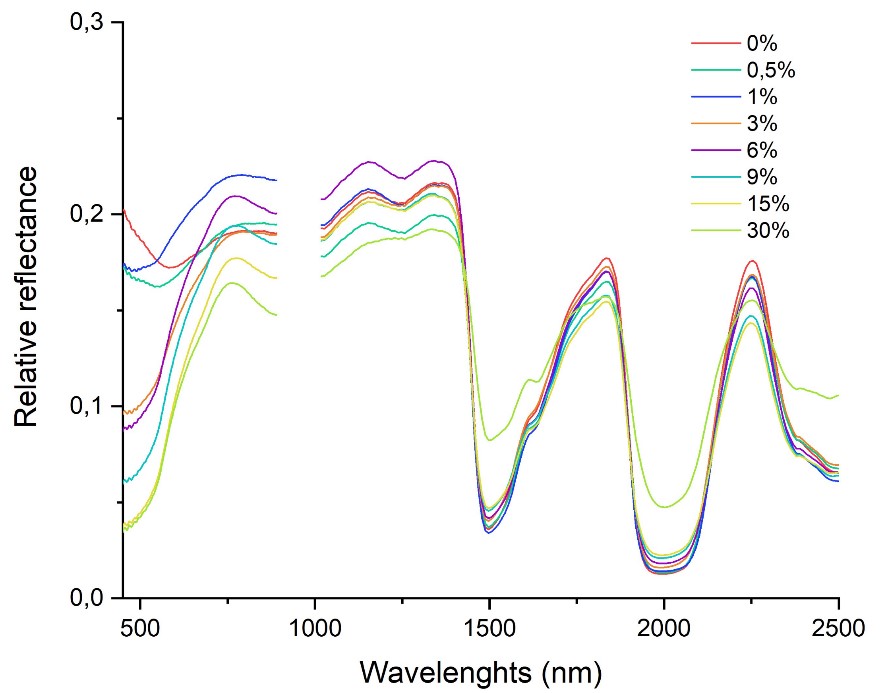
Figure 2. Spectra in the range from 400 to 2500 nm of mixtures with different concentrations of MGS-1.
Conclusions:
The laboratory set-up presented in this work is easy to build and the procedure is easy to replicate. All preliminary results are comparable with what is found in literature. Instead of ice grains, we have produced and analyzed icy slabs that could contain more than 30% dust. Moreover, icy slabs could be similar to polar layers instead of a simple mixture of powder and snow.
We plan to perform more detailed spectral analysis of icy mixtures eventually using other instruments (e.g., see [9]).
References:
[1] Byrne S. (2009) Annu. Rev. Earth. Planet. Sci., 37(1), 535-560, https://www.annualreviews.org/doi/pdf/10.1146/annurev.earth.031208.100101.
[2] Viviano-Beck C. E. et al. (2014) J. Geophys. Res., 119(6), 1403-1431, https://doi.org/10.1002/2014JE004627.
[3] Cannon K. M. et al. (2019) Icarus., 317, 470–478, https://doi.org/10.1016/j.icarus.2018.08.019.
[4] Peters et al. (2008) Icarus, 197, 470–479, https://doi.org/10.1016/j.icarus.2008.05.004.
[5] Costa et al. (2024) Data in Brief, submitted.
[6] Smith I. B. (2019) Geophys. Res. Lett., 48(15), https://doi.org/10.1029/2021GL093618.
[7] Horne D. et Smith M. D. (2009) Icarus 200(1), 118-128, https://doi.org/10.1016/j.icarus.2008.11.007.
[8] Yoldi Z. Et al. (2021) Icarus, 358, https://doi.org/10.1016/j.icarus.2020.114169.
[9] Brissaud O. et al. (2004) Appl. Opt. 43(9), 1926-1937, https://doi.org/10.1364/AO.43.001926.
How to cite: Costa, N., Bonetto, A., Ferretti, P., Casarotto, B., Massironi, M., Bohleber, P., and Altieri, F.: Laboratory hyperspectral analysis of icy mixtures with Martian Simulants, Europlanet Science Congress 2024, Berlin, Germany, 8–13 Sep 2024, EPSC2024-867, https://doi.org/10.5194/epsc2024-867, 2024.
Thermal and mechanical properties of carbonaceous chondrite analogues
Background
As small bodies with the most similar elemental abundance compared to the solar photosphere (Lodders et al., 2009), C-type asteroids are of great interest for studying the early formation of small bodies. However, there is little information about their structure.
Based on thermal infrared observations of the C-type asteroid Ryugu, a regolith-covered surface with cm-sized particles was predicted (Grott et al., 2019). However, the Hayabusa 2 spacecraft found that the surface is covered with larger boulders, suggesting a high porosity of the boulders to match the infrared observations (Grott et al., 2019).
Unfortunately, there are no chondrites found on Earth with similar thermal properties that could be analysed to obtain more information about their structure and thermal properties thermal.
Project idea
To tackle this problem, we produce carbonaceous chondrite analogues with a wide range of porosities in the laboratory to compare their thermal and mechanical properties with the low porosity carbonaceous chondrites found on earth with the aim to extend the already available dataset to higher porosities (see figure 1).
To simulate the raw material of carbonaceous chondrites, we use the main mineral components found in the material returned from Ryugu (Tachibana, 2023) as well as sub-bituminous coal as a simple analogue for the complex organic composition (Metzger et al., 2019).
The components are either mixed with distilled water to mobilise the individual grains and to establish contacts between them. This dust-water mixture is frozen to obtain centimetre-sized cylinders and is then dried in vacuum to remove the water. This then creates a competent sample with defined porosity.
Another procedure to create the samples is to mix the ingredients with water ice microspheres (Kreuzig et al., 2023). This mixture is then compressed to a desired porosity and is also dried in vacuum.
The thermal properties of the so-created samples, such as the thermal conductivity, the thermal diffusivity and the heat capacity, are then measured in vacuum at temperatures between 100 K and 400 K using an active temperature control system and the transient hot disc method (Gustaffson et al., 2024). The mechanical properties such as the tensile strength, compressive strength and the elasticity constants are also measured in vacuum using the Brazilian disc test (Markides and Kourkoulis, 2016) and the unconfined compression test (Xiao et al., 2018) to avoid the influence of moisture on the highly fragile samples.
During this conference, we intend to present our sample preparation methods, our experimental techniques and first results of our work.
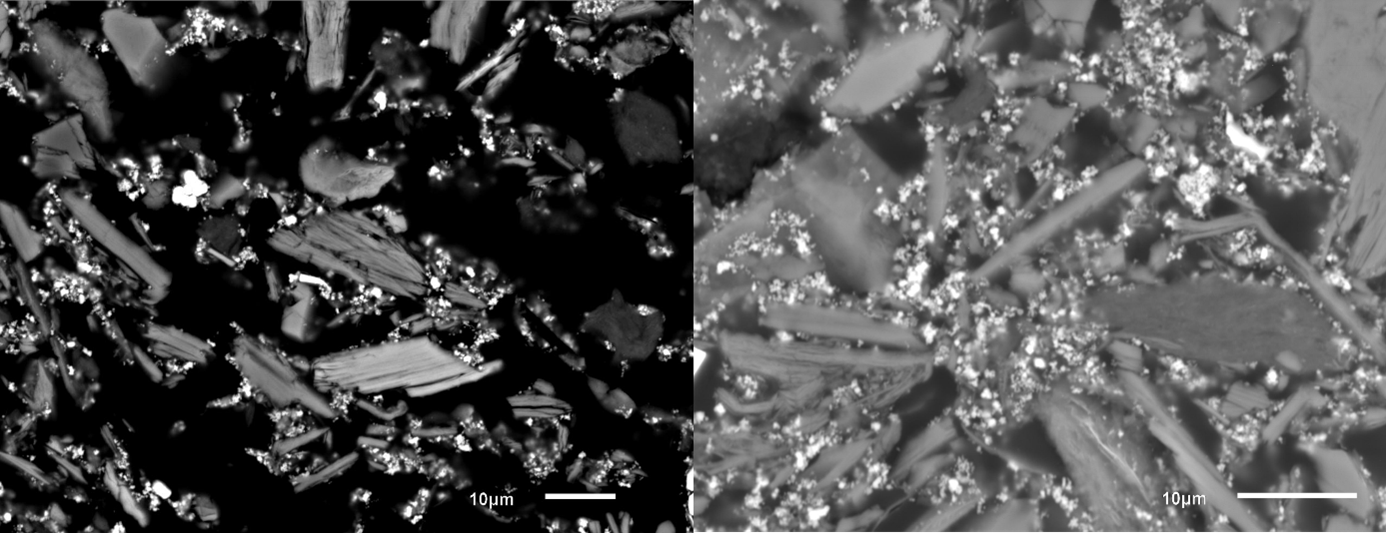
Figure 1: SEM images of two analogue samples with ~65% porosity (left) and ~35% porosity (right)
References
Lodders et al. (2009): 4.4 Abundances of the elements in the Solar System: Datasheet from Landolt-Börnstein - Group VI Astronomy and Astrophysics · Volume 4B: "Solar System" in SpringerMaterials. https://doi.org/10.1007/978-3-540-88055-4_34
Grott et al. (2019): Low thermal conductivity boulder with high porosity identified on C-type asteroid (162173) Ryugu. Nat Astron 3, 971–976 (2019). https://doi.org/10.1038/s41550-019-0832-x
Tachibana (2023): Mineralogy of Returned Sample from C-Type Near-Earth Asteroid (162173) Ryugu. In: Bindi, L., Cruciani, G. (eds) Celebrating the International Year of Mineralogy. Springer Mineralogy. Springer, Cham. https://doi.org/10.1007/978-3-031-28805-0_11
Metzger et al. (2019): Measuring the fidelity of asteroid regolith and cobble simulants. Icarus, Volume 321, 2019, Pages 632-646. https://doi.org/10.1016/j.icarus.2018.12.019
Kreuzig et al. (2023): Micrometre-sized ice particles for planetary science experiments – CoPhyLab cryogenic granular sample production and storage, RAS Techniques and Instruments, Volume 2, Issue 1, January 2023, Pages 686–694. https://doi.org/10.1093/rasti/rzad049
Gustafsson et al. (2024): Measurement of Thermal Transport in Solids with the Hot Disc Method. Int J Thermophys 45, 1 (2024). https://doi.org/10.1007/s10765-023-03284-1
Markides and Kourkoulis (2016): The influence of jaw's curvature on the results of the Brazilian disc test. Journal of Rock Mechanics and Geotechnical Engineering, Volume 8, Issue 2, 2016, Pages 127-146. https://doi.org/10.1016/j.jrmge.2015.09.008
Xiao et al. (2018): Mechanical Analysis of Unconfined Compression Test of Cylinder. Transportation Research Record, 2672(27), 37-44. https://doi.org/10.1177/0361198118791912
How to cite: Goldmann, M., Agrawal, B., Gundlach, B., Güttler, C., Patzek, M., Grott, M., and Greshake, A.: Thermal and mechanical properties of carbonaceous chondrite analogues, Europlanet Science Congress 2024, Berlin, Germany, 8–13 Sep 2024, EPSC2024-348, https://doi.org/10.5194/epsc2024-348, 2024.
After conducting our own experiments, we propose the platform we developed as a tool for other users. Designed for ultra low velocity impacts in granular beds simulating asteroid surfaces [1], the main requirement in platform design was a clean partial gravity generation without any coriolis forces. This is achieved by using a two stage approach: First, earth gravity is reduced to microgravity using the ZARM drop tower at Bremen. Second, microgravity is converted to the desired level of partial gravity. This is done by using a linear stage, driven at a constant acceleration inside of the drop tower capsule. The acceleration imposed by the moving experiment volume onto the drop tower capsule is supposed to be neglected, because of the vastly different inertial masses of approximately 2-3 kg for the experiment and several hundred kg for the drop tower capsule. As required for its original purpose, our platform is optimized for providing accelerations in the milligravity regime, but not limited to that. Partial gravities in the cm/s^2 regime were succesfully tested and our platform has also proven to be able to induce oscillations to agitate the experiment. Arbitrary trajectories are possible, respecting available microgravity time and the maximum travel of 30 cm.
In detail, we evaluate our platforms capabilities, performance and compliance. The drop tower provides 9.3 s of microgravity in catapult mode. Because of an initial equilibration time and the necessity to return our system to a safe resting position, our platform can forward a usable duration of approximately 7 s to the experiment. Expected values g-jitter, meaning the unwanted residual acceleration, lie in the range of 10^-6 g. Vacuum supply, power and remote control are supplied by ZARM until just before launch. The experiment can be made accessible after a delay after each launch. The capsules are compatible, so our system may be used in the Gravitower Bremen Pro as well.
[1] Joeris, K., Schönau, L., Keulen, M., Born, P., & Kollmer, J. E. (2022). The influence of Interparticle cohesion on rebounding slow impacts on rubble pile asteroids. npj Microgravity, 8(1), 36.
[2] Von Kampen, P., Kaczmarczik, U., & Rath, H. J. (2006). The new drop tower catapult system. Acta Astronautica, 59(1-5), 278-283.
How to cite: Joeris, K., Keulen, M., Teiser, J., and Kollmer, J.: Platform for Controlled Ultra Low Gravity Profiles, Europlanet Science Congress 2024, Berlin, Germany, 8–13 Sep 2024, EPSC2024-442, https://doi.org/10.5194/epsc2024-442, 2024.
Various bodies in the solar system such as the Moon, Mars and asteroids are recovered with fine and powdery regolith. The behavior of such materials remains poorly understood due to their granular nature in a low gravity environment. Being able to retrieve the mechanical properties of the surface helps to better predict the regolith behavior during space missions involving sampling, landing, or roving components interacting with the surface. One of the parameters of interest is the bearing capacity, which is the maximum force a surface can withstand before experiencing rupture (shear failure). In low-gravity conditions, cohesionless material is expected to be more readily fluidized and have lower strength [1; 2; 3; 4; 5]. Sinkage of an object is independent of the gravity for cohesionless material in a quasi-static regime [3; 6]. However, the expected behavior of cohesive materials is still poorly understood and under debate [7; 8; 9]. In a reduced gravity environment, the importance of cohesive forces is expected to increase (e.g. [10]).
To develop a better understanding of the role of cohesion in surface dynamics and estimate the bearing capacity, the sinkage experiment campaign named SILOE (Surface Investigation in Low gravity Environment) will be conducted in December 2024 in the GraviTower Bremen Pro at ZARM drop towers facility (Bremen, Germany) with the support of the ESA Academy Experiments programme – Drop Towers.
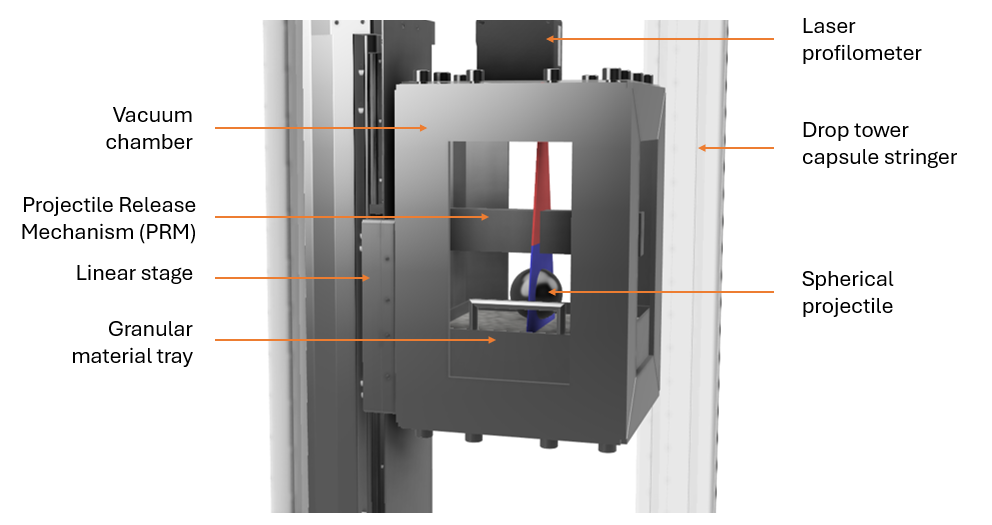
Figure 1: Preliminary design of the experimental set-up. The beam of the laser profilometer is represented with the red and blue area, with the blue zone being the visible and measurable zone.
The sinkage experiments will be conducted under vacuum at 10 Pa, which is sufficient to remove the interstitial air pockets and water molecules inside the granular medium [11]. The chamber is a box made of acrylic glass panels of the following dimensions: 0.2 x 0.2 x 0.3 m (l x w x h) (Fig. 1). Every trial will involve releasing a spherical projectile of 5 cm using an electromagnet mechanism. The release height above the surface will be very small and the projectile will collide with the surface with a very small velocity (< 0.4 m/s). The vertical displacement of the projectile will be measured using a laser profilometer and two high-speed cameras, placed on the top and side of the chamber.
The experiments will be performed at three different levels of gravity: Earth gravity, and at two reduced gravitational accelerations (10-1 and 100 m/s²) achieved by combining the GraviTower and a motorized linear stage. Five different granular materials with five different levels of cohesion (from ~ 0 to > 1000 N/m²) will be selected to focus on the role of cohesion depending on the gravitational acceleration. Other mechanical properties, such as the internal angle of friction, density, and grain size, will be selected to remain as constant as possible across the different materials.
The SILOE experiment objective is to determine and quantify the effect of cohesion on the bearing capacity for reduced gravity levels. The results are directly applicable for data interpretation of the upcoming JAXA MMX mission (in particular the IDEFIX rover [12]) and the ESA Hera mission [13; 14].
Acknowledgements:
This project is carried out with the support of the Education Office of the European Space Agency, under the educational Experiments Programme. This project also received funding from EUR TESS N°ANR-18-EURE-0018 in the framework of the Programme des Investissements d’Avenir, and the Bourse Espace 2024 scholarship by the Fondation Ailes de France. AD acknowledges PhD funding from University of Toulouse III, and CR acknowledges PhD funding from CNES and ISAE-SUPAERO. This project benefitted from funding from CNES, and from the French ANR Tremplin-ERC ‘GRAVITE’.
References:
[1] Murdoch et al. (2017), MNRAS. [2] Murdoch et al. (2021), MNRAS. [3] Sunday et al. (2022), A&A. [4] Walsh et al. (2022), Sci. Adv. [5] Arakawa et al. (2021), Science. [6] Kobayashi et al. (2010), J. Terramech. [7] Nagaashi et al. (2021), Icarus. [8] Nagaashi et al. (2023) Sci. Adv. [9] Schäfer et al. (2017), P&SS. [10] Scheeres et al. (2010), Icarus. [11] Brisset et al. (2018), Prog. Earth Planet. Sci. [12] Michel et al. (2022), Earth Planets Space. [13] Michel et al. (2022), Planet. Sci. J. [14] Bigot, Lombardo et al. (2024) Nat. Commun.
How to cite: Stankiewicz, M., Dghais, S., Duchêne, A., Bigot, J., Robin, C., Kollmer, J., and Murdoch, N.: SILOE: Bearing capacity experiments in low gravity, Europlanet Science Congress 2024, Berlin, Germany, 8–13 Sep 2024, EPSC2024-1184, https://doi.org/10.5194/epsc2024-1184, 2024.
Abstract
This study focuses on investigating the ability of water to carry out the mm-sized grains when exposed to low pressure environments in the attempt to help understand the depositional and erosional capacity of Martian streams (if they are present on today's Mars).
Introduction
Many edifices observed on Mars suggest that water once flowed over the martian surface and hence was present in the past (Figure 1) or might be still temporarily present even today [1-2]. However, as today’s Mars is a planet whose surface atmospheric pressure is ∼160 times weaker than that on Earth (~6 mbar vs. ~1000 mbar), water in a liquid phase cannot be present there for a prolonged period of time (e.g., [3]). This is because under such pressure, liquid water should boil, evaporate and eventually freeze due to the evaporative cooling (e.g., [4-5]).
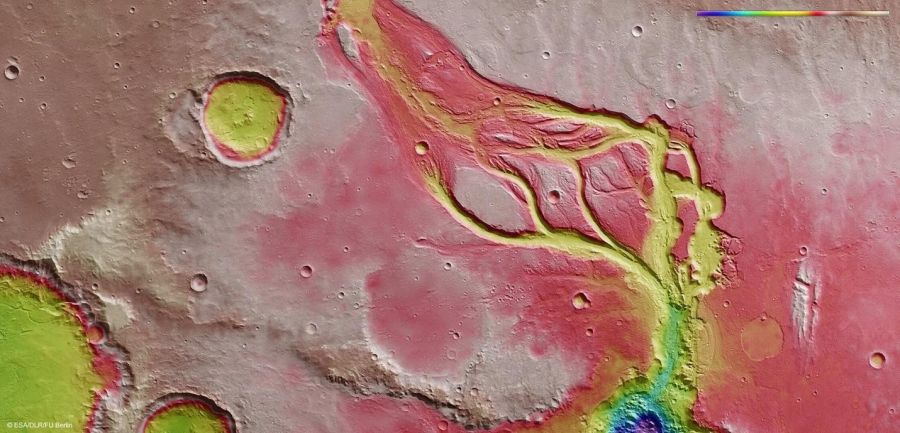
Figure 1: Central portion of Osuga Valles in false colors as seen by European probe Mars Express, which formed by movement of a large quantity of water in martian history. ESA/DLR/FU Berlin, CC BY-SA 3.0 IGO.
As the boiling of water would lead to the formation of large quantities of bubbles, we expected that this would affect its ability to carry out the sediments and hence to change the erosional as well as depositional capacity of water streams on Mars. We speculate that two scenarios are possible: a) the boiling water will have a greater ability to entrain sediment because the emerging bubbles will formed around sediment grains and will be able to lift them, or b) that the bubbles in the water will reduce the ability of the sediment to entrain due to a change in the density contrast between the water and sediment due to the rapid boiling of water.
Experimental setup
To find out which hypothesis is correct, we performed a set of 13 experiments using the Mars Simulation Chamber at the Open University (UK), in which we studied the ability of unstable liquid water to carry sediments under normal (1024 mbar) and reduced atmospheric pressures of 25 and 4.5 mbar respectively. To achieve that, we developed a dedicated experimental setup consisting of a steel container holding 500 ml of water with salinity of 0.5% (D.I. water mixed with NaCl salt), from which the liquid could be released to 1° inclined steel plate (Fig. 2). A gridded area of 60x100 cm was marked on the plate, into which 20 grams of 2-4 mm-sized calcite grains were emplaced before the start of the experiment, 10 cm from the start of the grid. The grains were spread out in a rectangular shape in a monolayer rectangle of size 20 x 3 cm. The chamber was then closed and when the required atmospheric pressure was reached (1024 mbar, 25 mbar and 4.5 mbar), the latch at the bottom of the container was released and the water drained to the steel plate. The experimental runs were recorded by cameras occupying the experiment from the top, side and front. This allowed further post-processing, including grain movement and distribution analysis by DIC and statistical methods.
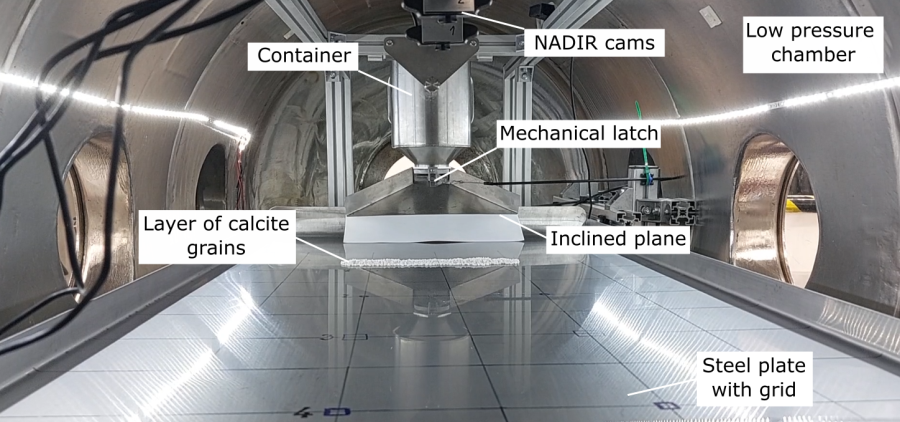
Figure 2: Image showing an experimental setup inside a low pressure chamber.
Results and discussion
Experiments conducted under normal pressure (1024 mbar) showed that most grains were able to get within 49-55 cm from the start of the grid (Fig. 3., Fig. 4a - blue points). In contrast, experiments conducted under reduced pressure of 25 mbar and 4.5 mbar showed that most grains only reached 38-50 cm (Fig. 3, Fig. 4a), respectively 37-49 cm (Fig. 3, Fig. 4a). In addition, with decreasing pressure, the grains were distributed along longer distances (typically 46 cm → 60 cm, black points) while the maximum reached distance by single grains was rather similar (Fig. 4a, green points).
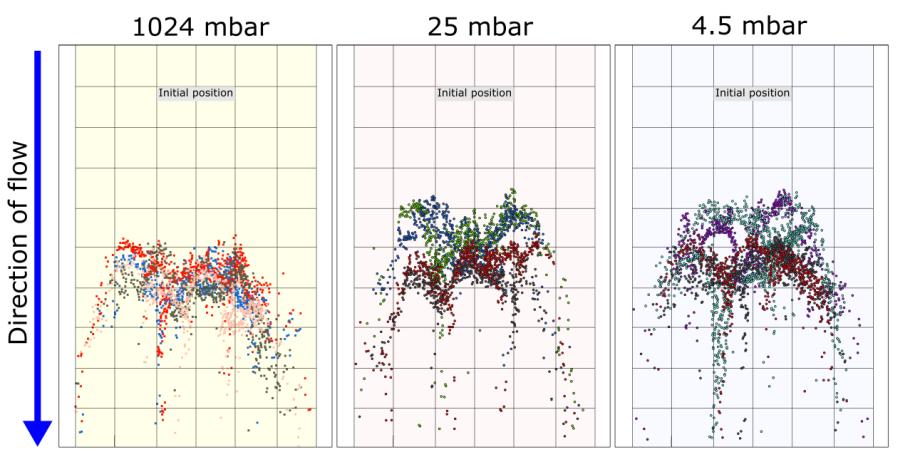
Fig. 3: Results of experimental runs performed for pressures of 1024 mbar (4 experiments), 25 mbar (4 experiments) and 4.5 mbar (5 experiments) where each point corresponds to the finite position of calcite grain. The initial position of grains is marked with a shadow rectangle.
To quantify differences in sediment transport under different pressures, we performed a statistical analysis, specifically analysis of variance and cluster analysis. Analysis of variance, performed on the distributed calcite grains (Fig. 4b) for both orthogonal directions, shows increasing longitudinal (~5.4×104 → ~7.8×104) and decreasing lateral (12×104 → ~11×104) variances, while their ratio is near similar at about 0.5 in average.
Fig. 4: Results of measured distances and analysis of variance.
Experiments show that water has a greater ability to entrain grains under normal pressure when water is stable. Once the pressure drops and the water begins to boil and a large quantity of water vapor is produced within the flow, the ability of unstable water to entrain grains then decreases and therefore grains do not travel to such distances as in the case of normal pressure. Grains are also more scattered under decreased pressure. Hence, our preliminary results suggest that despite the current lack of knowledge of how atmospheric pressure has evolved in the Amazonian period, but once the atmospheric pressure dropped below the point at which water is stable, there would be changes in the water's ability to carry sediment.
As a next step, we plan to investigate by numerical modeling how the different gravity on Mars affects this process. This parameter can still significantly affect how much unstable water can carry away sediment on the Red planet.
References
[1] McEwen et al. (2011), Science 333, 740-743, [2] McEwen et al. (2014), Nature Geoscience 7, 53-58, [3] Hecht (2002), Icarus, 156, 373–386 [4] Bargery et al. (2010), Icarus, 210(1), 488–506, [5] Brož et al. (2020). Nature Geoscience, 13(6), 403–407.
How to cite: Broz, P., Pěnkavová, V., Krýza, O., Zedníková, M., Havlica, J., Sylvest, M., and Patel, M.: Effect of water on grain entrainment at reduced atmospheric pressure, an insight from analogue experiments , Europlanet Science Congress 2024, Berlin, Germany, 8–13 Sep 2024, EPSC2024-143, https://doi.org/10.5194/epsc2024-143, 2024.
Introduction: When the MSL rover Curiosity landed on Mars in 2012, it successfully demonstrated the use of Laser-Induced Breakdown Spectroscopy (LIBS) for in-situ geochemical investigations of planetary bodies for the first time [1]. Since then, the importance of LIBS for Solar System exploration has only grown, with several subsequent missions employing LIBS systems as part of their sensor
suite [2, 3]. LIBS measurements are performed by focusing a pulsed laser beam on the surface of a sample to generate a local plasma. The emission of this plasma is then analyzed to investigate the sample composition. Since the lifetime, size and emission of the laser-induced plasma depend strongly on experimental parameters [4, 5], LIBS instruments for in-situ analysis of planetary bodies have to be designed for specific environments to generate high-quality data. Important parameters include the ambient atmosphere, the laser irradiance and the sample lithology
Here, we present measurements of the plasma emission at different atmospheric conditions and laser irradiances for four samples with different lithologies to aid in the development of new LIBS instruments for in-situ geochemical research of planetary bodies.
Experimental Setup: To investigate the lifetime, size and emission of laser-induced plasmas, we use a plasma imaging system that employs a gated ICCD sensor to achieve a temporal resolution of down to 2 ns. The ICCD is most sensitive between about 300 nm and 900 nm. The plasma is generated by a 1064 nm Nd:YAG laser with a pulse duration of 8.1 ns and a spot diameter of about 40 µm.
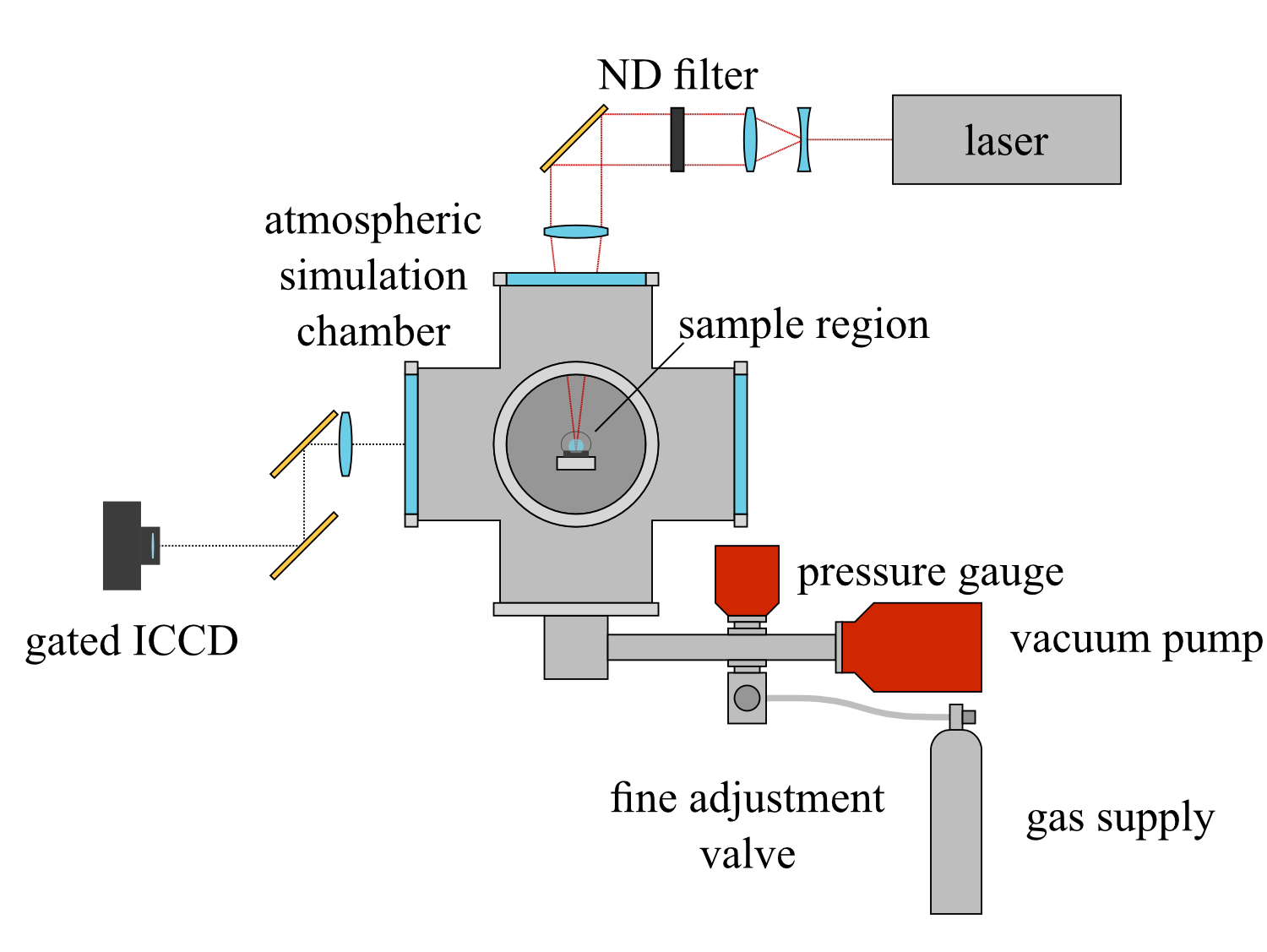
Figure 1: Overview of the experimental setup.
Different atmospheric conditions can be simulated using a vacuum chamber in which the plasma is ignited, see Fig. 1. In this study, we focus on atmospheric conditions on Earth, Mars and airless planetary bodies such as the Moon.
Methodology: For all investigated samples, measurements were performed at terrestrial, Martian and airless conditions. The laser pulse energy was varied between 11.86 mJ, 8.75 mJ and 6.56 mJ, which corresponds to average irradiances of about 1300 MW/mm², 990 MW/mm² and 750 MW/mm². Four samples with different lithologies were investigated: LMS1 (pressed pellet), LHS1 (pressed pellet), soapstone (talc) and basalt (cut rock). For this abstract, we limit the discussion to data from the basalt sample.
Each plasma image was recorded from a single laser shot with ICCD gate times between 2 ns and 200 ns. All images were pre-processed by subtracting a dark image, applying a uniform filter to reduce the noise level and removing residual constant offsets. The total plasma emission was calculated as the sum over each image. To account for the different ICCD gate times, the total emission of each image was normalized with the gate time. The lifetime of the plasma was computed as the time that covers 90 % of the total detected plasma emission. The full width at half maximum sizes of the plasmas were calculated as the largest horizontal distance between points that show half of the maximum plasma emission of the image.
Results: Fig. 2 shows the expansion of the plasma plume from the basalt sample at the three investigated
atmospheric conditions for a laser energy of 8.75 mJ. All plasma images are normalized to their respective maximum. At 100 ns after plasma ignition, two plasma plumes are visible for the measurement performed at terrestrial conditions. This secondary breakdown is likely initiated on residual ejecta from the ablation process.

Figure 2:Time series of plasma images at the three investigated atmospheric conditions. Each plasma image is normalized to its respective maximum signal. Note the different time scales.
Overall, a change in the extent of the plasma and its dynamics is visible between different atmospheric conditions. The plasma’s lifetime is longest at terrestrial atmospheric conditions and shortest at airless conditions. At terrestrial conditions, the plasma is most confined. It is larger at Martian atmospheric conditions and at airless conditions, the plasma extends freely into the vacuum, which leads to a small and bright plasma core close to the sample surface.
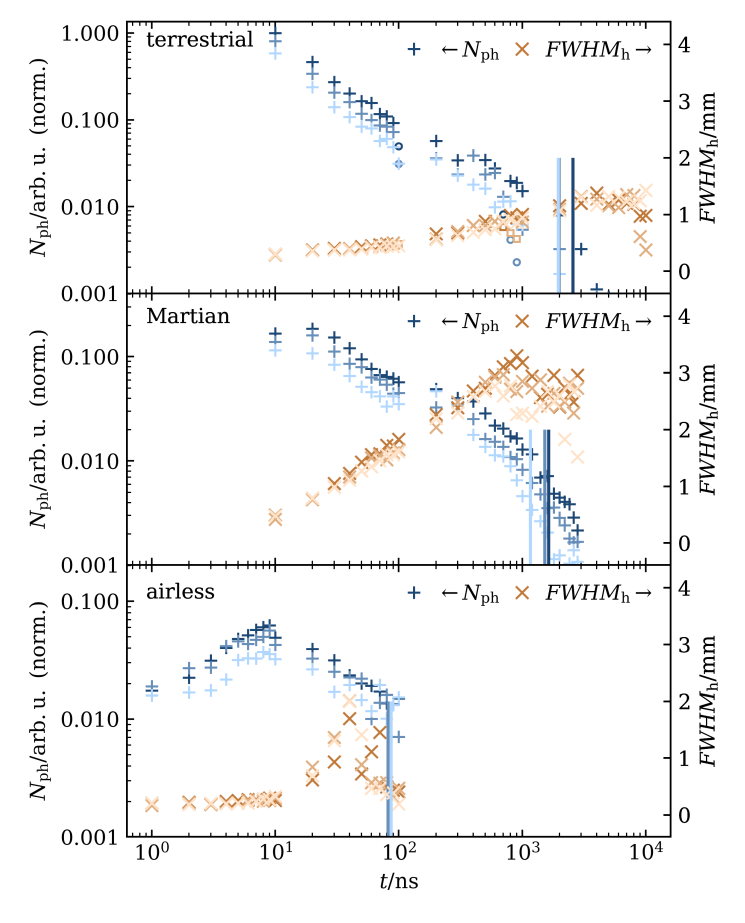
Figure 3: Comparison of the development of the total emitted plasma radiation, the plasma’s horizontal and the plasma lifetime.. Note the different scales of the y-axes.
In Fig. 3, the total emission of the plasma is compared for the three atmospheric conditions and laser energies. Fainter colors represent lower laser energy. The data is normalized to the strongest emission at terrestrial conditions. The vertical lines represent the computed plasma lifetime. On the secondary y-axis, the is plotted. At terrestrial atmospheric conditions, the plasma is brightest at 10 ns after plasma ignition. The plasma reaches its maximum horizontal extend of about 1.3 mm around 3 µs after ignition. 90 % of the emission are contained within the first 2.5 µs. For Martian conditions, the peak emission occurs after about 20 ns and is about 20 % of the peak emission at terrestrial conditions. The plasma lifetime is reduced to about 1.5 µs and its maximum extend of about 3 mm is reached around 500 ns after ignition. Finally, for airless conditions the peak plasma emission is reduced to about 7% of the peak emission at terrestrial conditions with a lifetime of about 80 ns. The plasma reaches its maximum extent of about 2 mm after around 40 ns.
Conclusion: The presented data show the different behaviors of plasmas ignited at different atmospheric conditions. The maximum extent varies between about 1.3 mm for terrestrial conditions, 3 mm for Martian conditions and 2 mm for airless conditions. The plasma is brightest at Terrestrial atmospheric conditions. At Martian and airless conditions, the plasma’s peak emission is about 20% and 7% of that at terrestrial conditions, respectively. Part of this work was first presented at the 55th LPSC conference [6].
References: [1] Maurice, S. et al. (2016) J. Anal. At. Spectrom., 31(4), 863-889. [2] Maurice, S. et al. (2021) Space Sci. Rev., 217, 1-108. [3] Wan, X. (2021) At. Spectrosc., 42(6), 294-298. [4] Singh, J. P. and Thakur, S. N. (Eds.). (2020). Laser-induced breakdown spectroscopy. Elsevier. [5] Lasue, J. et al. (2012) J. Geophys. Res. Planets, 117, (E1). [6] Seel, F. et al. (2024) 55th LPSC, 1418.
How to cite: Seel, F., Schröder, S., Clavé, E., Dietz, E., Frohmann, S., Hansen, P. B., Rammelkamp, K., and Hübers, H.-W.: Evolution of Laser-Induced Plasmas for In-Situ Analysis on Planetary Bodies, Europlanet Science Congress 2024, Berlin, Germany, 8–13 Sep 2024, EPSC2024-232, https://doi.org/10.5194/epsc2024-232, 2024.
Introduction
The PASLAB laboratory has been created to simulate the current or previous atmospheric conditions on Mars or Earth. The focus lies on astrobiology experiments, sensor calibration and sensor development, e.g. [1, 2]. Measurements typically run from one day to several weeks or months. In the framework of astrobiological experiments, investigations have been carried out into the survivability of lichens e.g. [3, 4], cyanobacteria [5] and fungi [6] under Martian-like conditions. In sensor experiments the focus is on the development of trace humidity sensors and the calibration of humidity sensors under conditions ranging from terrestrial to the harsh conditions of Mars. This contribution will present an overview of the laboratory’s capabilities and recent successes with a view to generating new and interesting collaborations with external scientists.
PASLAB overview
The laboratory consists of two sections: a section for handling biological samples and a section with experimental setups for exposure under extreme conditions as well as sensor investigations and calibration. Figure 1 shows images of key parts of these setups. For the growth of biological cultures there are two compressor cooled incubators (VWR IL 68R), which can be run at different temperatures optimized for different life forms. A laminar flow box allows samples and cultures to be prepared under sterile conditions. An anaerobic workstation (Whitley A85 TG) is used for sample culture and preparation, as well as storage, in an oxygen-free environment. For initial characterization and processing of samples the laboratory has an imaging PAM (Walz IMAG K5) for fluorescence measurement, a UV/Visible Spectrophotometer (JENWAY 6305), a thermal cycler (Kisker-Biotech 3PRIMEX 48), and a high-speed centrifuge (Eppendorf 5430R).
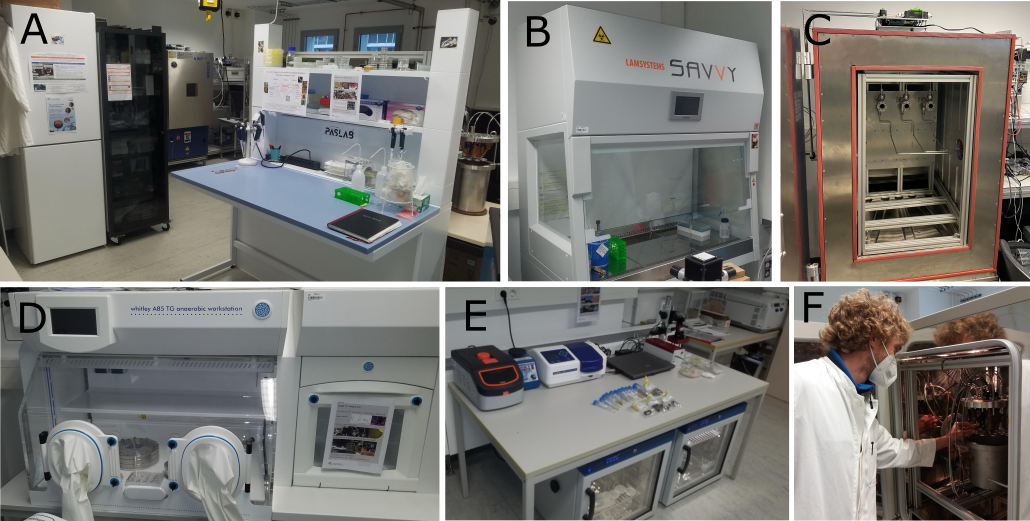
Figure 1: An overview of the laboratory. A: Biological sample preparation bench. B: Laminar flow box. C: Environmental chamber set up for sensor investigations. D: Anaerobic workstation. E: Incubators and sample preparation and analysis equipment. F: Mars chamber
The exposure and sensor investigation section of the laboratory consists of three separate setups based around three climate chambers: ATT 340TC (-72°C to 180°C), KWP 240 (-75°C to 130°C) and VT 4002 (- 40°C to 130°C). Each chamber has a dedicated gas mixing system using mass flow controllers to generate gas compositions. Available gases are currently N2, CO2, H2, O2, CH4 and Ar. A gas humidification system is used to set the humidity of a matrix gas in a stepless way from -80°C to 10°C frost point (0,5 ppmV to 12000 ppmV) with a precision of better than ±0.1°C FP. Three dew point mirrors (MBW 373LX, Michell S8000 RS and Michell S8000 integrale) dedicated to each setup are used to measure the humidity of the generated gas flows as a control. A schematic diagram of the setup applied to sensor investigations is shown in Figure 2.
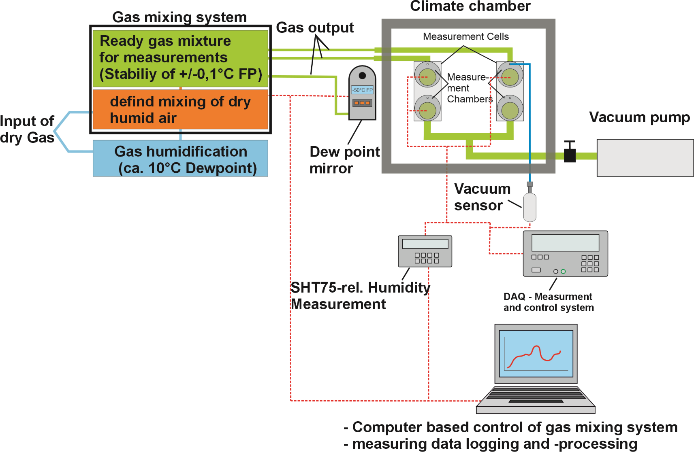
Figure 2: Schematic diagram of an experiment system for sensor test and calibration
For the exposure of biological samples to Martian conditions, an experimental chamber has been developed, shown in Figure 3. The chamber has a volume of 10.3 L, inner diameter of 20 cm and height of 32 cm. The gas inlet is connected to a gas mixing system and the outlet is connecting to a vacuum pump. A rotating sample holder carousel contains positions for up to eight 35mm petri dishes. Fiber optic cables transmit light from a 150W Xenon lamp and illuminate 4 of the sample positions. Two Sensirion SHT-75 relative humidity sensors and two Pt100 temperature sensors log the environmental conditions in the chamber during experiments. The photosynthetic yield of each sample can be measured in real-time during experiments with a Mini-PAM photosynthetic yield analyser (Walz GmbH) by rotating the sample carousel. System control and data acquisition is achieved using a National Instruments system and Labview software, allowing full automation of experimental runs. A trace gas analyser mass spectrometer (Pfeiffer Vacuum HPA 220 M2) is being integrated with the setup to monitor variation of gas composition in real time.
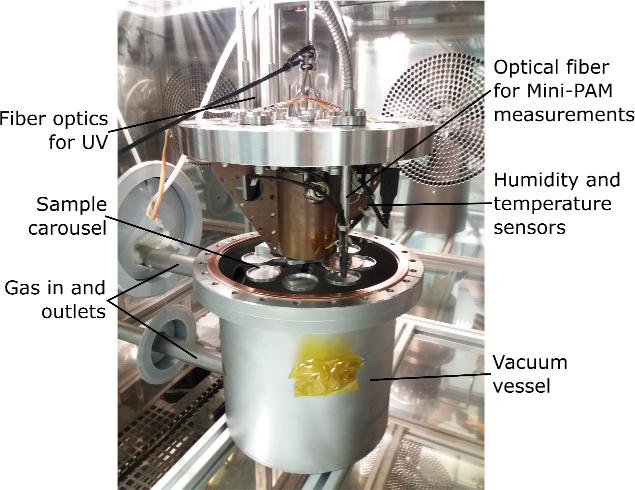
Figure 3: The Mars simulation chamber open, showing the sample positions.
The parameters pressure, temperature, humidity, light ON/OFF, gas mixture and flow are computer controlled and can be changed during the experiment. In general, it is possible to simulate a variety of conditions from Martian to terrestrial, as well as other conditions with cyclical variation over weeks or months.
Figure 4 shows a Typical run of an exposure experiment and figure 5 for a sensor experiment (see image C in figure 1).
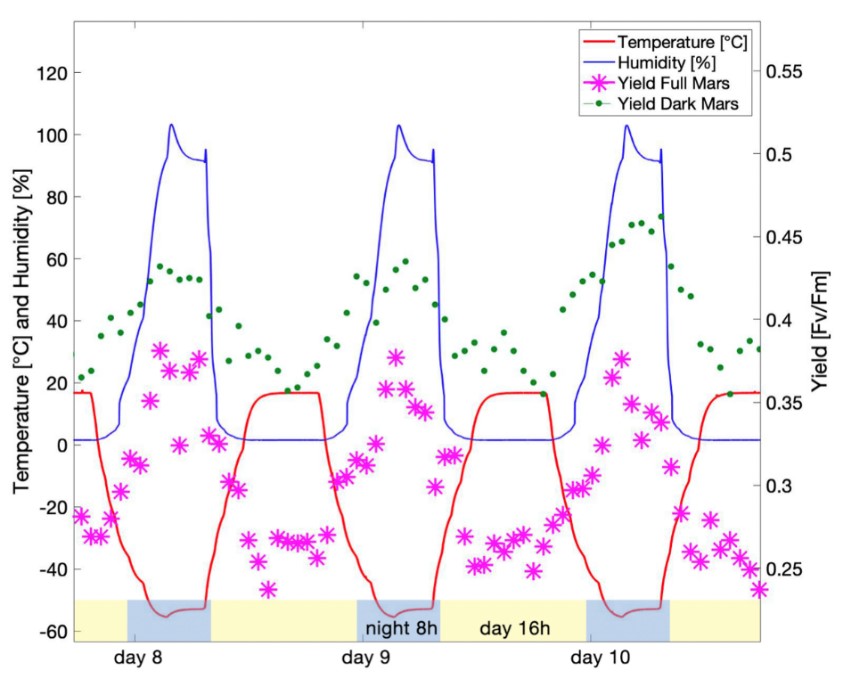
Figure 4: Detail of the day-night cycles of the simulated Mars conditions (temperature, red thick line; humidity, blue thin line) and fluorescence variation values for both the treatments (FM and DM) [4].
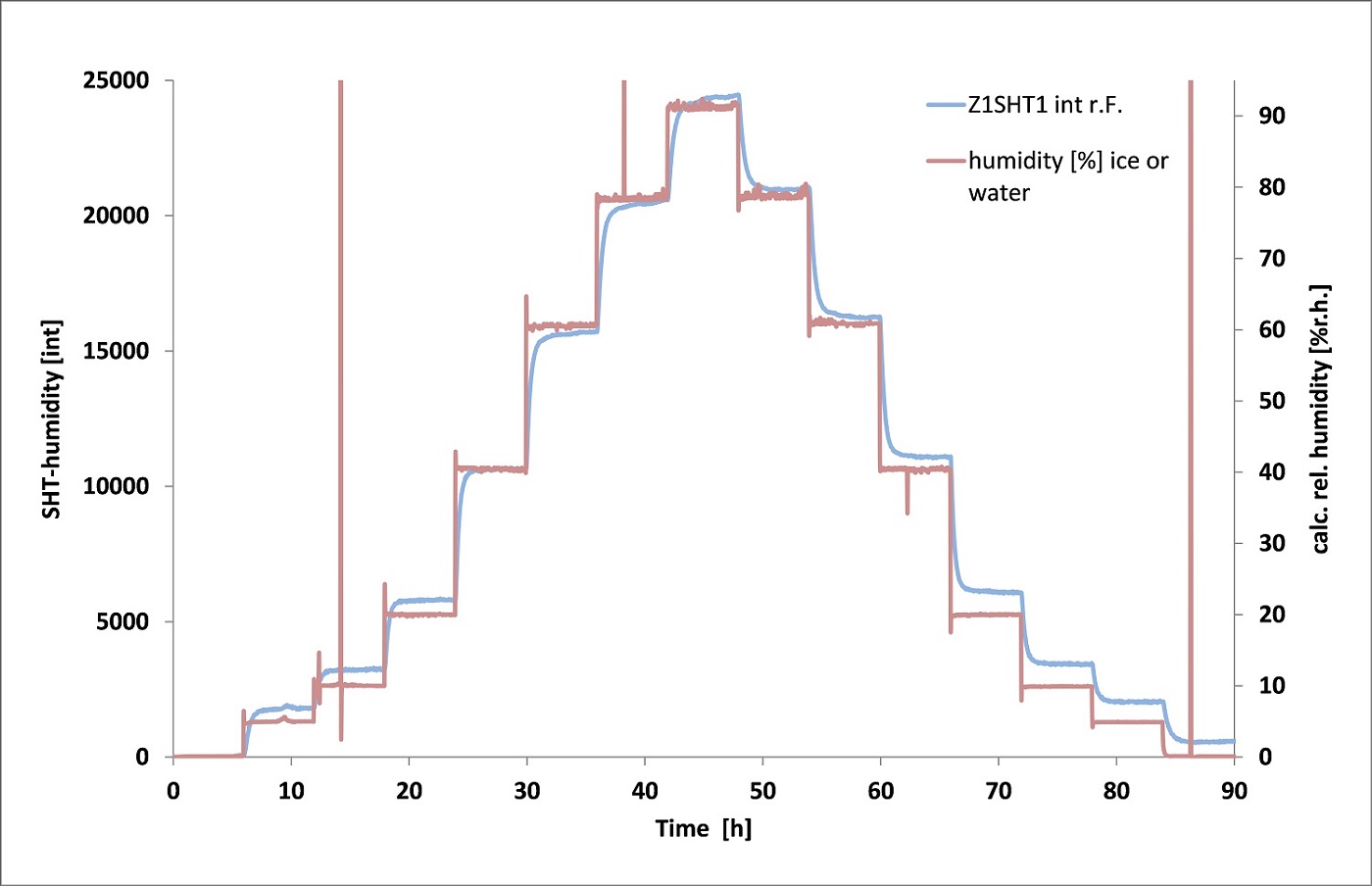
Figure 5: An example calibration run is show opposite. T = -60 °C, P = 8 mbar, Frost point (reference measurement at atmospheric pressure) between -45 to -20 °C
Summary
The experimental capabilities of PASLAB focus on questions relating to habitability and the search for life as well as humidity sensors development and calibration, a topic which is closely related to biological investigations. The three environmental chambers and dedicated gas mixing systems allow simultaneous measurements under different conditions and for different purposes. The systems allow the gas humidity to be precisely set over a wide range of temperatures and pressures and full experiment automation allows long runs of up to several months.
References: [1] Hieta, M. et al. (2022) Planetary and Space Science 223 105590. [2] Lorek, A. (2014) J. Sens. Sens. Syst., 3, 177–185. [3] Noetzel de la T. et al. (2018) Front. Microbiol. 9:308. [4] Lorenz, C. et al. (2023) Sci Rep 13, 4893. [5] de Vera, J-P et al. (2014) International Journal of Astrobiology 13(1):35-44. [6] Zakharova, K. et al. (2014) Sci Rep 4, 5114.
How to cite: Lorek, A., Garland, S. P., Baqué, M., and Helbert, J.: The Planetary Analog Simulation Laboratory (PASLAB), Europlanet Science Congress 2024, Berlin, Germany, 8–13 Sep 2024, EPSC2024-720, https://doi.org/10.5194/epsc2024-720, 2024.
Abstract
We present the experimental phase function (PF) and degree of linear polarization (DLP) curves of large grains. We focus on selected pieces of meteorite FRO01093, a L6 chondrite that is a good representative of the dust material in the Didymos – Dimorphos binary system, target of the HERA mission. In the era of space missions and vast amounts of observational data, the need for laboratory studies, developed in a controlled environment is crucial to interpret the data.
Introduction
Hera is a planetary defence ESA mission with the objective to investigate the Didymos binary asteroid, after the NASA's DART mission kinetic impactor test [1]. One of the main scientific goals of the mission consist of the study and characterization of the loose fragments possibly put in orbit, transient or stable, by the impact.
In this framework, the photopolarimetric study of dust grains provides a valuable benchmark to the data obtained by the in-situ measurements.
Measurements
Here we present the PF and DLP curves for a selected set of mm-sized grains representative for the fragments in orbit at the Didymos system. The grains are obtained from the meteorite FRO01093, a L6 chondrite that is a good representative of the dust ejecta in the Didymos – Dimorphos binary system, target of the HERA mission. FRO01093 is a fresh, fusion crusted L6 ordinary chondrite find in Antartica of about 22 g. It has been donated by the Museo Nazionale dell’Antartide, Italy. It exhibits a granoblastic textures, with grains of about 200 µm, and consists mainly of olivine and orthopyroxene. The meteorite has been grinded to produce grains of millimeters belonging to different part of the primary matrix. Figures 1 and 2 show the meteorite and a mm-sized grain obtained from it, respectively.
The measurements have been taken at the IAA Cosmic Dust Laboratory (CODULAB) [2], depicted in Figure 3. CODULAB has provided a large number of experimental scattering matrices of cosmic dust analogues, all collected in the Granada-Amsterdam light scattering database scattering.iaa.es [3]. It can operate with different setups, to measure clouds of micron-sized particles, single mm-sized grains or surfaces [e.g., 4,5,6]. In this work the grain of interest is located at the scattering volume by means of an ultrasonic levitator [7]. The measured PF and DLP curves are performed at 640 nm spanning from 4 to 177 degrees scattering angle range.
In this work, we present the PF and DLP curves for the meteorite fragments. This is part of an ongoing project in which we plan to study the phase function and degree of linear polarization of the meteorites with different geometry in order to simulate the cometary coma and the asteroidal ejecta that HERA mission will be able to detect.
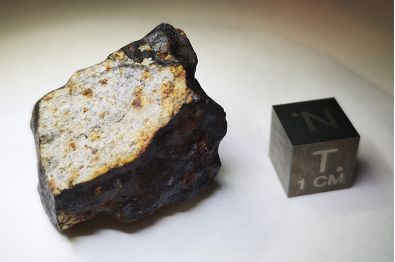
Figure 1. FRO01093 meteorite
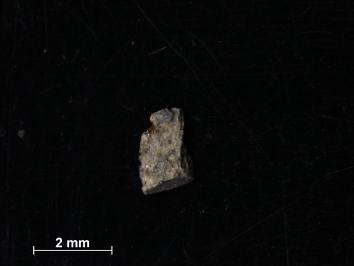
Figure 2. A mm-sized grains obtained from the FRO01093 meteorite.
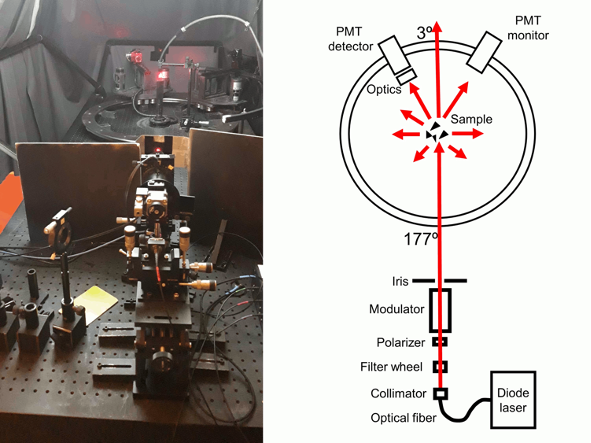
Figure 3. The CODULAB.
Acknowledgements
This work has been supported by the grant PID2021-123370OB-I00 (CATS) funded by MCIN/AEI/10.13039/501100011033, the European Union NextGenerationEU/PTR, and the Italian Space Agency (ASI) within the HERA project (ASI-UniBO agreement A.A. n. 2022-8-HH.0). We thank the Museo Nazionale dell’Antartide, Italy, for the donation of the FRO 01093 meteorite sample, beloning to the Programma Nazionale delle Ricerche in Antartide (PNRA) collection.
References
[1] Michel P. et al., The ESA Hera Mission: Detailed Characterization of the DART Impact Outcome and of the Binary Asteroid (65803) Didymos. PSJ, Vol.3, p.160, 2022.
[2] Muñoz et al., The IAA cosmic dust laboratory: Experimental scattering matrices of clay particles. Icarus, Vol. 211, pp. 894-900, 2011.
[3] Muñoz et al., The Amsterdam-Granada Light Scattering Database, JQSRT, Vol.113, pp. 565-574, 2012.
[4] Gómez-Martín et al., On the application of scattering matrix measurements to detection
and identification of major types of airborne aerosol particles: Volcanic ash, desert dust and pollen JQSRT, Vol.271, 2021.
[5] Muñoz et al., Retrieving Dust Grain Sizes from Photopolarimetry: An Experimental Approach. ApJS, Vol. 256, pp.17, 2021.
[6] Frattin et al., Experimental phase function and degree of linear polarization curve of olivine and spinel and the origin of the Barbarian polarization behaviour. MNRAS, Vol. 517, pp. 5463-5472, 2022.
[7] Colin et al., An acoustic levitator for use in light scattering experiments at the IAA Cosmic Dust Laboratory. in prep
How to cite: Frattin, E., García Izquierdo, F. J., Salari, G., Folco, L., Bertini, I., Martikainen, J., Gómez Martín, J. C., Amoroso, M., Ammannito, E., Moreno, F., and Muñoz, O.: Photopolarimetry of large compact dust grains in preparation for the HERA mission , Europlanet Science Congress 2024, Berlin, Germany, 8–13 Sep 2024, EPSC2024-794, https://doi.org/10.5194/epsc2024-794, 2024.
Introduction: Sample return is an on-going priority for the planetary science community. The Perseverance rover is currently caching samples from Jezero crater for potential return to Earth to be studied in terrestrial laboratories. Samples returned for study in a fully equipped terrestrial laboratory provide unprecedented opportunity to analyse Martian rocks for biosignatures and paleoenvironmental markers in the search and characterization of ancient habitability and life.
Before samples are brought back to Earth for laboratory analysis, it is necessary to establish a clear framework for sample selection and analysis. Tremendous strides in proxy development have opened windows to reconstructing past microbial ecology, pH, and alkalinity on Earth. Ultimately, we hope to extend these advances to Martian samples; however, such efforts require a new generation of paleo-proxy validation and calibration in suitable terrestrial analogues. In this study, we combine stable isotope and lipid biomarker analysis within a well constrained basin and climate system in the Eocene Green River Formation (GRF), USA.
The Green River Formation: Alkaline lakes are a prime target for astrobiological exploration as they are among the most biologically productive ecosystems on Earth. The paleolakes that formed the GRF may have reached pH values of up to 11 [1]. Further, paleolake evolution can be linked to the rise and decline of the Early Eocene Climatic Optimum (EECO), around 52.6-50.1 Ma [2], thus establishing a link between global climate and regional environments with possible relevance to interpretations of ancient Mars. Post the hyperthermal regime, the lake basin was increasingly restricted and gradually infilled, becoming more hypersaline as the lakes shallowed.
Proxies: This project explores the expression of each climatic phase of lake evolution through environmental proxies. We use 1) δ15N values as a proxy for pH, 2) lipid δ2H and carbonate δ13C and δ18O as a proxies for salinity, 3) the gammacerane index to determine the extent of water-column stratification, and 4) the pristane/phytane ratio (Pr/Ph) as a proxy for redox conditions.
The relative abundance of ammonium (NH4+) and ammonia (NH3) is highly pH dependent. Ammonium is stable at circumneutral pH, whereas ammonia is unstable at pH < 8 [3]. Lighter 14N preferentially enters volatile NH3, permitting it to be favourably removed from a high-pH aqueous system through degassing, which is accelerated as salinity increases. Therefore, a trend of increasing δ15N enrichment in the rock record is interpreted as a proxy for rising pH, and vice-versa.
Methods: The Utah Geological Survey provided core samples from the wells PR 15-7C and Skyline 16. Rock samples were powdered for isotope and biomarker analysis. Carbonate δ18O and δ13C were measured through a CNSOH isotope ratio analyser. δ15N and organic δ13C were measured using isotope ratio mass spectrometry at the University of St. Andrews. Total lipid extracts were extracted from rock powder using an accelerated solvent extractor. The extracts were run through silica gel columns to separate hydrocarbon fractions using solvents of varying polarities. Pristane, phytane and gammacerane were then identified, and their peaks measured through gas chromatograph-mass spectroscopy.
Results and Discussion: Before and during the EECO, the GRF in the eastern Uinta Basin was characterized by high energy fluvio-deltaic facies. The isotope record shows two cycles of rising and falling δ15N, interpreted as fluctuating pH levels. The presence of gammacerane implies a stratified water-column, supported by low Pr/Ph values. After the peak EECO hyperthermal regime, Lake Uinta deepened and became more alkaline and reducing, as shown by higher δ15N and lower Pr/Ph.
The δ13Ccarb, δ18Ocarb, and δ2H records correlate with one another, strengthening their use as evaporation and salinity proxies; however, principal component analysis shows no correlation with δ15N. This lack of relationship may indicate either a decoupling of salinity from pH during this time of fluctuating lake properties or second-order biogeochemical controls on these proxies. The possibility of decoupling pH from salinity and total alkalinity from samples returned from Martian paleolakes will support more accurate environmental interpretations and specifically climate models that may help us understand early Mars habitability. For example, high pH (suggested by high δ15N values) place upper limits on pCO2, while circumneutral pH coupled with high alkalinity (via rock weathering) would suggest that high atmospheric pCO2 was acting as a buffer [4]. Further work is directed at disentangling these complexities and optimizing the utility of stable isotopes as paleoenvironmental indicators.
Conclusions: δ15N can be used as a proxy for pH in ancient rock settings. When used with proxies for salinity — e.g., lipid δ2H, δ13C, and δ18O — the data can be used to coupling/decoupling between pH and alkalinity and salinity during climate-driven change in lake conditions. When applied to returned samples from Mars, more comprehensive interpretations of the poorly known atmospheric pCO2 conditions at the time of lake sedimentation should be possible.
Future Work: Our future work will explore boron isotope measurements of GRF samples as a complement to C, O, H, and N. Boron is used as a proxy for past oceanic pH through the isotopic fractionation between boric acid B(OH)3 and borate B(OH)4- and is underexplored as a proxy for modern and ancient saline lacustrine environments.
References:
[1] Tuttle, M. L., & Goldhaber, M. B. (1993). Sedimentary sulfur geochemistry of the Paleogene Green River Formation, western USA: Implications for interpreting depositional and diagenetic processes in saline alkaline lakes. Geochimica et Cosmochimica Acta, 57, 3023–3039.
[2] Birgenheier, L. P., Vanden Berg, M., Plink-Björklund, P., Gall, R. D., Rosencrans, E., Rosenberg, M. J., Toms, L. C., & Morris, J. (2019). Climate impact on fluvial-lake system evolution, Eocene Green River Formation, Uinta Basin, Utah, USA. GSA Bulletin, 132(3–4), 562–587.https://doi.org/10.1130/B31808.1
[3] Li, L., Lollar, B. S., Li, H., Wortmann, U. G., & Lacrampe-Couloume, G. (2012). Ammonium stability and nitrogen isotope fractionations for NH4+-NH 3(aq)-NH 3(gas) systems at 20-70°C and pH of 2-13: Applications to habitability and nitrogen cycling in low-temperature hydrothermal systems. Geochimica et Cosmochimica Acta, 84. https://doi.org/10.1016/j.gca.2012.01.040
[4] Stüeken, E. E., Tino, C., Arp, G., Jung, D., & Lyons, T. W. (2020). Nitrogen isotope ratios trace high-pH conditions in a terrestrial Mars analog site. Science Advances, 6(9). https://doi.org/10.1126/sciadv.aay3440
How to cite: Harrington, E., Whiteside, J., Bray, S., Stüeken, E., Stanton, E., Elson, A., Tino, C., and Lyons, T.: Environmental Proxies for Future Mars Sample Return: Novel Terrestrial Analogues in Alkaline Lakes, Europlanet Science Congress 2024, Berlin, Germany, 8–13 Sep 2024, EPSC2024-1050, https://doi.org/10.5194/epsc2024-1050, 2024.
Rationale
Silicate glasses are significant components of volcanic products, but spectral libraries typically provide references of crystalline materials rather than amorphous ones, even if blurred/featureless spectra are observed on planetary terrains. Thus, the Petro-Volcanology Research Group (PVRG) started an investigation of the spectral response of silicate glasses developing a database, to distribute spectral data applying the FAIR (Findable, Accessible, Interoperable, Reusable) principles [1]. We have analyzed these spectra using PCA and, in particular, we focused on MIR range, in which information about silicates’ arrangement in the material is detectable [2].
Fig. 1: a) TAS diagram of all products. Circles:sub-alkaline , triangles: alkaline. b) spectra of the entire dataset
Methodology
The investigated datasets consist of MIR spectra of 20 powdered silicate glasses (<36 µm grain size) whose composition that varies greatly within TAS diagram (Fig. 1a). Spectra of silicate glasses within this range present various features, as described in [2] and depicted in Figure 1b: we can observe Christian feature (local negative at ca. 7-8 µm, hereon CF), Reststrahlen Band peak (local maximum at ca. 9-10 µm, hereon RBpeak) and transparency feature (local maximum at ca. 11.5 µm, hereon TF). CF and RBpeak depend on the chemical-structural properties of the material, whereas TF depends on the granulometry of the investigated product and it is particularly prominent for ultra-fine powders.
Fig. 2: The columns contain the process summary results for each dataset, see main text for explanation.
Steps of data analyses are shown in Figure 2 and are as follows:
I) Starting datasets
For the principal component analysis, we considered four different starting datasets: spectra were considered between 8.17 µm, which is the highest CF among the set, and 12 µm (Full dataset in Fig. 2) and between ca 8.17 µm and 10.5 µm (Cut dataset in Fig. 2) this distinction was made to observe the influence of TF for such parameterization. Both datasets were investigated as raw spectra and as smoothed spectra (30 points adjacent averaging technique)
II) Normalization
Each dataset was normalized from 0 (lowest reflectance) to 1 (highest reflectance) through the formula Snorm=[S-min(S)]/[max(S)-min(S)]. This decision was taken after several try-and-fail approaches which revealed that this simple normalization leads to promising results.
III) PCA Loadings
Regarding the full dataset, PC1 is in general in anticorrelation with the normalized reflectance values, while the PC2 is divided into a first part of the spectra that is in anticorrelation with the PC score (up to ~10.5 µm) and a second part of the spectra that correlates positively with the score (from ~10.5 to 12 µm).
Regarding the cut dataset, the general shape of the loadings is similar to the one of the full dataset: PC1 is in general anticorrelation with the score except RBpeak, and PC2 is in general anticorrelation up to ~10.1 µm and then the correlation factor starts to grow.
- PCA score plots
On the full dataset the smoothing has the effect to better distinguish samples with PC1 < 0 and to map the rhyolitic samples to have similar PC1 scores, while leaving the PC2 scores almost unaffected. On the contrary, for the cut dataset the smoothing seems to affect the PC2 scores more than the PC1’s: the basaltic samples are mapped closer together after the smoothing and also the rhyolitic ones possess closer PC2 scores. On the other hand, the main difference between the cut and full datasets (either smoothed or not) seems to lay in the better distribution of samples for the cut one, having the basalt samples more separated from the rest and the rhyolitic samples nearer to each other, as well as a general better distribution of all the other samples in between.
Conclusions and perspectives
Firstly, it is important to assess that for each dataset the total variance explained by the PCA is significantly greater than 90 %, with the notable exception of the full non-smooth dataset that is just above it. Therefore, we assess the efficiency of the model at representing the data, especially regarding the cut and smoothed dataset that reaches up to ~97% of the total explained variance.
Secondly in general it is important to notice how the SiO2 content trend is well reflected by the PC1 scores, especially in the case of the cut and smooth dataset, for which it is clearly visible (see figure 2, row 4, image 4). Always regarding this specific case, the PC2 seems to be, at least partially, in anticorrelation with respect to the Na2O+K2O content, with basalts that have the highest PC2 values, thus giving promising preliminary results.
References
1. Pisello A., EPSC 2022, doi.org/10.5194/epsc2022-539
2. Pisello A., Icarus 2022, 388, 115222, doi:10.1016/J.ICARUS.2022.115222.
How to cite: Baroni, M., Pisello, A., Petrelli, M., and Perugini, D.: Dimensionality reduction on MIR spectra of powdered silicate glasses as analogues for volcanic ashes, Europlanet Science Congress 2024, Berlin, Germany, 8–13 Sep 2024, EPSC2024-1299, https://doi.org/10.5194/epsc2024-1299, 2024.
Please decide on your access
Please use the buttons below to download the supplementary material or to visit the external website where the presentation is linked. Regarding the external link, please note that Copernicus Meetings cannot accept any liability for the content and the website you will visit.
Forward to presentation link
You are going to open an external link to the presentation as indicated by the authors. Copernicus Meetings cannot accept any liability for the content and the website you will visit.
We are sorry, but presentations are only available for users who registered for the conference. Thank you.
Please decide on your access
Please use the buttons below to download the supplementary material or to visit the external website where the presentation is linked. Regarding the external link, please note that Copernicus Meetings cannot accept any liability for the content and the website you will visit.
Forward to session asset
You are going to open an external link to the asset as indicated by the session. Copernicus Meetings cannot accept any liability for the content and the website you will visit.
We are sorry, but presentations are only available for users who registered for the conference. Thank you.